- Add an image
- Draft and add content
- Rewrite text
- Chat with Copilot
- Create a summary
- Copilot in Word on mobile devices
- Create a new presentation
- Add a slide or image
- Summarize your presentation
- Organize your presentation
- Use your organization's branding
- Copilot in PowerPoint for mobile devices
- Draft an Outlook email message
- Summarize an email thread
- Suggested drafts in Outlook
- Email coaching
- Get started with Copilot in Excel
- Identify insights
- Highlight, sort, and filter your data
- Generate formula columns
- Summarize your OneNote notes
- Create a to-do list and tasks
- Create project plans in OneNote


Create a new presentation with Copilot in PowerPoint
Note: This feature is available to customers with a Copilot for Microsoft 365 license or Copilot Pro license.
Create a new presentation in PowerPoint.

Select Send . Copilot will draft a presentation for you!
Edit the presentation to suit your needs, ask Copilot to add a slide , or start over with a new presentation and refine your prompt to include more specifics. For example, "Create a presentation about hybrid meeting best practices that includes examples for team building.”
Create a presentation with a template
Note: This feature is only available to customers with a Copilot for Microsoft 365 (work) license. It is not currently available to customers with a Copilot Pro (home) license.
Copilot can use your existing themes and templates to create a presentation. Learn more about making your presentations look great with Copilot in PowerPoint .

Enter your prompt or select Create presentation from file to create a first draft of your presentation using your theme or template.

Edit the presentation to suit your needs, ask Copilot to add a slide , organize your presentation, or add images.
Create a presentation from a file with Copilot
Note: This feature is only available to customers with a Copilot for Microsoft 365 (work) license. It is not currently available to customers with a Copilot Pro (home) license.

With Copilot in PowerPoint, you can create a presentation from an existing Word document. Point Copilot in PowerPoint to your Word document, and it will generate slides, apply layouts, create speaker notes, and choose a theme for you.

Select the Word document you want from the picker that appears. If you don't see the document you want, start typing any part of the filename to search for it.
Note: If the file picker doesn't appear type a front slash (/) to cause it to pop up.
Best practices when creating a presentation from a Word document
Leverage word styles to help copilot understand the structure of your document.
By using Styles in Word to organize your document, Copilot will better understand your document structure and how to break it up into slides of a presentation. Structure your content under Titles and Headers when appropriate and Copilot will do its best to generate a presentation for you.
Include images that are relevant to your presentation
When creating a presentation, Copilot will try to incorporate the images in your Word document. If you have images that you would like to be brought over to your presentation, be sure to include them in your Word document.
Start with your organization’s template
If your organization uses a standard template, start with this file before creating a presentation with Copilot. Starting with a template will let Copilot know that you would like to retain the presentation’s theme and design. Copilot will use existing layouts to build a presentation for you. Learn more about Making your presentations look great with Copilot in PowerPoint .
Tip: Copilot works best with Word documents that are less than 24 MB.
Welcome to Copilot in PowerPoint
Frequently Asked Questions about Copilot in PowerPoint
Where can I get Microsoft Copilot?
Copilot Lab - Start your Copilot journey

Need more help?
Want more options.
Explore subscription benefits, browse training courses, learn how to secure your device, and more.

Microsoft 365 subscription benefits

Microsoft 365 training

Microsoft security

Accessibility center
Communities help you ask and answer questions, give feedback, and hear from experts with rich knowledge.

Ask the Microsoft Community

Microsoft Tech Community

Windows Insiders
Microsoft 365 Insiders
Find solutions to common problems or get help from a support agent.

Online support
Was this information helpful?
Thank you for your feedback.
How to Create Action Buttons in Microsoft PowerPoint
Learn how to create action buttons in PowerPoint that let your audience control the flow of your presentation.
Action buttons, as the name suggests, are buttons that trigger an action in Microsoft PowerPoint. Adding action buttons can make your presentations more interactive.
You can add a button to move up a slide or play a video. This guide explains how to create, design, and add effects to action buttons in PowerPoint.
How to Add Action Buttons in Microsoft PowerPoint
Go to your Microsoft PowerPoint presentation and open the slide on which you want to create an action button. Here are three simple steps to add an action button to your slide:
1. Insert the Shape
Click on the slide where you want to insert the button. Go to the Insert tab, click Shapes , and then under Action Buttons at the bottom of the menu, click the button shape that you want to add.
Once you've selected a shape, click and drag your cursor across the slide to draw. Keep dragging around until you see the desired dimensions, and then release the click. Of course, you can always resize or reposition the shape if needed, even after you've drawn it.
Microsoft PowerPoint lets you use any image to create an action button as well. To add an image and assign it an action, go to the Insert tab, in the Illustrations group, click Pictures . Once inserted, click the picture, then on the Insert tab, in the Links group, click Action .
If you need to perform some basic editing, you can use the built-in image editing tools in Microsoft PowerPoint .
2. Open the Action Settings Dialog Box
Creating an action button involves linking another space and a piece of information to your slide. This means you can link to another slide, another presentation, a URL, a video, or a document.
Action buttons work differently than hyperlinks in a PowerPoint presentation , which are generally used to link to URLs. To assign an action:
3. Configure the Action
After you've opened the Action Settings dialog box, head over to the Mouse Click tab to configure an action that triggers when someone clicks on the action button. Alternatively, you can use the Mouse Over tab to create an action that triggers when someone hovers the cursor over the action button.
- Run macro : You can link to a macro using this option. If you don't have a macro in the slideshow, the option will appear grayed out.
- Object action : Use this option to select an OLE (Object Linking and Embedding) object. Again, if your slideshow doesn't have an OLE object, this option won't be available.
Click OK to apply. Go to the Slideshow on the ribbon and select Play from start to test the action buttons.
How to Add Effects to the Button in PowerPoint
Adding visual effects is a great way to draw attention and make your presentation visually appealing. To add visual effects, you can use the animation pane in Microsoft PowerPoint . Click on your action button and go to the Animations section on the ribbon at the top. Select an animation from the available options.
How to Edit an Action Button in PowerPoint
There are various ways to edit an action button in your PowerPoint presentation.
- Action Settings option: Right-click on the action button, go to Action Settings , and change the assigned action.
- Insert section: Or, you can click on the action button and go to the Insert section on the ribbon. Select Action or Link to edit the assigned action quickly.
Next, to edit the appearance or the animation of the action button, click on the action button and go to the Shape Format section on the ribbon. This section allows you to customize the shape, size, color, and more. In fact, you can also change the button's shape if you like without changing the action assigned to it.
Try Out Action Buttons in Your Presentations
Try playing around with action buttons while preparing for your next presentation to see if it can make the presentation more interactive and visually appealing. While you're at it, you might also want to learn about using a PowerPoint screen recorder to engage your audience and leave a lasting impression.
How-To Geek
How to create action buttons in microsoft powerpoint.
Create action buttons to add some flair to your PowerPoint presentations.
Quick Links
Add the button and an action, use an alternative shape or image, edit an action button, test the action button in your slideshow, key takeaways.
You can add a button to a PowerPoint slide by clicking Shapes on the ribbon and selecting one of the Action Buttons. After drawing the shape with your mouse, the Action Settings window will open. Use this window to choose an action for the button, such as linking to another location, running a program, or playing a sound.
There are plenty of ways to make a presentation that stands out in Microsoft PowerPoint. One way is to create action buttons. Whether an arrow to advance the slide or a play button to start a video, making action buttons is easy. Let's take a look at how to make these nifty buttons.
Open your presentation and head to the slide where you want to add the button.
Related: How to Draw and Edit a Freeform Shape in Microsoft PowerPoint
Go to the "Insert" tab and select the "Shapes" drop-down arrow. At the bottom of the list, you'll see a section for Action Buttons.
Pick the one that best matches the action you want to perform or the one you like best.
When your cursor changes to a crosshair symbol, use it to drag and draw the shape . You can also resize it if needed by dragging a corner or edge.
Once you draw the action button, the "Action Settings" box automatically opens.
Use the "Mouse Click" tab to assign an action for when you click the button. Or, use the "Mouse Over" tab to assign an action for when you hover your cursor over it.
You can choose to hyperlink the button, have it trigger a program, run a macro, or use an object linking and embedding (OLE) object action.
- Hyperlink To : Use the drop-down list to select what you'd like to link to, such as the next slide , last slide, a custom show , URL, or file.
- Run Program : Use the "Browse" button to select the program you want to open.
- Run Macro : Use the drop-down box and select a macro from the list. If you don't have any macros in the presentation, this option is grayed out.
- Object Action : If you have an OLE object , use the drop-down box to choose the action. If you aren't using an OLE object, this option is grayed out.
Next, you can add a sound to the action. Check the box for "Play Sound" and choose one from the drop-down menu. If you have an audio file that you want to use instead, pick "Other Sound" in the list and browse for your file.
If the action you want to perform is only to play a sound, mark "None" for the action.
Be sure to check the "Play Sound" box, and then pick your sound.
When you finish setting up the action, select "OK" to save it.
If you want to use something different than the Action Button shapes above, you can pick a different shape or use an image. Add the shape or image to the slide as you normally would.
Select the shape or image and go to the "Insert" tab. Click "Action" in the "Links" section of the ribbon.
You'll see the "Action Settings" box open, allowing you to pick an action as described earlier.
Again, you can choose between a "Mouse Click" or "Mouse Over" action using the tabs. You can also play a sound.
Select "OK" to apply the action to the shape or image.
If you want to edit the action, select the button, shape, or image. Then, go to the "Insert" tab and pick "Action."
Make your adjustments and click "OK" to save your changes.
Once you add your action button, you'll want to give it a try to make sure it works as you expect.
Go to the slide containing the action button and select the "Slide Show" tab.
Choose "From Current Slide" on the left side of the ribbon.
You'll then see your presentation starting with the slide containing the action button.
Either click or hover your cursor over the action button, depending on the setup you picked.
Related: How to Practice Your Presentations with PowerPoint's Presenter Coach
With action buttons in PowerPoint, you can move through your presentation, open a file or program, or start playing a video or audio file with a bit of flair.
For more, look at how to use animations in Microsoft PowerPoint. You can do things like animate parts of a chart and use motion path animations .

How to Add Action Buttons to a PowerPoint Presentation
Found in a strange place in the application, you can add action buttons to a PowerPoint slide to make your presentation more interactive and easier to use for the viewer.
These action buttons can make a presentation simpler to navigate and make the slides in your presentation behave like web pages.
Before you add action buttons to a PowerPoint presentation, consider carefully how your viewers will use your presentation. Should the action buttons be a prominent part of the slides or simply occupy a small portion at the bottom or off to the side?
How will the viewer use the buttons and will navigation by action buttons only confuse the message your presentation is trying to portray? When you have answered these questions, you can add action buttons to your presentation knowing that they will aid rather than confuse the viewer.
Adding Action Buttons to a PowerPoint Slide
Open up a new PowerPoint slide presentation and decide where you want your actions buttons to reside.
At the bottom is a logical choice but you may prefer that Next and Previous buttons reside to the left and right of the slide. In that case, be sure you allocate enough space in those places for the actions buttons.
Suppose you simply want to add Home , Previous slide, and Next slide action buttons to your presentation. Begin by clicking on the Insert tab on the Ribbon and locating a section of the Ribbon titled Illustrations .
Locate and click on the button in this section titled Shapes .
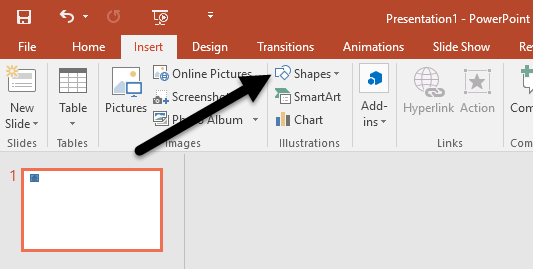
When you click on this button, you will notice that PowerPoint opens up a long menu with many different types of shapes you can add to your presentations.
At the very bottom of the list, locate the section titled Action Buttons and click on the button with a picture of a House on it.
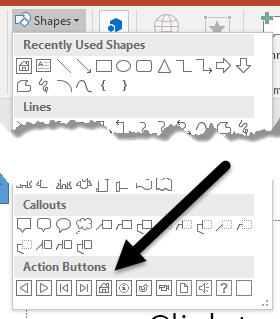
Now that you’ve clicked on the House button, you need to place it on your slide. Position your mouse pointer approximately in the location where you want the button to be and hold down the left mouse button.
Drag your mouse until the button is approximately the size you want it and let go of the left mouse button.
PowerPoint will immediately open up the Actions Settings window. As it turns out, the default settings are exactly what you want here.
Notice that on the Mouse Click tab, the Hyperlink To option is already checked and the First Slide link is already chosen in the drop down menu.
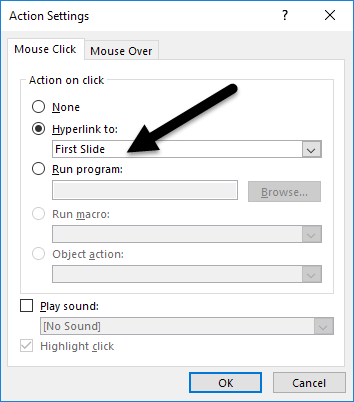
Notice that there are also options to set for when the user hovers the mouse over the button and you can even set the button to launch a program, run a macro, play a sound, and other events. Click the OK button when you are done exploring this window.
Go back to the Shapes button on the Insert menu and once again locate the Action Buttons section at the bottom of the menu. This time, select the button with the arrow pointing to the left.
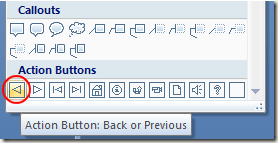
Just as before, place the button on your slide and PowerPoint will open the Actions Settings window. Notice that once again, the default settings are what you need for the Previous button. Click the OK button. Using the same procedures as above, place a Next Action Button into your slide.
When finished, you should have a Home, Previous, and Next Action Button on your slide. If you are not satisfied with the colors, placement, or size of your buttons, you can change them just as you can any other object in a PowerPoint presentation.
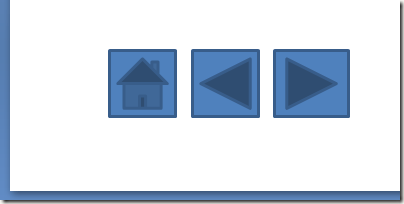
Underutilized by many presenters, Action Buttons can make your presentation easier to navigate for you during a presentation or for a viewer who has a copy of your presentation. Actions buttons allow you to navigate instantly to another slide or even launch an application or macro.
To add some fun to a presentation, you can even have a sound play when you or the viewer clicks the button. Play around with some of the settings of the Action Buttons to create a more interactive experience for your presentation.
Founder of Help Desk Geek and managing editor. He began blogging in 2007 and quit his job in 2010 to blog full-time. He has over 15 years of industry experience in IT and holds several technical certifications. Read Aseem's Full Bio
Read More Posts:

Leave a Reply
Your email address will not be published. Required fields are marked *
How to make an interactive presentation in Google Slides
- Written by: Ian Wicks
- Categories: Google Slides
- Comments: 46

When you’re giving a presentation, you want to impress your audience and make sure they see you as credible. Whether you want to win the next big contract or simply inform, a well-designed presentation can make all the difference. One way to make your presentation stand out is by making it interactive. Interactive presentations are a great way to present information while keeping your audience engaged.
Before we dive in, it’s important to define what we mean by ‘interactive presentation’. ‘Interactive’ is sometimes used to describe presentations that include quiz questions or audience participation – that’s not what we’re talking about here. When we say ‘interactive’ we’re talking about a clickable presentation that uses hyperlinks to help users navigate to different sections. A presentation with hyperlinks is ‘interactive’ because it allows the user to choose what information they view, and in what order. As a general rule of thumb, an interactive presentation works well when your audience needs to engage directly with what’s on the screen, putting them in control of how they digest the information. In this blog post, we’ll walk through how to make an interactive presentation in Google slides.
Technical aspects, step-by-step
Now that we’re on the same page, let’s delve into how to actually create an effective interactive presentation in Google Slides. It’s easier than you might think.
Start by opening a new presentation! From the Google Slides homepage , look to the top left and click the Blank button to open a new presentation. This is your blank slate from which to create an outstanding interactive presentation!

Google Slides automatically inserts a title slide when you open a new presentation, so all you need to do is click on the title text box and type in a title. Make the title something clear and catchy, that your audience can easily understand.
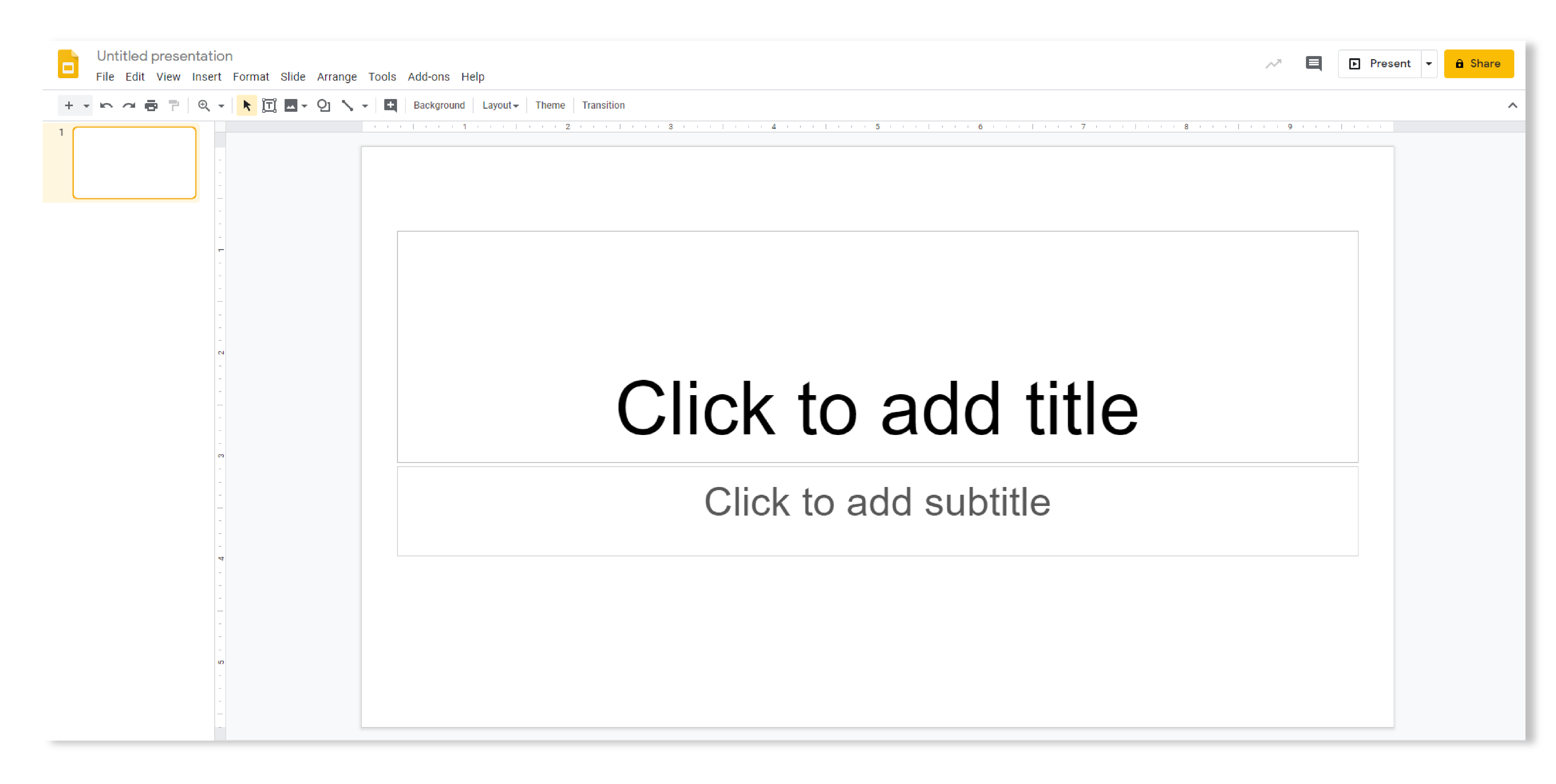
Now, let’s move on to the all-important menu slide. We’re going to create something that looks like a button, so that your audience knows it’s clickable. Later on, we’ll add in hyperlinks. You can use any shape for your button, but rectangular shapes with rounded corners often look the most ‘button-like’. First, locate the Shape button on the toolbar in slides, and select a shape. Then, double click on the slide and that shape will appear. Click and drag using the nodes along the edges of the shape to change its size.
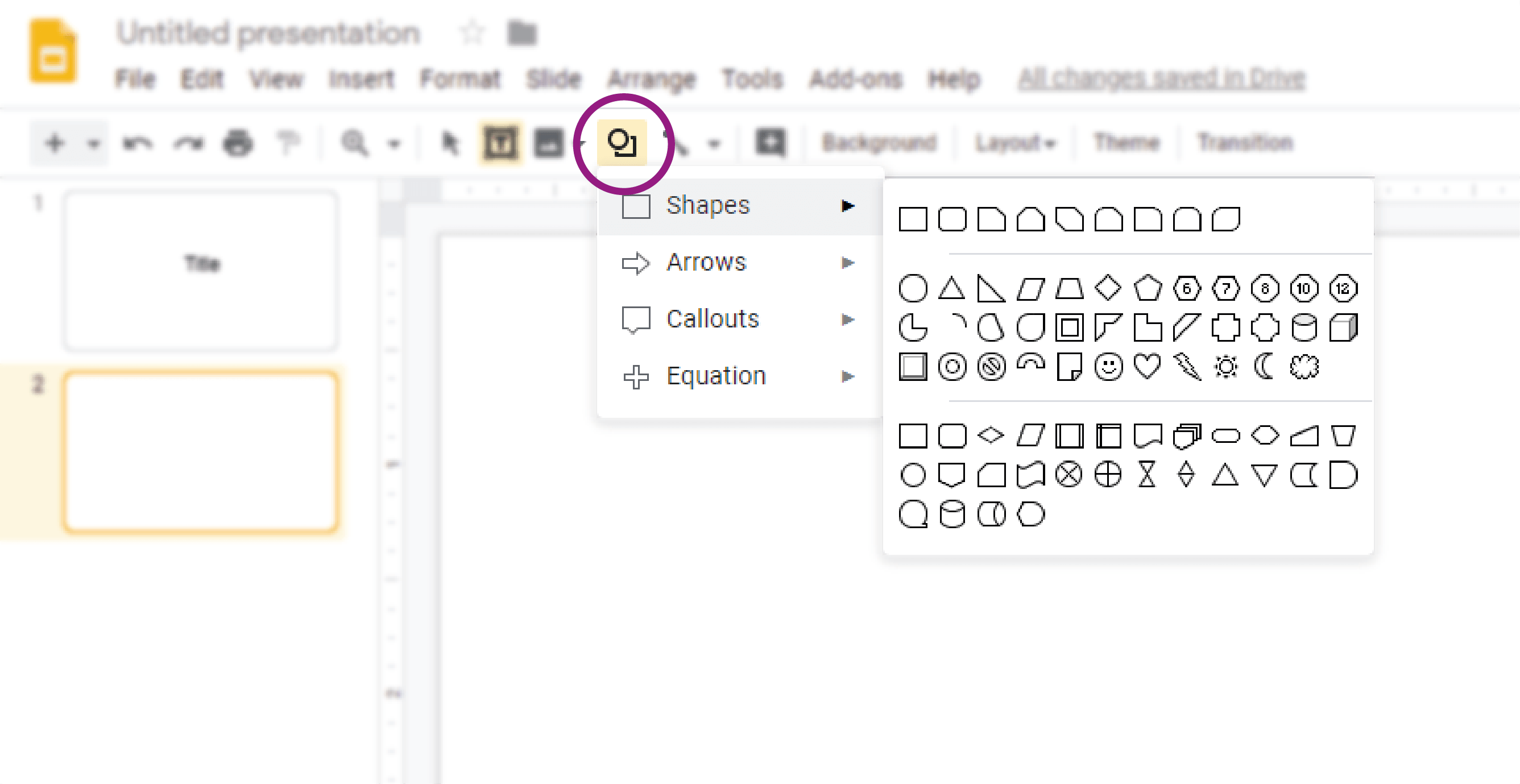
You can add labels either by typing directly on to the shape, or by clicking the text box button (also on the toolbar) and positioning a text box on top of the shape. You might also want to add a small arrow shape on top of your button, to help show that the button is clickable.
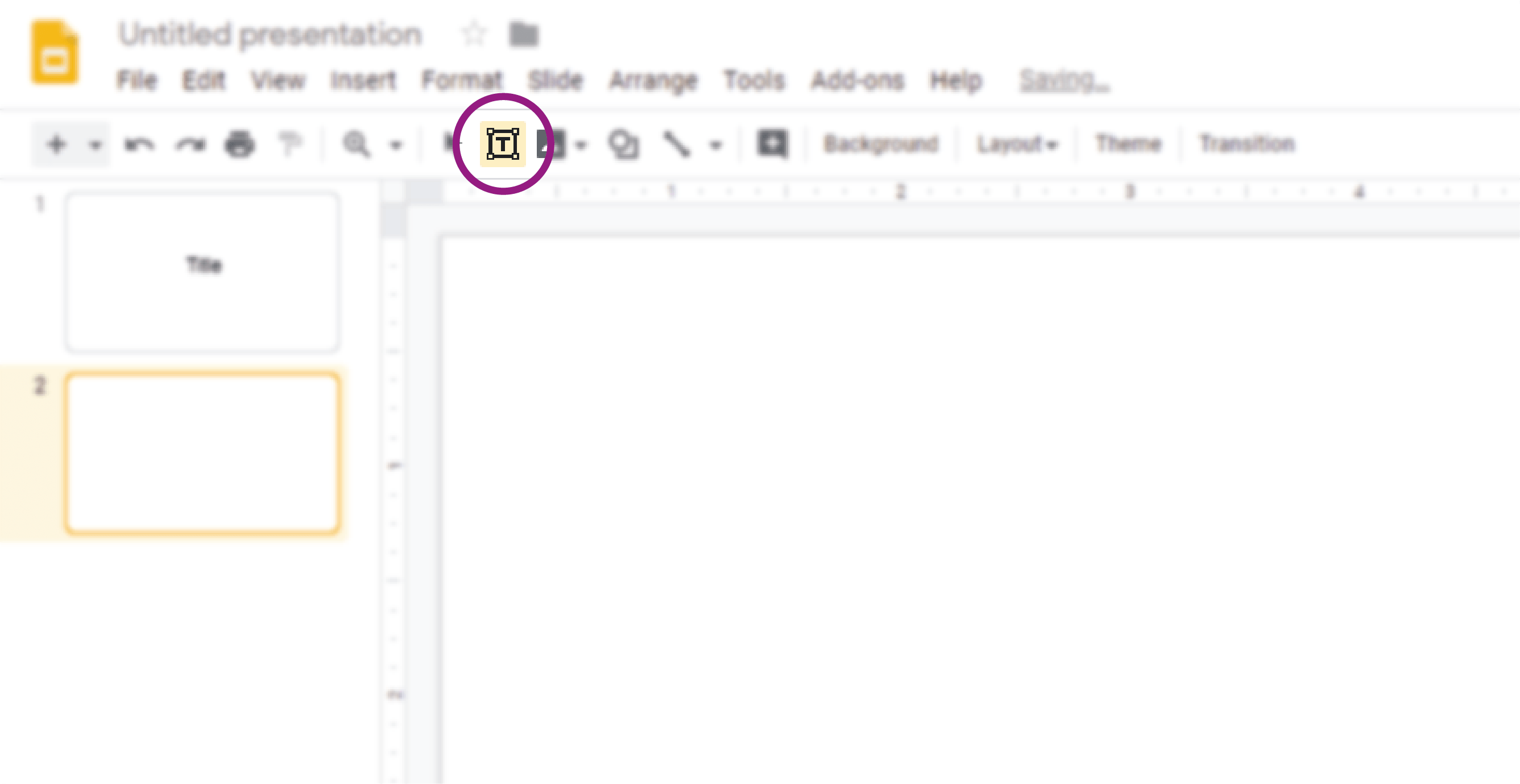
If you’ve got a more artistic temperament, this is an opportunity to be creative! Your button doesn’t have to be made from shapes. The buttons on the menu slide in our example presentation are actually images. Feel free to get those artistic juices flowing, but keep in mind that your buttons need to look clickable. One way of doing this is by adding a drop shadow or border. To add a border, use the border color and border weight buttons, found on the toolbar.
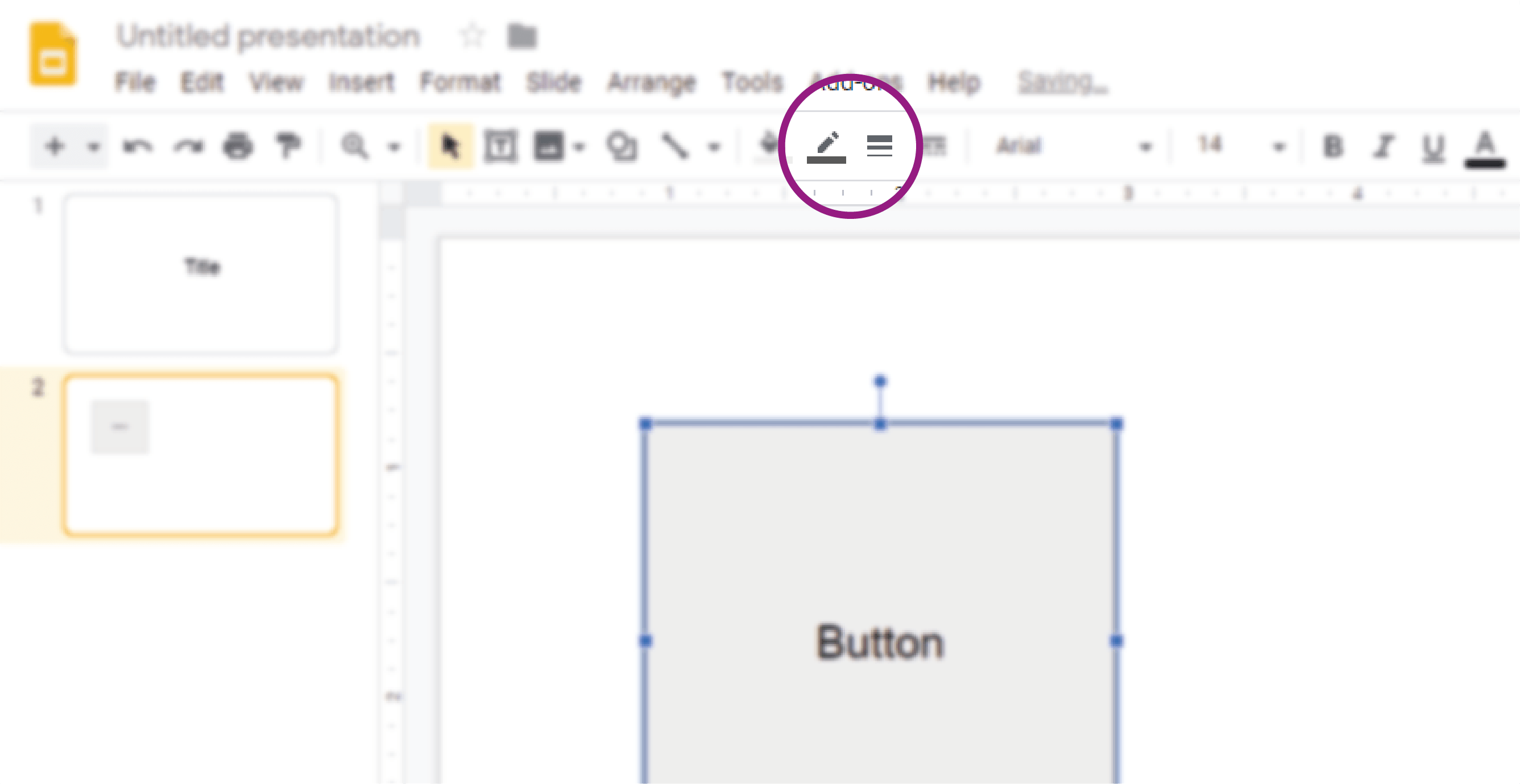
To insert a drop shadow just right click , then select Format options , and check the box for Drop shadow .
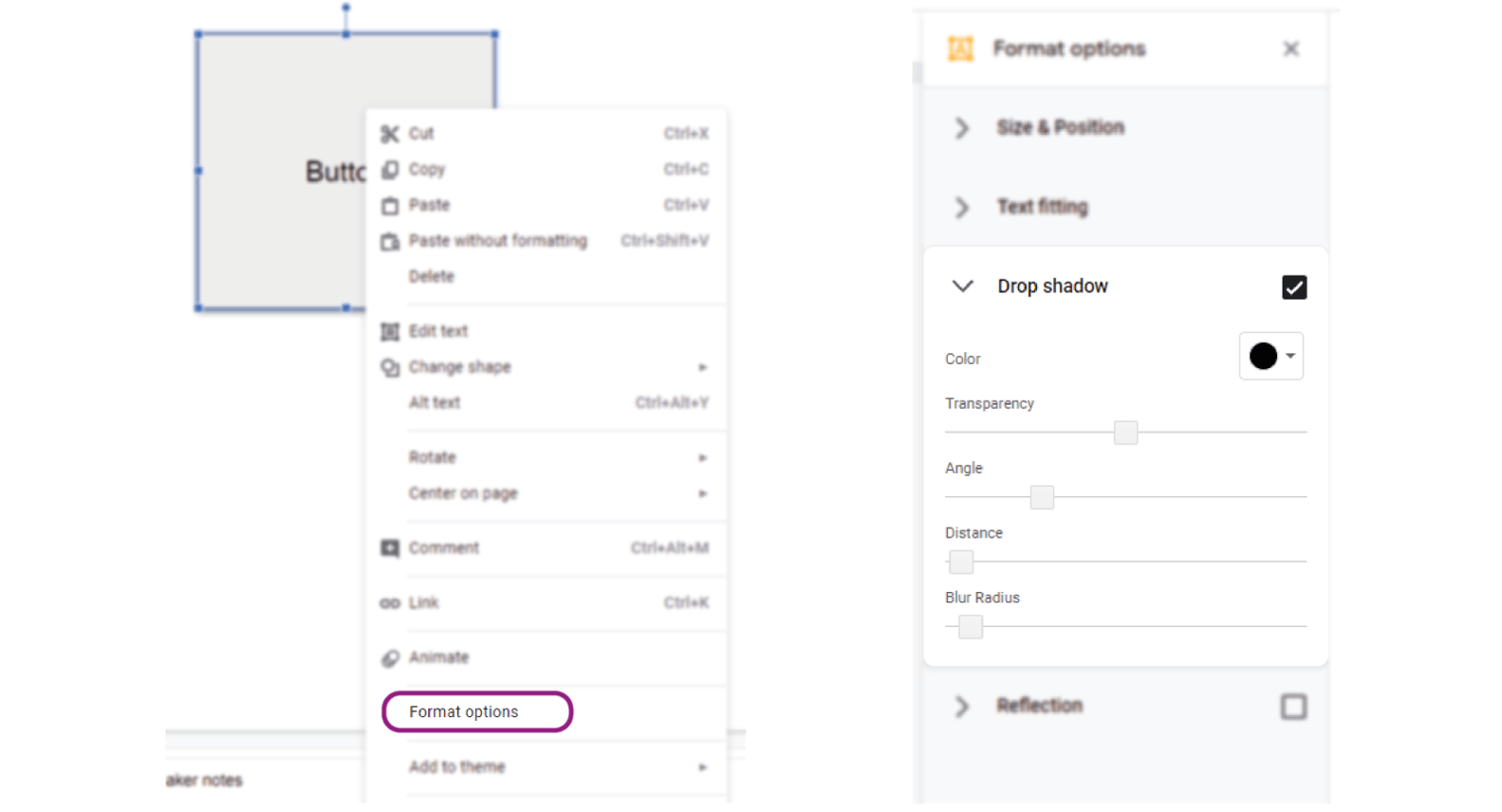
You could also make your buttons a contrasting color from the background and other text – however, avoid colors that are too bright, as this can be distracting.
This first button you have created is the basis for your menu. When you’re happy with how it looks, replicate it so that the number of buttons corresponds to the number of sections in your presentation. You can do this by copying and pasting. Simply select the entire button – click with your mouse and drag over the button so all elements are highlighted – then copy and paste it by right clicking , selecting Copy and then Paste however many times you need. Edit the text of each button to correspond to the section of the presentation it will link to. Next, ensure that the buttons are aligned in some sort of order. You can select various buttons and then align or distribute them as you like using the alignment tools found under the Arrange tab.
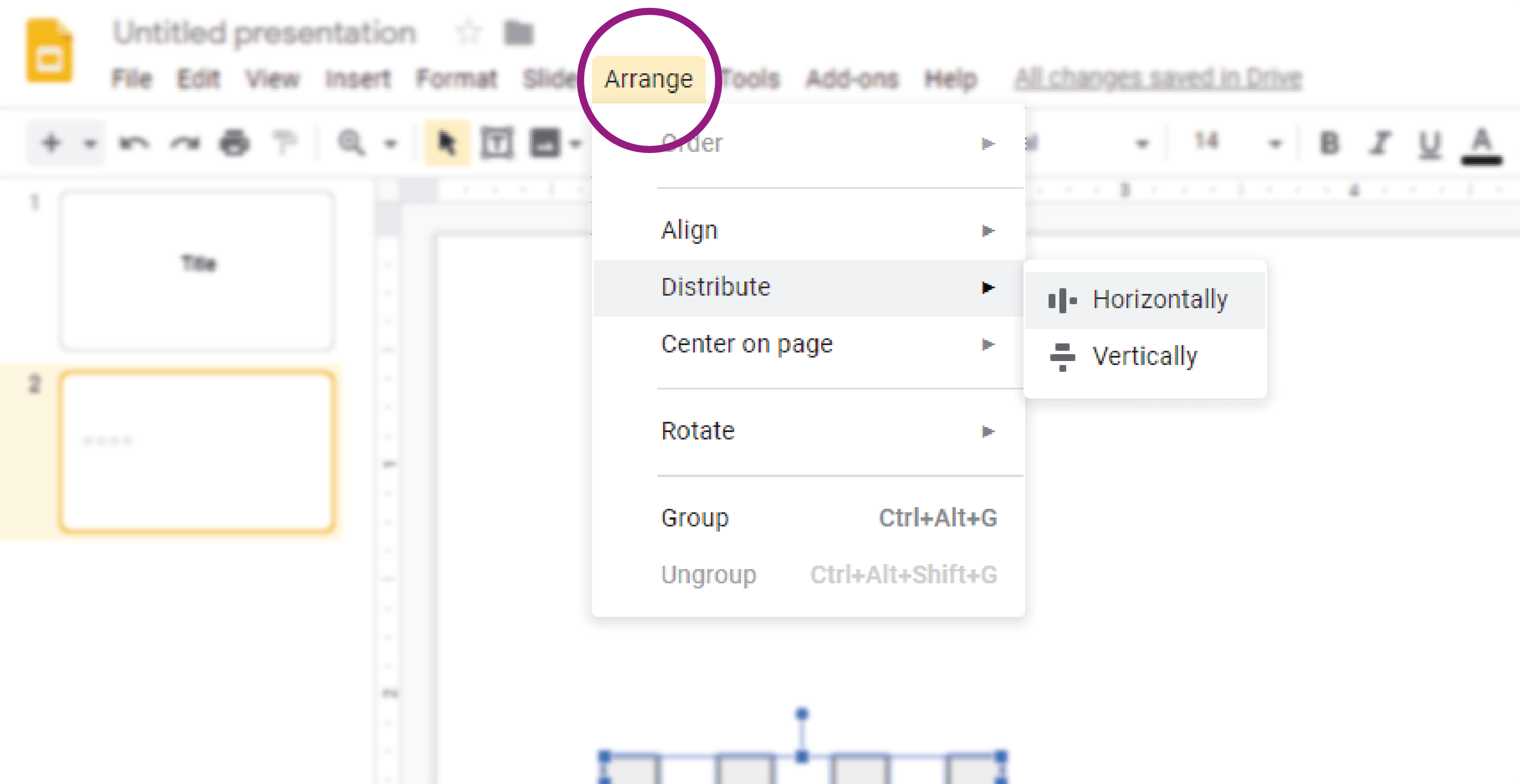
Note: If you decide to use icons or imagery, it’s a good idea to make sure the meaning is clear. For example, we all know that the house symbol mean ‘go to the home page’. There’s no point using a zebra icon to return to the homepage, because people will get confused. Stick to what people find familiar, good navigation is about ease of use!
Tip: To use icons in your interactive presentation in Google Slides, click the Add – ons tab, select Get add-ons , and then select the Insert icons add-on.
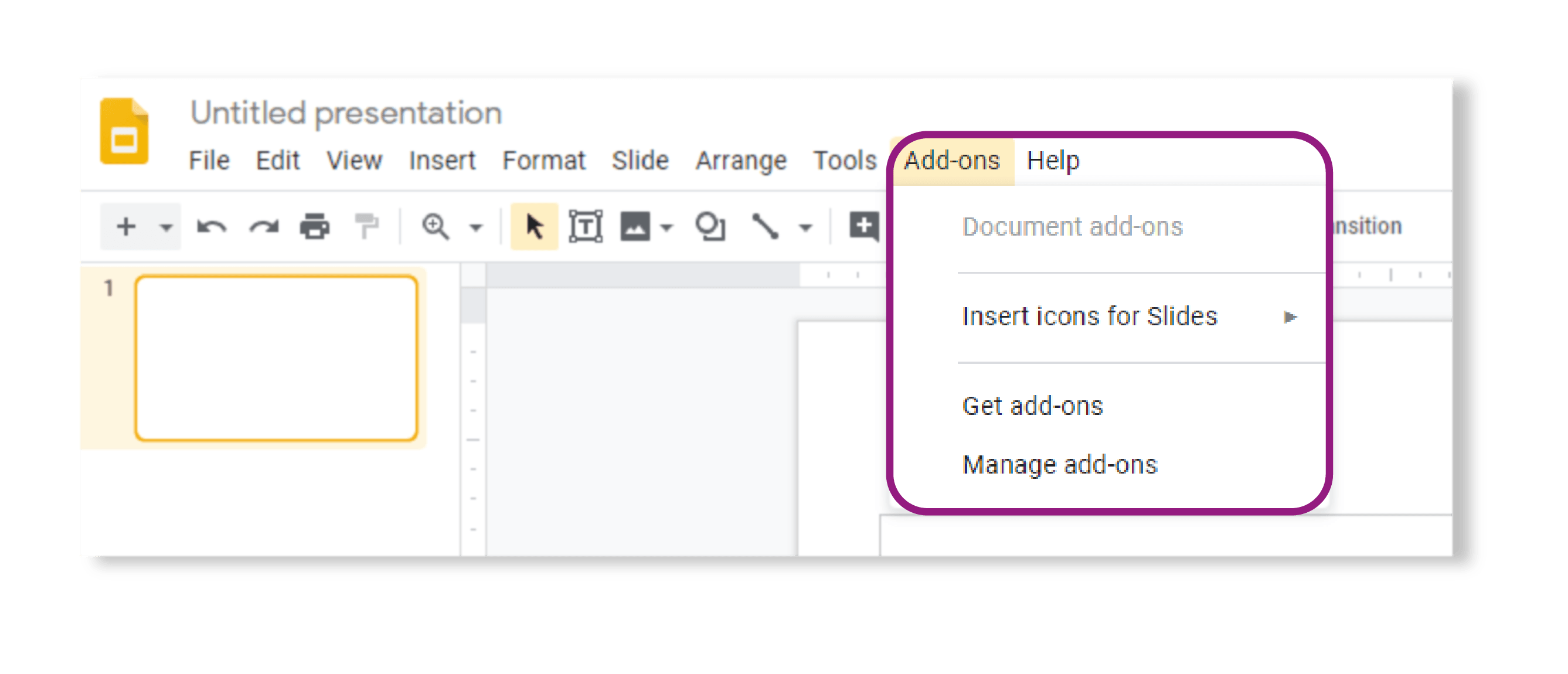
Then, under the Add – ons tab, a new option will appear which is Insert icons for Slides . Hover over this, and select Open sidebar to select icons .
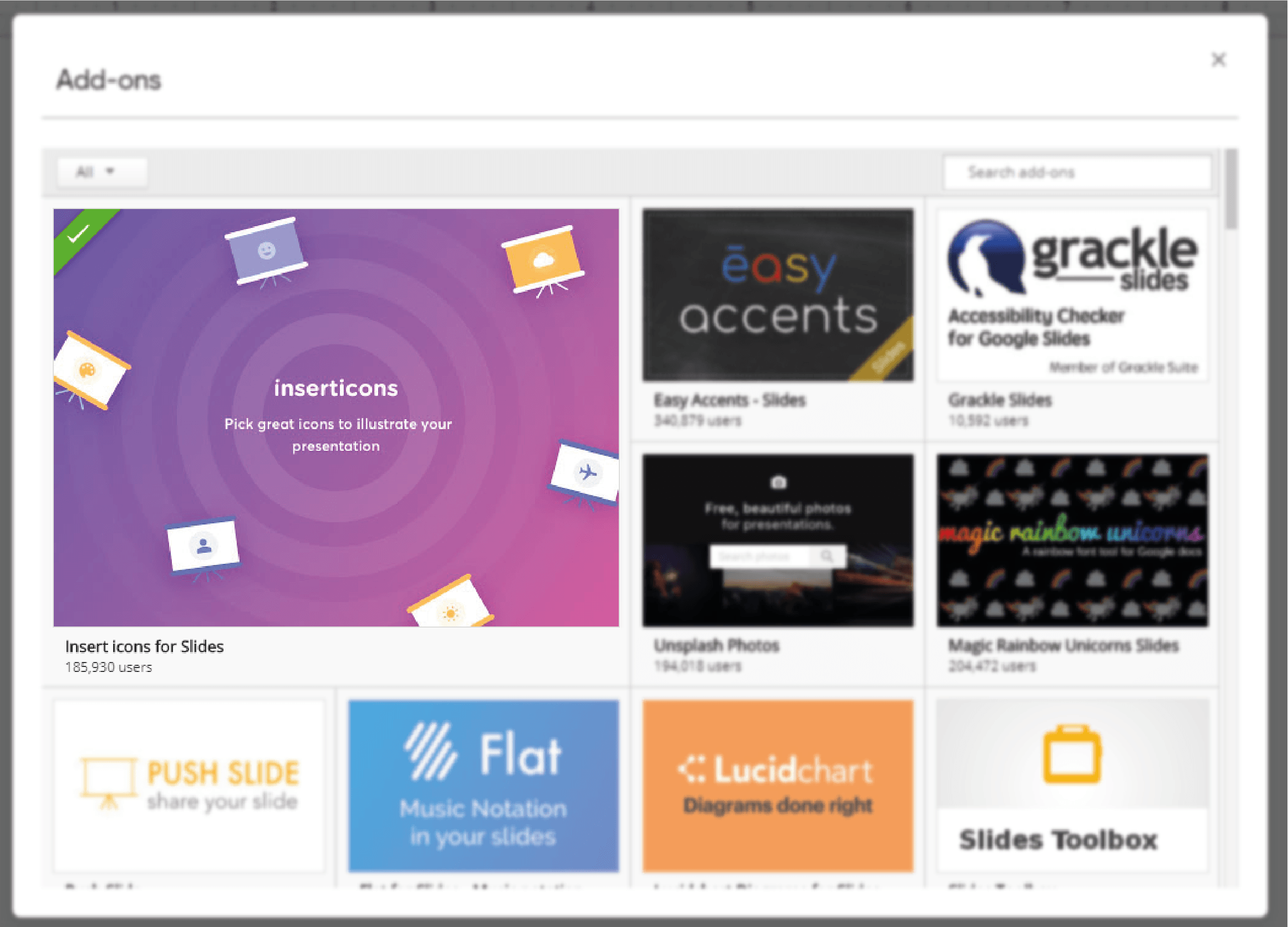
Then, once the sidebar appears, ensure that the icon set selected on the drop-down menu is ‘Material Design.’
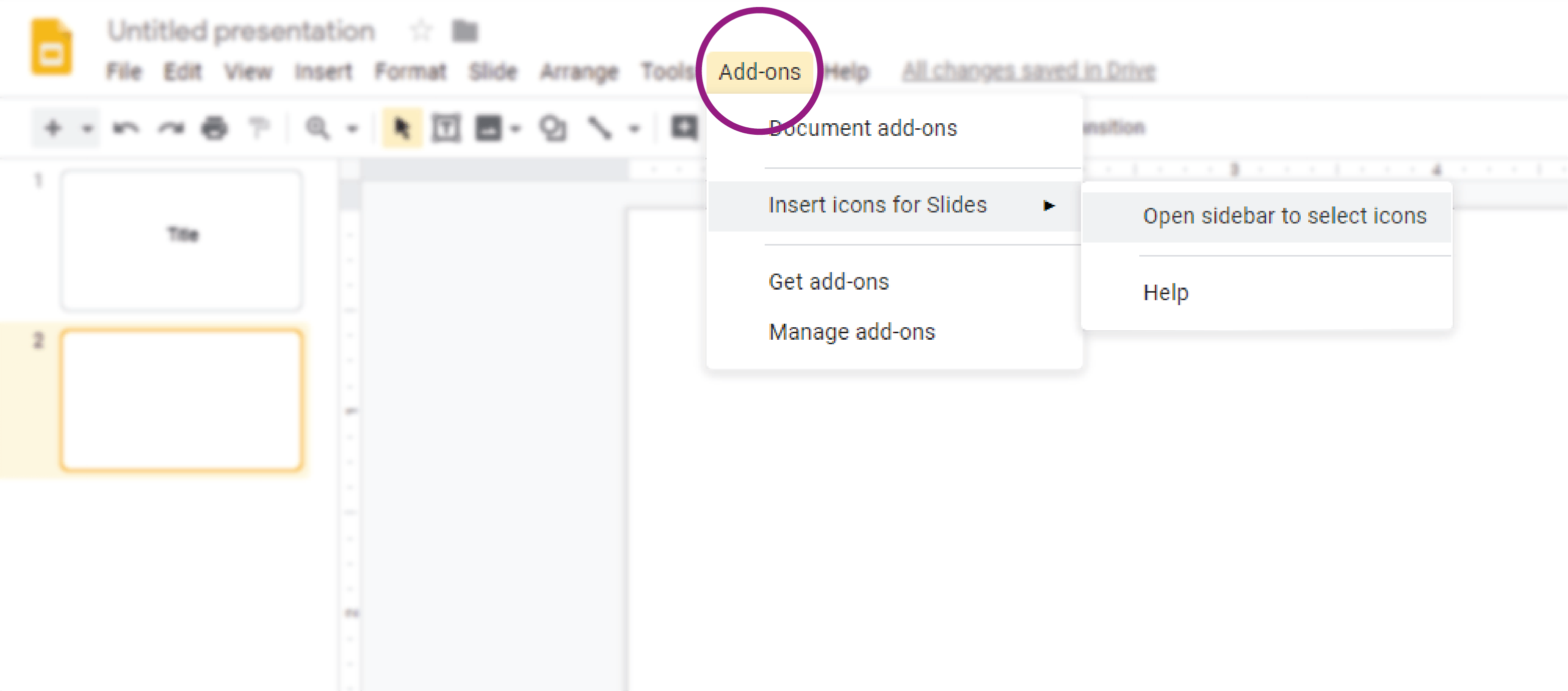
Create section header slides for each section in your presentation. Do this by navigating to the top of the page, and clicking New slide on the top left of the tool bar. Repeat this step as many times as necessary. Next, build as many buttons as you need for the subsection using the steps outlined above. You can also simply copy and paste the buttons you’ve already created, and just edit the text.
Add the information you want to include in each section. If this is images, like in our example presentation, then insert images using the Insert tab.
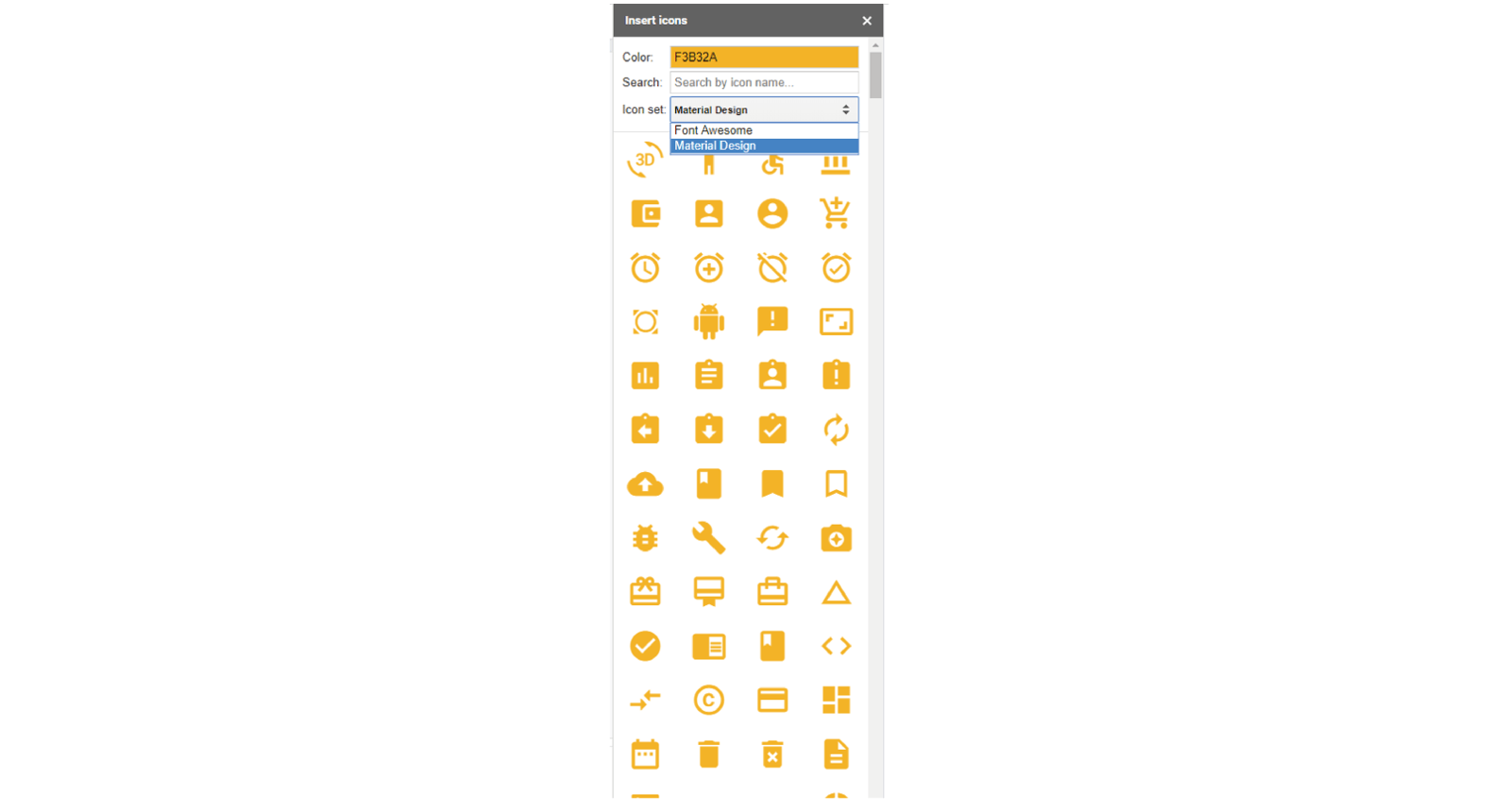
If this is text, type on the slide using a text box. However, it’s best to use visuals instead of long paragraphs of text. Keep your message clear and succinct.
Repeat steps 4 and 5 for each section. Make sure each section has a header slide, with buttons if necessary. Look through your presentation up to this point – make sure all the sections are ordered correctly, and that there is a header slide at the beginning of each.
Return to your initial menu slide. Make transparent shapes to cover each ‘button’ you have created. We will turn these transparent shapes into hyperlinks that allow users to navigate through your deck. First, click the Shape button on the toolbar, and then create a shape that covers the button that you have created, but not any white space outside them. Then, select the shape and click the Fill color button on the toolbar, select Transparent from the dropdown menu.
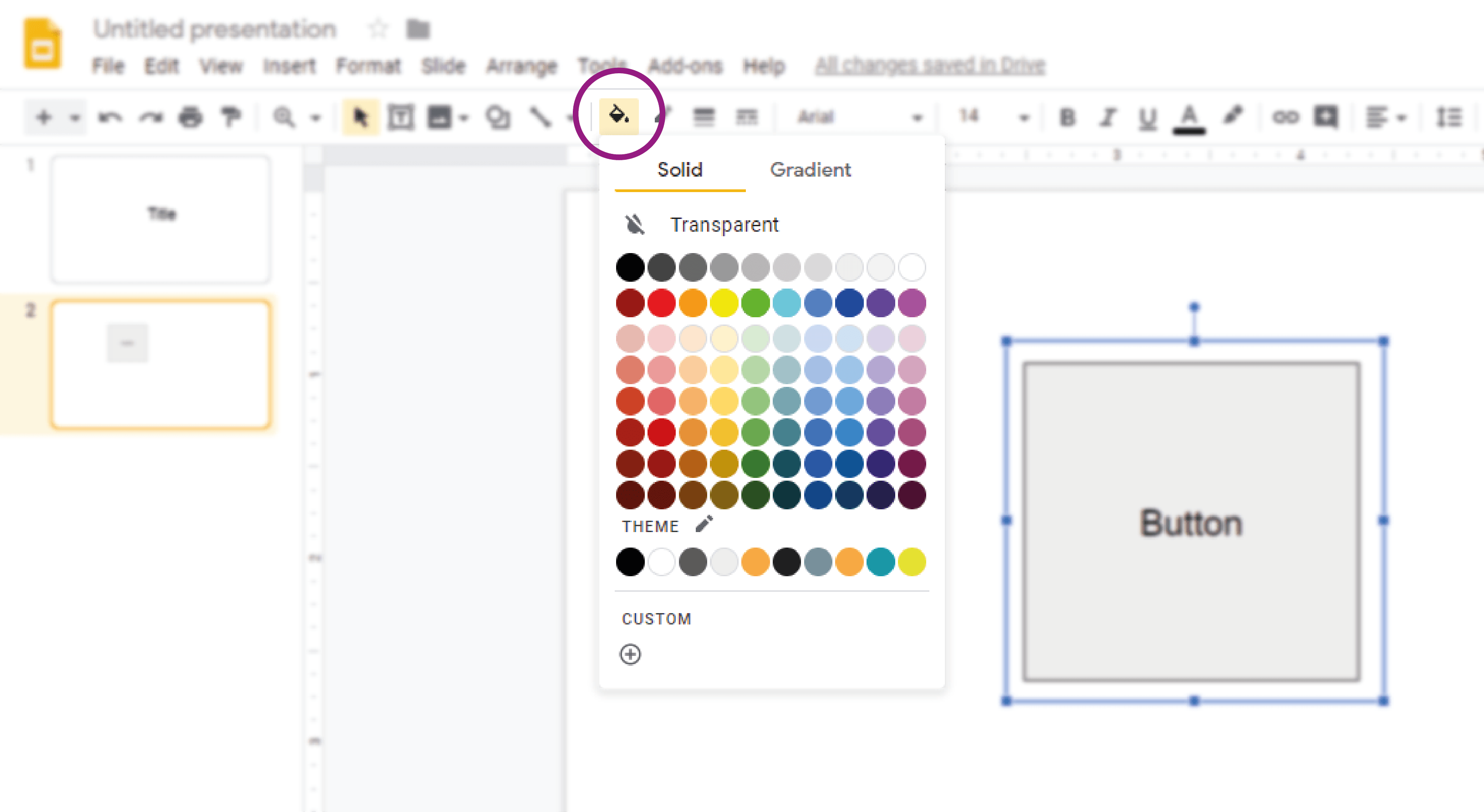
Place these transparent shapes over the top of every button in your deck. Using transparent shapes in this way makes it much easier to edit the hyperlinks if needed, and also makes it less likely that a user will miss a clickable area!
Now we are ready to hyperlink each button! Select the first transparent box on your menu slide, right click, then select Link and choose Slides in this presentation . From here, choose the slide you want your button to navigate to when clicked.
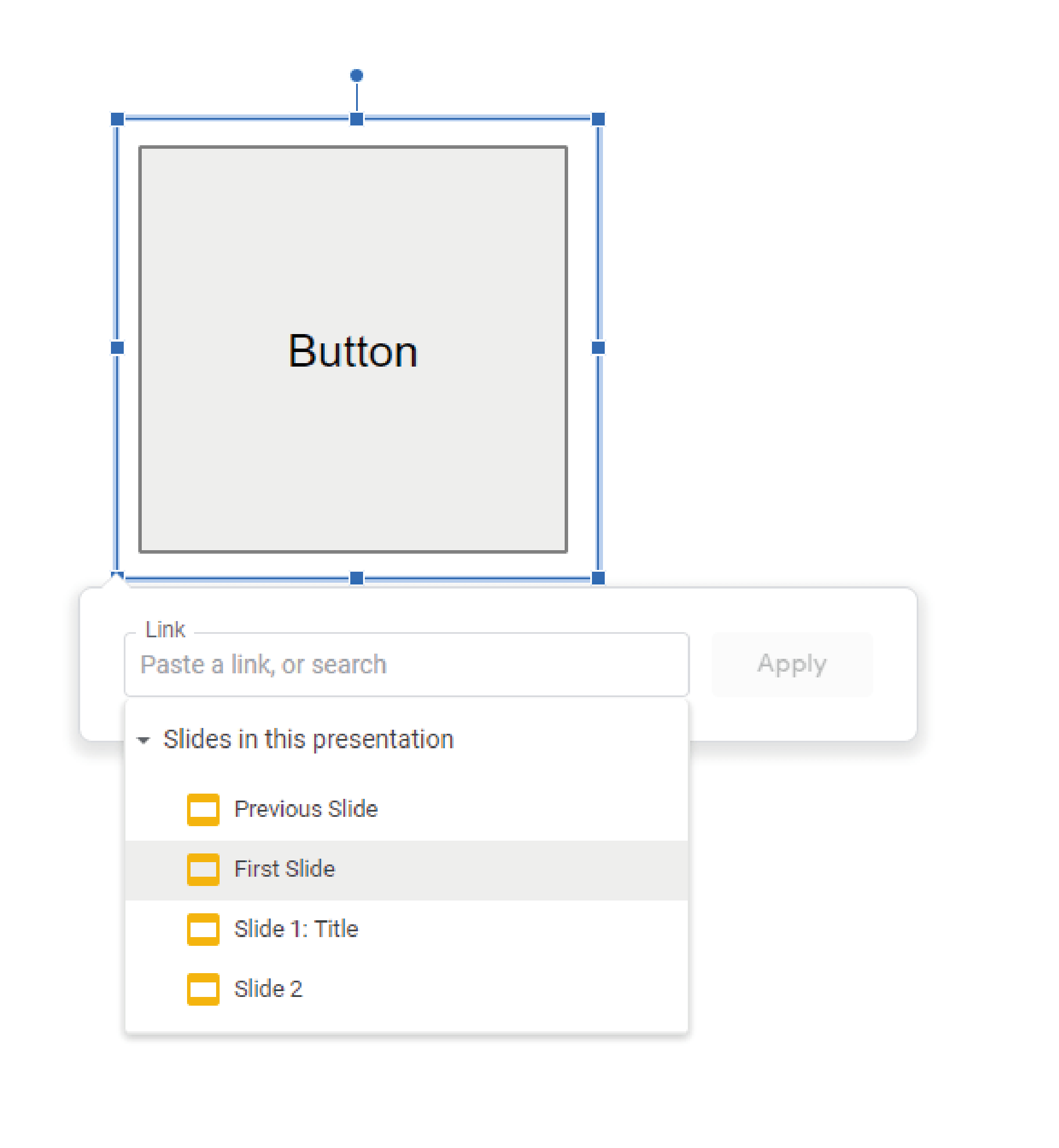
Tip: If your slide has a title, it will have the same title in the link section, making it easier to find. After you have linked these two slides the link will stay connected to the specific slide, not the slide number – so it doesn’t matter if you move things around.
Repeat this process for all buttons, so that each one links to the correct slide.
Create buttons to return to the main menu. To do this, follow the steps outlined previously and use a transparent box that links back to the main menu slide. If you have different subsections within a section, you can also create a button linking back to the section title slide from each subsection.
Interactive presentations in Google Slides: Beyond the basics
Following these steps will give you a fully interactive presentation in Google Slides. But if you want to go beyond the basics, here are some tips and tricks that will help your interactive deck be even more intuitive and user friendly.
An effective menu slide is key
The centerpiece of a good interactive presentation is an effective menu slide that is clearly navigable, has a deliberate spatial layout, and is visually appealing. For example, the buttons on this menu slide clearly indicate the separate sections in our presentation . The arrangement of your buttons helps the user understand your presentation’s structure, so make sure they are arranged logically.
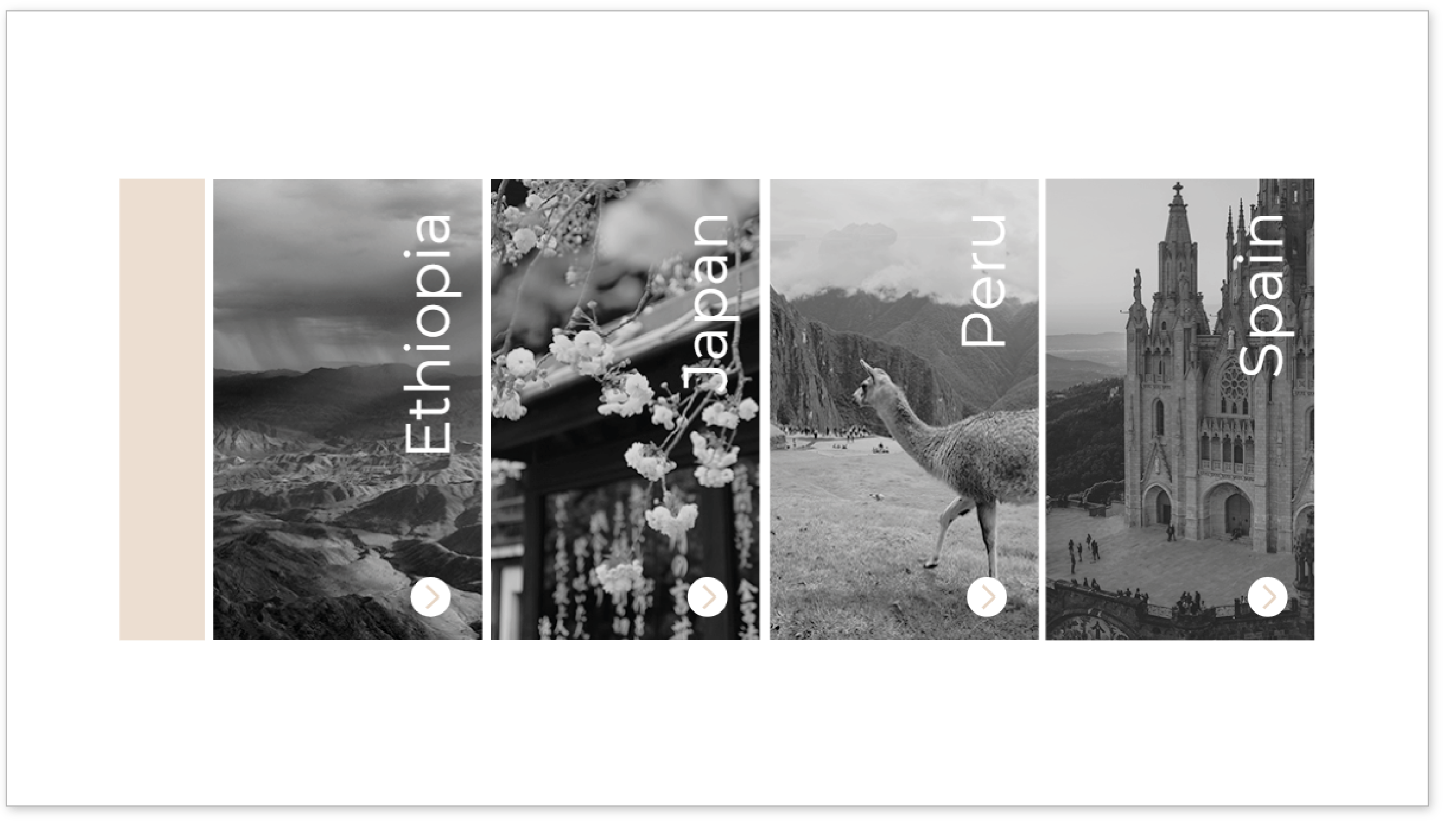
Your presentation needs to be visually engaging
We at BrightCarbon are particularly passionate about this point – far too often slides look dull and drab – and we think it’s important to be the change you want to see in the presentation world! It would be impossible to cover all the ways you can make your deck visually appealing in a short blog post – the important point is to consider the overall aesthetics of each slide and the presentation as a whole. If you’re looking for some design inspiration, check out this article about making slides look great using images.
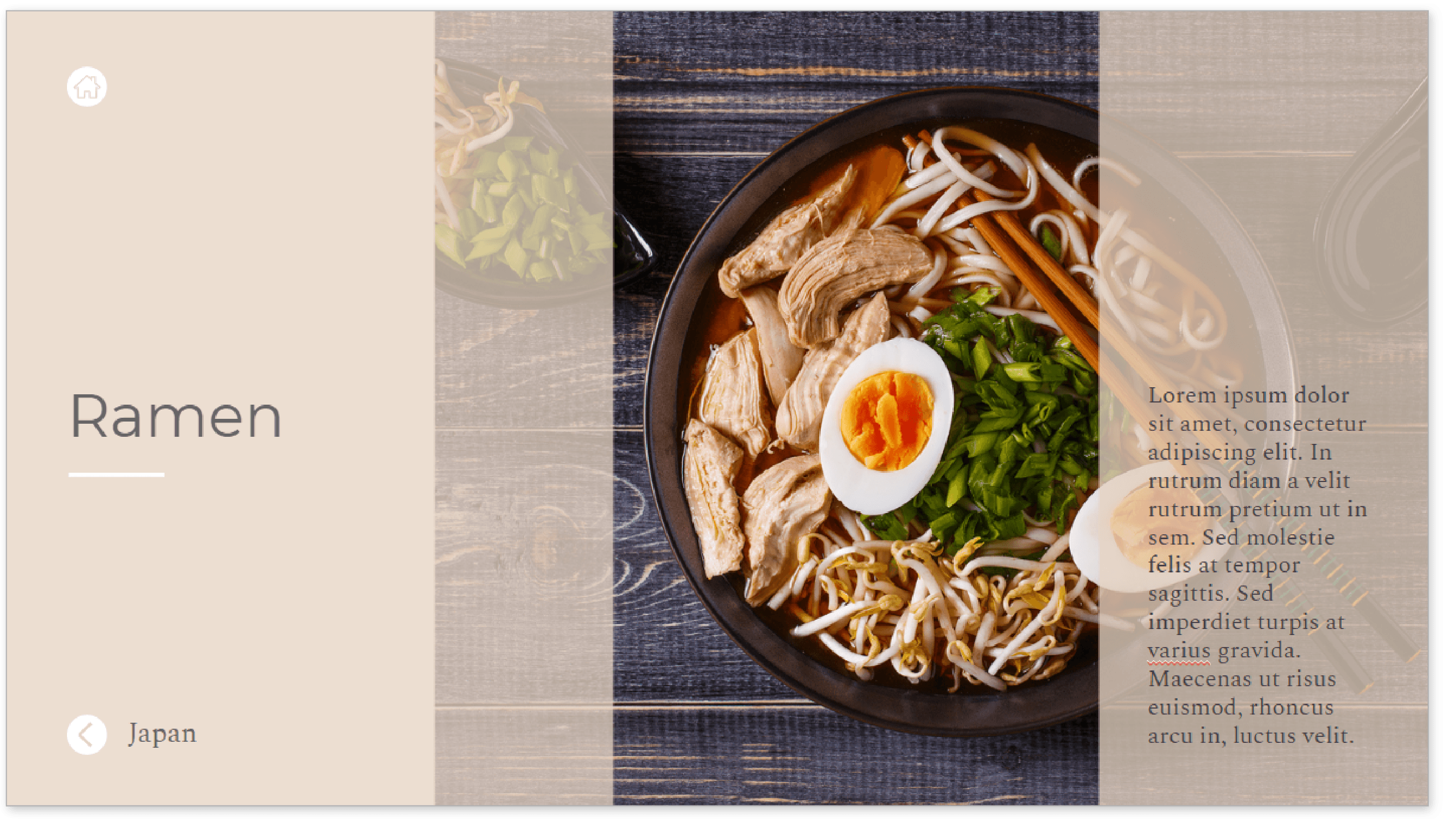
Make navigation as simple as possible
Your menu slide is the jumping-off point to the different sections of your presentation – but constantly exiting present mode to return to your menu slide can break the flow. In a normal presentation there isn’t an effective way of returning to the main slide without clicking back through all the content you’ve already shown. As you want to be able to go through your presentation in a non-linear fashion you need an easy way to return to your jumping-off point. Place a button at the end of each section that links to the original menu slide, so you don’t have to exit the presentation once you start.
Provide your audience with signposts
You want your audience to understand where they are within the presentation, providing them with signposts is an easy way to achieve this. A signpost can be a header slide at the beginning of the section or small indicator icons throughout a given section. It can also be a slide or button at the end of each that clearly includes options to either return to the main menu or go straight into the next section. Make it easy for your audience to follow the flow of your deck.
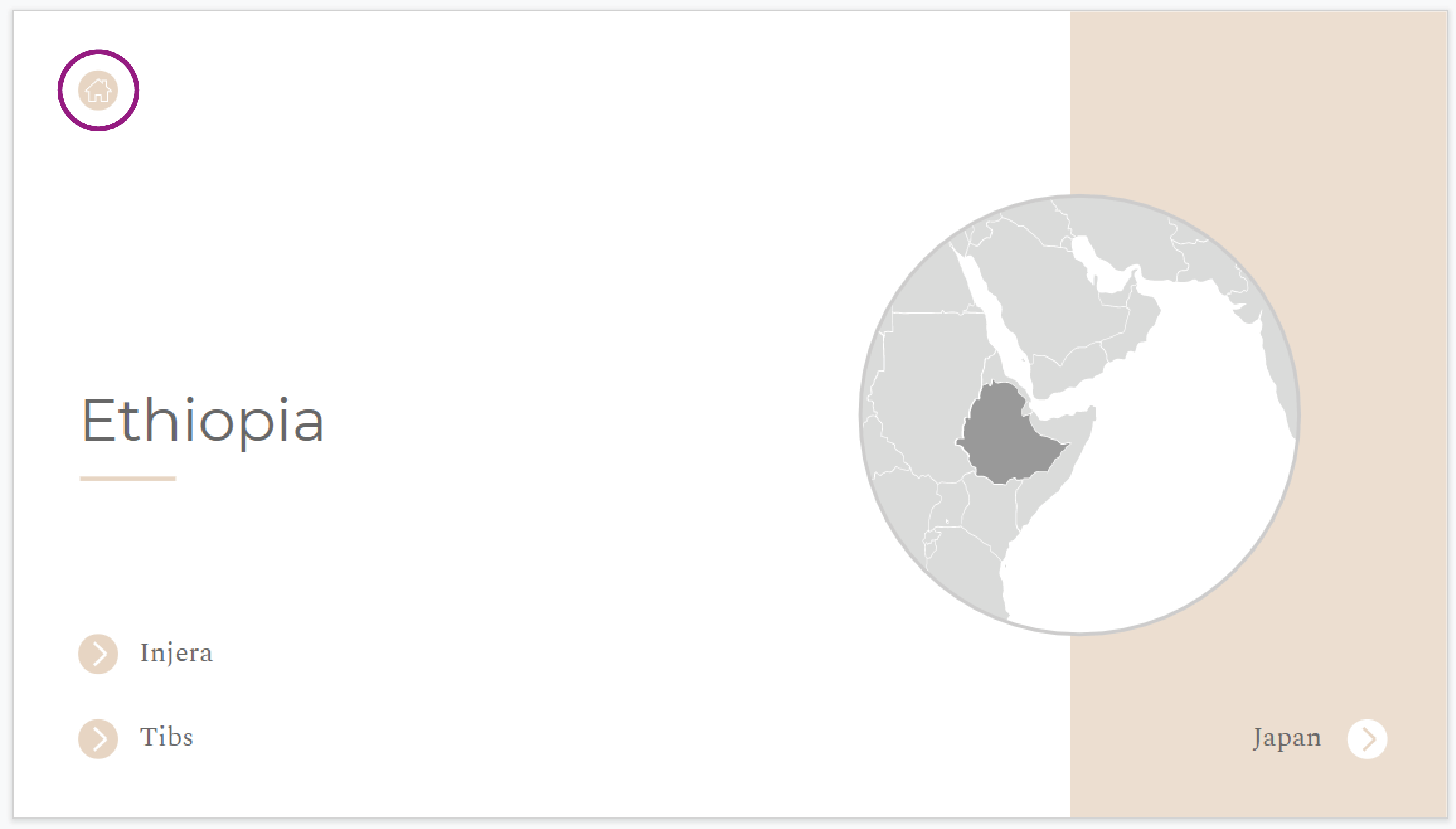
Be strategic when positioning buttons
Consider the location of buttons on the slide. If a button is at the end of a section and returns the user to the main menu, it’s probably best to put it at the bottom right, as in the West we tend to read from left to right, top to bottom. Think about where best to position buttons so the placement is consistently, and so they don’t get in the way of your main content. Take a look at the above screenshot – we’ve positioned our section buttons so they are clearly visible, but don’t dominate the slide.
Make sure you keep the best practices in mind, as they will help you make a clear roadmap that runs throughout your slides. You’re well on your way to creating a great interactive presentation in Google Slides, just one last thing to do – get started!

Senior consultant; Group messaging lead
Related articles, moving to google slides here’s what to consider..
- Google Slides
If your organization is considering using Google Workspace it will impact the way you create presentations. Microsoft PowerPoint will no longer be your default and you’ll need to count on Google Slides. Before you make a change like this, it can be hard to know what to expect. How might your business benefit? What are the potential downsides? How can you make the transition as smooth as possible? Let's find out!

Google Slides Themes and Layouts
- Comments: 8
In Google Slides, editing the Theme and Layouts is an easy way to ensure that your presentations have a set style that stays true to your brand. Getting to grips with the Google Slides Theme builder and Layouts can also speed up your content creation, providing a firm jumping off point for all your future presentations.

6 ways to get the most out of online collaboration with Google Slides
When preparing a presentation, it’s often the case that multiple people need to contribute content. However, when you’re not working in the same office, this can be difficult. We explore how Google Slides collaboration features can help you create brilliant presentations online.

Is there a way to send an interactive slideshow with hyperlinks to students that allows them to click outside to YouTube and click to other slides, but does NOT allow them to edit the presentation? Thanks!!
Hi Adam, There’s an easy fix for this problem. All you need to do is share the presentation as “view only” with your students. To do this, click the share button as you normally would, then click the pencil icon that is to the right of the “People” bar, and select “can view” from the drop down menu. This will still let your students use the links within the presentation as well as any external links, but won’t let them make any edits to the presentation itself. Hope this helps!
Mabey make them a commenter on the slideshow?
Yeah true that problem could be fixed and they should be able to!
When I share my presentations in present mode the presentation bar that shows up interferes with any buttons I have added. Is there a way to remove that so that only the arrow keys or buttons can be used, or is there a way to change it’s size? I makes the buttons almost useless.
Hi Kera, unfortunately there’s no way to move the presentation bar once in present mode, it’s very frustrating! The best solution is to move the buttons so that they aren’t on the bottom left of the slide. Hope this helps!
Actually there is a way to share without the presentation box there. After you click share to copy the link “choose anyone can view” paste into the task bar and change “edit” to “present” and add @rm=minimal to the end then copy and paste that link to where you are sharing.
Hi kera, this is really helpfull tutorial. I’ve a question….is possible to create a final quiz? I need a presentation with final valutation quiz….is it possible?
Hi Antonio, yes you can use the same method in this post to make a quiz. All you would need to do is create a menu slide with buttons named “Question 1” “Question 2” etc. (or “Round 1” “Round 2” if you wanted to divide questions by round), and link those buttons to slides later in the presentation that included your quiz questions. Then, include a button on your question slides that link back to the main menu slide. Of course, you would still need to keep score outside of slides, as there’s no way for slides to track correct answers to your questions. Hope this helps! 🙂
I have made a 20 slide presentation. I have also made an interactive quiz that has 4 questions with a correct and incorrect slide for each question. That makes 12 slides in the quiz. I want to know if I can put the quiz interactive into a specific slide on the 20 slide presentation?
Hi Kelly, if you want to add your quiz slides into another presentation, you should be able to copy the slides over and the hyperlinks should still link to he correct slides, maintaining all interactivity. Then just continue with your presentation once you reach the final quiz slide, instead of returning to the menu slide. If this isn’t what you’re asking, please clarify what exactly you need help with and I’m happy to help. Thanks!
Hi Ian, Thank you for this tutorial. it is great! I made an interactive quiz, published it and sent the link to someone to test. The tester said all of the buttons and links worked correctly and that he could not advance to the next slide unless he clicked on the “next” or “back” buttons. All good. BUT he COULD mouse scroll through the entire quiz and see all of the questions, correct and inocorrect prompt slides. Is there a way to publish or share without being able to scroll through with the mouse? Thank you again!
Hi Lisa, I’m so glad to hear that you found it helpful! Unfortunately, there’s no way that we are aware of to keep people from scrolling through the deck once it’s been shared. I think the best solution is to just ask the person you share the interactive presentation with to be sure and review in present mode. Thanks!
I used interactive slides to create a classroom scene. There are several slides that are accessed by clicking on hyperlinks in the first slide, and every slide has a link back to slide one.
When I try to publish it to the web, the only options include automatically playing through all the slides, which I don’t want to do. I want them only to go to the slides that they click on.
Hi Julie, unfortunately there’s no way we know of to get around this – when publishing to the web, Slides only allows you to automatically play through all the slides, as you say. If you only need to share with a few people, we would recommend simply sharing directly with them as “view only.”
this is awesome !!!!!!!!!!!!!!!!!!!!!!!!!!!! i had no idea on how to get full marks on a project i am doing…. but now my chances have increases by 50% !!! how i love this article….!!!!!! amazing
Hi Bhavya, I’m so glad to hear you found this article helpful!! Good luck on your project!
I found this very useful when producing an interactive display for our art club. However I want to call this display from another programme which deals with several clubs. This I have managed OK but how does the viewer leave the slides presentation and return to the calling programme? I need a QUIT button. I also want to ensure that it all works on tablets and desktops.
Hi Royston, I’m not sure I fully understand your question – you should be able to exit present mode simply by clicking the Escape key. An interactive presentation should work on both tablets and desktops, according to Google Slides. Please clarify and let me know if I can help any more, thanks!
I have the same question as Royston. I know users can press the esc key to exit, however that does not go along with the flow of the presentation. Also, when you press esc, it brings you to the slide show creation view. I want the show to just close on their browser with the click of a “button” on the last slide of the slide show.
On the flip side, when I send users the link to the slide show, and they click on the link, it also brings them to the creation view, so they have to click “present” to see it as intended. Is there a way for me to send a link that will open right to the first slide at full screen, already in “present” view?
I have now found a simple solution to my problem. The slide show contains several menu pages. On each of these I have a Quit button and I link this with the web address of the programme that calls the slide show. This does not send the user to the place on the calling programme which initiated the slide show but in my case this was OK.
I have since modified this so that the Quit buttons lead to the first slide in the slideshow which makes it clear that the button it presents there quits back to the presenting programme but otherwise leaves the user the option of running through the slideshow again.
Is there a way of adding an already interactive PDF to slides and it retain its functionality?
Unfortunately, once you import an interactive PDF into Slides it loses it’s functionality (as it sounds like you’ve already discovered). There’s no easy workaround here, I’m afraid.
Hi! This is really amazing. Thanks for share. I’d like to know if there is anyway to disable navigation through mouseclick, arrow keys or any other way instead of clicking the button links? Because I’m not secure that the viewers will follow the path we create if they can jump slide by slide. Thanks a lot for your attention. =)
Hi Ces, thanks for your question. Unfortunately there’s no easy way that we know of to disable navigating through the presentation but keep the mouse’s other clicking functionality. There’s a way to disable clicking the mouse but still keep keyboard functionality, but this of course doesn’t solve your problem. Sorry about that!
I made a game for students like Jeopardy with columns for each topic area and buttons that show point values fr each question. Students can select the topic and # of points, and a hyperlink will take them to the specific question. I put in back buttons on each question page so they go back to main page. Is there any way to indicate on the main page when a “button” has been opened? Can a hyperlink and animation be embedded so once that button has been clicked it has a different appearance on the main page?
Oh, I really wish that this question had been answered. I’ve been struggling with this for a long time. As far as I can tell, there is no way to do this. It’s a shame that something so easy in PowerPoint is seemingly impossible in Slides.
If I’m wrong, PLEASE correct me. I’d love to have this solved.
I have a question….so we created an interactive slide show for the students with a slide correct-great job slide and a sorry, try again slide. We were able to link each answer to the correct slide or the try again slide, but once it goes there, how do we go back to the previous slide we were at?
Also, if we are presenting our screen to during a google meet are the children able to interact with it if allow anyone with the link to be editors?
Hi Heather,
You might try adding a ‘back’ button on the bottom right of both the ‘correct’ and ‘try again’ slides, and then link these to the previous slide you were at.
As for your second question, yes that’s right – though it might be better to share the presentation with your students as ‘view only’ as if they are editors they can change the content, but if they are viewers they can’t and still have access to the interactive functionality.
Hope this helps!
I tryed it and wow when i looked it was like wow so i shred it to my teacher ms eunick in bellmere junior public school shes like oh wow!!!!!!!!!!!!!!!!!!!!!!!!!!!!!!!!!!!!!!!!!!!!!!!!!!!!!!!!!!!!!!!!!!!!!!!!!!!!!!!!!!!!!!!!!!!!!!!!!!!!
Would you be concerned about exchanging links?
Switching out links shouldn’t cause any problem – all you need to do is follow the same process for adding a new link, but instead just remove the original and add a new one. Hope this helps!
This is super helpful and I really appreciate all of the time and effort that went into it. From the knowledge shared here, I am hoping you might be able to help me with this question. I want to know if there is a way to stay in Present mode and move things around on the slide. I present google slide shows on my Dell board and it would be so much better if students could come up and manipulate icons etc. while still being in present mode, instead of having to exit out and be in edit mode. Is this even possible, or should I give up trying to figure it out? Thank you so much!
Hi Jo, unfortunately there’s not a way to make any changes from present mode. Slides doesn’t have that type of functionality available. Sorry about that!
Hey! Is there a shorter way to do this?
Hi there, unfortunately there’s no quicker way that we know of!
Is there a way to prevent users from clicking on a slide in present mode and have it advance? This way the user can only advance when clicking on a button with internal links?
Hi Frank, as far as we know there’s no way to do this. Sorry about that!
You guys are the BEST!!!!!! Usually, other websites just don’t help you but you guys helped me a lot.
So glad to hear you found it helpful!
Hey, is there a way to put it to when you click on the image it takes you to the next slide?
Hi there, yes all you would need to do in that case is link the image on the slide to the next slide you want to advance to. Hope this helps!
Is there a way to publish these slides onto sites so the audience can click around on all the links but NOT move automatically forward or backward through the deck? I want people to have to click the “go back” button, and when I click it goes through every slide. (It’s an escape room for my students).
Hi Ali, unfortunately Google Slides doesn’t have the functionality to lock slides. Sorry about that!
Hi! I just created interactive slides for my students that includes slides that go back and forth between “good job!” and “try again!” so that students can go through and self-correct. It works fine when in presentation or slideshow mode and they use a mouse to click the answers. However, I have touch screen laptops and if my students touch the screen instead of the mouse (fine motor issues), the file copies itself and goes out of the slideshow mode. What am I doing wrong or can I not use links between slides without a mouse?
Thanks in advance!
As far as I can tell, that sounds like it might be a hardware issue – is there a way for you to disable the touchscreen feature on the devices themselves? As far as I know there’s nothing that can be done from within Slides.
Sorry about that!
Join the BrightCarbon mailing list for monthly invites and resources
We have other people in our own business reaching out to say this is the best presentation they have seen. Sarah Walker Softchoice

You’re using an older browser version. Update to the latest version of Google Chrome , Safari , Mozilla Firefox , or Microsoft Edge for the best site experience.
- Corporate Training
- Course Selling
- Academic Learning
- Learning Basics
- Instructional Design
- Online Training Tools
- Manufacturing
- Products iSpring Suite iSpring Learn
- Use Cases Onboarding Compliance Training Induction Training Product Training Channel Partner Training Sales Training Microlearning Mobile Learning
- Company About Us Case Studies Customers Partnership Course Development Contact Us
- Knowledge Hub Knowledge Hub Academy Webinars Articles Guides Experts on iSpring
- Language EN English Français Deutsch Español Italiano Nederlands Português Polski 中文 日本語 العربية Indonesia
- Shopping Cart
How to Add Action Buttons to Set Up Navigation and Commands in PowerPoint

content creator
Helen Colman See full bio →

An action button is a built-in shape you can add to your slides and set to hyperlink to another slide, play a sound, or perform some other action. This is a great way to add interactivity and navigation to your presentation with minimal effort.
Without action buttons, you would first add a shape such as a rectangle, then add some other elements like an arrow so that it looks like a button, and finally set the same actions for all the elements. An action button is already an entire unit that looks like a button that is expected to be clicked. The only thing you need to do is assign an action to it.
Action Button Types
PowerPoint offers a range of action buttons – those looking like a Home, a Video Camera, a Sound, a Question Mark icon, to name a few. Now let’s take a look at the default behaviors that are programmed in PowerPoint for the action buttons:

How to Insert an Action Button on a Slide
Here’s a brief step-by-step guide on how to add an action button to a slide.
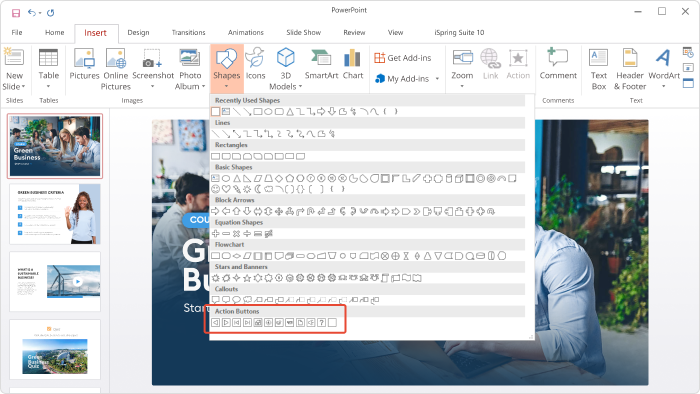
- Choose the one you need – we’ve selected the Forward / Next Shape for this example – and click anywhere on your slide. Then, the Action Settings dialog box will appear.
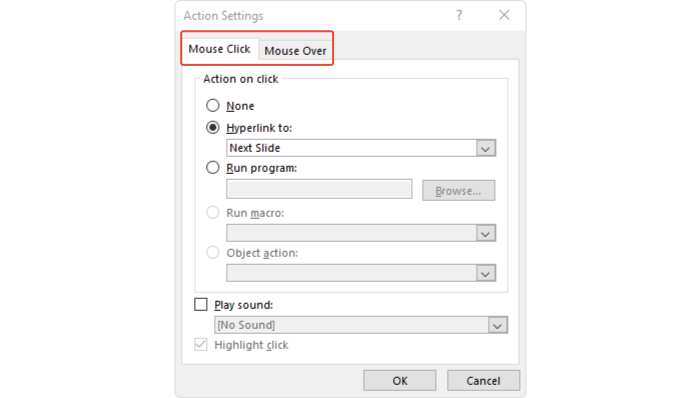
How to Insert an Action Button on All the Slides
If you need the same action buttons throughout your presentation, you can add them to all the slides all at once by using the Slide Master View . Here’s how to do this step by step.

- In the left navigation pane, scroll up and select the first slide.
- Switch to the Insert tab, choose an action button from the Shapes Gallery , add it to the slide, and define the settings in the dialog box.

To edit, move, or delete an action button that was inserted in this way, return to the View tab → Slide Master . Click Close Master View after making the changes.
How to Customize an Action Button
PowerPoint allows you to adjust the feel and look of action buttons. To customize the appearance, click on the action button and go to the Format tab. To change the color of the button or add effects, use the tools in the Shape Styles section.

To change the shape, click on Edit Shape and choose a new shape from the drop-down menu.
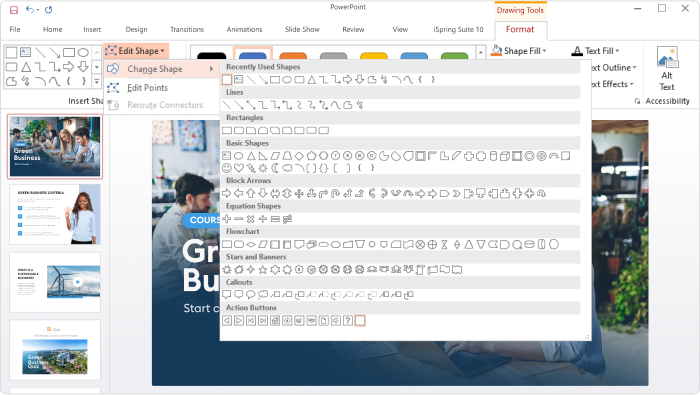
How to Add an Icon to an Action Button
Another way to customize your action button is to add an icon. First, you need to choose an appropriate icon. There are tons of icons everywhere online. You can find some here , for example.
After you find the right icon, follow these steps:
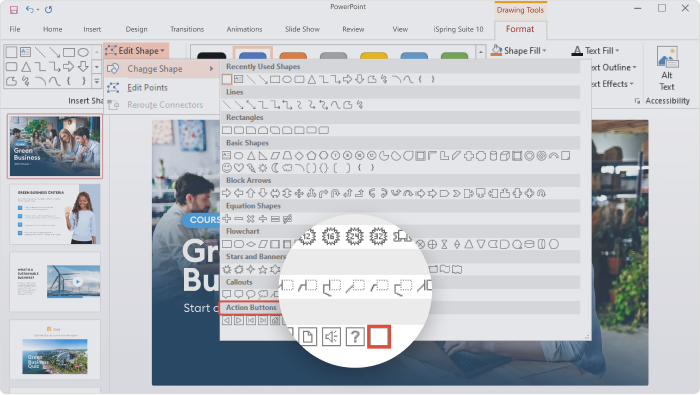
- With your icon (not action button) selected, access the Insert tab of the ribbon and click Action . This will bring up the same dialog that you saw before.
- Apply the same settings that were used previously.
Now play your presentation to test the action button. It does not matter if you click on the icon or the area of the action button that is not covered by the icon – either way you will end up activating the same hyperlink.
Action buttons let you navigate quickly and efficiently within a PPT presentation. Still, if you need to create non-linear navigation or so-called branching scenarios, you need to configure it manually for each slide by adding hyperlinks and action buttons on each slide and reconsidering the structure of the whole presentation, which is quite tedious and time-consuming. Fortunately, there’s an easier way to set up navigation in your slide show, and this is with the iSpring Suite authoring toolkit. To take a detailed look at how to do this with iSpring and get more insights on how to simplify PPT slide design, check out our post on how to structure a PowerPoint presentation .

Content creator
Helen Colman
She enjoys combining in-depth research with expert knowledge of the industry. If you have eLearning insights that you’d like to share, please get in touch .

The Best 10 eLearning Authoring Tools & Software

Articulate Storyline 360 vs. Adobe Captivate vs. iSpring Suite

How to Convert PowerPoint to Video for Windows and macOS
Subscribe to our blog
Stay tuned to get our latest eLearning tips and tricks!
By clicking “Subscribe”, you agree to our Privacy Policy . All emails include an unsubscribe link, so that you can opt-out at any time.
We use cookies to give you the best possible experience on our website and also for analytics and marketing purposes. You can enable or disable optional cookies as desired. See our Cookie Policy for more details.
Manage your cookies
Essential cookies are always on. You can turn off other cookies if you wish.
Essential cookies
Analytics cookies
Social media cookies
- Help Center
- Google Docs Editors
- Privacy Policy
- Terms of Service
- Submit feedback
- Get started with Google Slides
- Create a presentation
How to use Google Slides
Want advanced Google Workspace features for your business?
Try Google Workspace today!
Google Slides is an online presentation app that lets you create and format presentations and work with other people.
Step 1: Create a presentation
To create a new presentation:
- Open the Slides home screen at Google Slides .
You can also create new presentations from the URL https://slides.google.com/create .
Step 2: Edit and format a presentation
You can add, edit, or format text, images, or videos in a presentation.
- Insert and arrange text, shapes, and lines
- Add, delete & organize slides
- Add animations to a slide
Step 3: Share & work with others
You can share files and folders with people and choose whether they can view, edit, or comment on them.
Related articles
Learn more about Tool finder for Docs, Sheets & Slides
Need more help?
Try these next steps:.
Using Google products, like Google Docs, at work or school? Try powerful tips, tutorials, and templates. Learn to work on Office files without installing Office, create dynamic project plans and team calendars, auto-organize your inbox, and more.
Creating and Saving a New Presentation
Locked lesson.
- Lesson resources Resources
- Quick reference Reference
About this lesson
Let's create our first new presentation using a blank template. We'll learn how to save presentations locally and to the cloud, and understand how this determines how the presentation is saved going forward.
Exercise files
Download the ‘before’ and ‘after’ PowerPoint presentations from the video tutorial and try the lesson yourself.
Quick reference
A fundemental skill in PowerPoint is knowing how to create a new blank presentation and save it to a folder. Blank presentations by default contain one slide with no placeholders, text or other graphical elements. It provides a blank canvas from which to design a slide deck.
All presentations should be saved to a local folder, a network drive or into cloud storage. This ensures that any changes we make are saved and the liklihood of losing work is reduced. Presentations saved to the cloud automatically save and synchronize as you work. As a general rule, most presentations we create are saved with the default .pptx file extension.
When to use
We will need to create and save a new blank presentation when we want to design a slide deck from scratch.
Instructions
Create a new blank presentation.
New blank presentations can be created in a few ways: from the File menu, using a keyboard shortcut or from the Quick Access Toolbar.
From the File Menu
- Click the File tab.
- Click New .
- Choose Blank Presentation .
Using a Keyboard Shortcut
- Press CTRL+N .
From the Quick Access Toolbar (QAT)
- Click the New button on the Quick Access Toolbar.
Design Ideas
When we create a new presentation, the Design Ideas pane will show on the right-hand side. The Design Ideas feature examines the contents of the selected slide and offers a variety of design choices based on the layout and content.
To apply a design to a slide, simply select one from the list and click to apply.
Switch between Presentations
If you are working on more than one presentation at any time, its beneficial to know how to switch between them efficiently. PowerPoint will only display one presentation at a time in the window.
- Click the View tab.
- In the Window group, click Switch Windows .
- Choose the presentation to switch to from the list.
Save a Presentation
Presentations can be saved to a local folder on our PC, a network drive, an external storage device or in the cloud.
Save a Presentation to Cloud Storage
Presentations saved into a cloud storage application like OneDrive are automatically saved and synchronised as we work. This means we only need to save the presentation once at the beginning and any changes made from that point on are automatically saved.
- Click Save As .
- Click Browse and choose a folder.
- Choose a meaningful name for the presentation and type it into the File name field.
- Verify the Save as type is set to PowerPoint Presentation (*.pptx).
- Click Save .
Once saved, check the AutoSave slider is toggled on in the Quick Access Toolbar to ensure any changes made are automatically saved and synchronised to the cloud.
Save a Presentation to a local folder on our PC
Presentations saved to a local folder do not automatically save as we work. This means we need to ensure that we save at regular intervals.
- Click Save .
Remember to save your work at regular intervals. Click the Save icon on the Quick Access Toolbar, or select Save from the File menu. Alternatively, we can use the keyboard shortcut, CTRL+S .
Close a Presentation
A common mistake people make when working in PowerPoint is closing down the application when they meant to close down the current presentation. If we click the X in the top right-hand corner of the PowerPoint window, the application and all open presentations will close.
To close just the current presentation but leave PowerPoint open, click the File tab and Close .
Hints & tips
- To make saving into OneDrive easier from within PowerPoint, click the File tab, Save A s and then Add a place . Select your OneDrive account (if you have one).
- The Design Ideas pane will pop open automatically when we create a new presentation. We can suppress this through PowerPoint Options. Click the File tab, Options and select the General page. Scroll down to the PowerPoint Designer section and remove the tick from the Automatically show me design ideas box.
- 00:04 Now we're a bit more familiar with the PowerPoint interface.
- 00:07 It's time for us to delve into the subject of creating and saving presentations.
- 00:12 Now currently on the screen I have opened my first presentation.
- 00:16 If you recall, this was just a blank presentation that I saved into a folder.
- 00:21 And I want to start out just by reiterating a really important point when
- 00:25 it comes to closing down presentations.
- 00:28 Something I see people doing all the time is jumping up to the cross in the top
- 00:32 right-hand corner, and clicking it in order to close down the presentation.
- 00:38 But what you'll find is that if you do click on this cross,
- 00:41 it's going to close down all of PowerPoint.
- 00:43 So that is any presentations that you have open as well as the entire application.
- 00:49 No, it might be that that is exactly what you want to do.
- 00:51 And in that case, it's absolutely fine to click on that cross.
- 00:55 However, if you just want to close down the presentation that you currently have
- 01:00 on the screen, you need to go about this in a slightly different way.
- 01:04 So I'm going to close this down, I'm going to jump up to File, and
- 01:08 you'll see halfway down at the bottom here, I have a closed option.
- 01:13 When I click that, it's just going to close down that open presentation, but
- 01:17 it's still going to leave PowerPoint open.
- 01:19 So I can then go in, open up something else, or create a new presentation.
- 01:24 Which moves us nicely on to our next subject,
- 01:27 and that is creating a new presentation from scratch.
- 01:31 Now there are a few different ways that you can do this.
- 01:34 If we jump back into that file tab and go down to new,
- 01:38 this shows us all of the different ways that we can create new slide decks.
- 01:44 And the two options that you really have are you can create a new blank
- 01:48 presentation from scratch, or
- 01:50 you can create a new presentation based off of a template.
- 01:54 We're going to talk a lot more about what these templates are, how you access them,
- 01:58 and how they work in the next lesson.
- 02:01 For now, I simply want to focus on creating a new blank presentation.
- 02:06 So what I could do here is just click on Blank presentation.
- 02:11 It's going to open in PowerPoint, and
- 02:13 it's also going to pop open that design ideas pane.
- 02:17 As I mentioned previously, design ideas is there to allow
- 02:20 you to quickly add some pizzazz to your presentation.
- 02:24 So for example, if I scroll through these design ideas,
- 02:27 I might find one that I like and select it.
- 02:30 And with just one click, I've been able to style up that title page very effectively.
- 02:36 Now the design ideas that you see in here changed depending on the slide layout that
- 02:41 you're using.
- 02:42 Now, I know that terminology isn't too familiar to you at the moment, but
- 02:46 it will be when we get on to the topic of slide layouts.
- 02:49 But just be aware that what you see in the design ideas pane changes depending on
- 02:54 the layout of your slide.
- 02:56 Now I'm going to close down this pane simply by clicking on the cross.
- 02:59 Now that isn't the only way that I can create a new presentation in PowerPoint.
- 03:05 An even quicker way of doing this is to use the keyboard shortcut of Ctrl N.
- 03:11 And you'll see as soon as I do that it pops open another new blank presentation.
- 03:16 And again, I get that design ideas pane,
- 03:19 I can select something from that menu if I want to.
- 03:22 So currently, I have two blank presentations open that I haven't saved.
- 03:27 And because when PowerPoint opens presentations,
- 03:30 they open directly on top of each other.
- 03:32 If you want to quickly switch back to your previous presentation,
- 03:36 a good way of doing this is to jump up to the View tab,
- 03:39 and you'll see that you have a switch windows option.
- 03:43 That's going to list out all of the PowerPoint presentations that
- 03:46 you currently have open, and allow you to toggle or switch between them.
- 03:51 So super nice and simple.
- 03:54 So now I have these new presentations, I'm probably going to want to save them so
- 03:58 I don't lose anything.
- 03:59 So there are a few different ways that I can save.
- 04:02 However, if this is a new presentation you've created,
- 04:05 the first thing you are going to want to do is select Save As.
- 04:10 So let's jump up to File, I'm going to go down to Save As in the left-hand menu, and
- 04:14 then I need to choose a location where I want to save this file.
- 04:18 Now I could choose to browse my local drives and find a folder.
- 04:22 However, if it is a folder that I've accessed recently,
- 04:26 I'm more than likely going to find it in my recent files list.
- 04:30 And I can see here that earlier today,
- 04:32 I save something into the Course Files folder.
- 04:35 And this is the folder that I want to save this file into.
- 04:39 So I can simply click, and it jumps me to the correct folder.
- 04:43 Let's click in the title bar and add the name of this presentation.
- 04:50 I'm saving it as a regular PowerPoint file.
- 04:52 So the file extension is .pptx, and all I need to do is click on the Save button.
- 04:58 Now as soon as I do that, if you take a look at my quick access toolbar,
- 05:02 you can see I have an option that says AutoSave which is toggled to on.
- 05:07 And if you'red using PowerPoint for Microsoft 365,
- 05:10 you will find this option on your Quick Access Toolbar.
- 05:14 And I would recommend that you have this toggle to on because what it means is that
- 05:18 it's going to save automatically for you at regular intervals.
- 05:22 So this really negates the need for you having to keep clicking on the Save icon
- 05:27 in order to save any changes as you go along.
- 05:30 And this AutoSave option is set to save every time you do anything to your
- 05:34 PowerPoint presentation.
- 05:36 And the good thing about that is that if PowerPoint was to crash unexpectedly,
- 05:41 it means that when you reopen this file,
- 05:43 pretty much everything you've done to date is going to be saved.
- 05:47 Now, I will say that if you're not using PowerPoint for Microsoft 365,
- 05:52 you might not see this AutoSave toggle.
- 05:54 And in that instance,
- 05:55 I would recommend that you save your presentations on a regular basis.
- 06:00 And you can either do that by clicking on the Save button which you have by default
- 06:04 on your Quick Access Toolbar, or pressing the keyboard shortcut, Ctrl S.
- 06:09 So all that's left for me to do here, is close down this file, so file Close.
- 06:15 I'm also going to close down this presentation which I didn't actually save.
- 06:19 And I'm going to say don't save.
- 06:22 And now if I want to go back in and reopen that first presentation,
- 06:26 if I go down to open, you should see that sitting right at the top of my list.
- 06:31 Because it was the last presentation that I accessed.
- 06:34 So I think that is more than enough information for
- 06:37 you to wrap your head around.
- 06:38 It's time for you to grab a drink, and join me over in the next lesson.
Lesson notes are only available for subscribers.
Facebook Twitter LinkedIn WhatsApp Email
© 2024 GoSkills Ltd. Skills for career advancement

Want to create or adapt books like this? Learn more about how Pressbooks supports open publishing practices.
Unit 1 Use a Theme Template and Slide Layouts to Create a Presentation
3 Create a Slide Presentation
Create a slide presentation, topics include:.
- Choose a Theme Template
Create Slide Content
Create a new slide, multi level bulleted lists.
A PowerPoint has two methods for creating a slide presentation:
- Choose a theme template
- Create a blank presentation (this method is covered in Unit 3)
PowerPoint software has built in and free online pre-designed templates that contain various color schemes and pre-arranged elements in a slide, eg. text and graphics. Select a template and PowerPoint will format the entire presentation according to that template.
Steps to choosing a theme template:
- Open PowerPoint.
- At the PowerPoint window, click the File tab, then click New.
- Once you have selected the desired template, it will be displayed in normal view. New slides can be added as needed.
Tips & Tricks
A theme template can be added to a presentation before, during or after you have added the presentation content.
To apply various templates to a presentation, click the Design tab, then click on the desired template in the themes group.
Whether you are using a pre-made theme template or working from your own design, it is very easy to insert a new slide.
- In the slide pane click on the slide where you would like the new slide to appear below.
- The new slide should appear below the selected slide. If you want to add a new slide between two, select the first of the two slides and click New Slide .
Entering text and images into your presentation slide is easy and fun. When using the theme template the first slide to appear in Normal view is called the Title Slide .
The title slide is the slide that is used to introduce the presentation to the audience. It has two text placeholders for text: title text placeholder and sub-title text placeholder. Placeholders are the building blocks for a PowerPoint slide.
To insert text in a placeholder, left click inside of the textbox and begin typing. Once you have entered text, click outside the text box to see how your text looks. The placeholder then becomes an object. An object is any item on a slide that can be manipulated. Objects are the building blocks that make up a slide. A text object can moved around and repositioned on a slide.
A object is selected when there is a gray, bold outline around the object, and when the cursor turns into a cross. Around the selected object are small white circles that are called sizing handles. You can drag the handles to position the object.
To apply formatting to text inside an object, select the text with your cursor, then click on the Home tab and in the Font group add text attributes such as bold, underline, and italics. The Paragraph group, located next to the Font group, contains commands that allow you to change the alignment of text, insert numbers or bullets to lists, and indent text.
You can also edit your text by accessing the Font dialogue box by clicking the Font group dialogue box launcher. (The dialogue box launcher is the small button containing a diagonal arrow that displays in the lower right corner of the group.) The Font dialogue box includes special effects such as: double strikethrough, superscript and subscript.
Another quick and easy way to format slides is by using a slide master. A Slide Master will reduce the steps needed to format all the slides in a presentation. Any changes made in the slide master will affect all slides in the presentation. This allows for consistency in any presentation.
When you choose a theme template PowerPoint automatically adds a Slide master. To format the slide master click the View tab and then choose Slide Master located in the Presentation View group.
A slide master appears in the slide pane and in the Outline/Slide pane. The largest thumbnail in the pane is the slide master and the other thumbnails represent associated layouts.Click on the master slide or a specific layout to apply formatting or themes. Once formatting changes have been made click on Close Master View to return to the normal view.
For more information on Slide Masters take this link to Microsoft Tips for using Slide Masters .
PowerPoint allows information to be displayed as multilevel bulleted lists. Bulleted lists are used in PowerPoint to display levels of importance within the presentation. Various slide layouts in the Slide Layout task pane contain bullets. To add multi levels to a bulleted list you need to choose the appropriate layout.
The first-level bullet will be displayed under the title placeholder. Once you have typed your text next to the first-level bullet press Enter on your keyboard. The new first-level bullet automatically appears. Press Tab on your keyboard and the first-level bullet becomes a second level bullet. Press Shift + Tab this will decrease the indent and bring the bullet back to first level.
Another method to add levels to your presentation is by clicking the decrease list level or increase list level buttons on the Paragraph group in the Home tab.
You can customize the bullets in your presentation by selecting the Bullets and Numbering dialogue box from Paragraph group located in the Home tab. Select the bullet text, click on the drop down arrow next to Bullets or Numbering, click on Bullets and Numbering , then choose the from the pre-designed bullets.
Now that you are able to create a presentation let us move on to view and save presentations.
Presentation Software Copyright © 2013 by bpayne is licensed under a Creative Commons Attribution 4.0 International License , except where otherwise noted.
Share This Book
Critical PowerPoint Shortcuts – Claim Your FREE Training Module and Get Your Time Back!

PowerPoint New Slide Shortcuts (Which One Is Best?)
- PowerPoint Tutorials
- Shortcuts & Hacks
- October 10, 2017
Understanding the difference between the two different New Slide shortcuts is a must for anyone who works regularly in PowerPoint.
That’s because you will constantly being adding new slides to your presentations, so the sooner you can nail these shortcuts, the better off you will be.
And while the two shortcuts may seem similar, they are actually quite different.
For a quick review of how these two new slide shortcuts are different, see the short video tutorial below.
[Watch] New Slide Shortcuts Tutorial
You are currently viewing a placeholder content from Youtube . To access the actual content, click the button below. Please note that doing so will share data with third-party providers.
Note: You can also insert new slides in your company template using the Outline View Shortcuts.
To see some of our other favorite PowerPoint shortcuts, see our list here .
New slide shortcut (1 of 2)
Inserting new slides using CTRL+M immediately inserts a blank new slide based on the current slide layout that you were working on (unless you were on the title slide).
To expand your knowledge and learn other nuances about the Ctrl+M shortcut, read our guide here .
PowerPoint Tip
When you hit CTRL + M to insert a new slide while active in the Normal PowerPoint working view, the Title Placeholder in the new slide is automatically activate.
That means you can hit CTRL + M and immediately type the title of your next slide, quickly knocking out your draft outline.
If you are starting from scratch and creating an outline for your presentation (especially if you are using a company template) you can do this even faster using the Outline View Shortcuts.
New slide shortcut (2 of 2)
Ctrl + Enter
This is a unique little shortcut.
While working in the normal PowerPoint view, hitting CTRL + ENTER cycles through the content placeholders in your layout allowing you to quickly type text or add content.
Once it cycles through all the available shortcuts in your layout, hitting the shortcut again adds a new slide to your presentation.
For example, if you have a slide with 3 content placeholders as pictured below (placeholders marked with black circles).
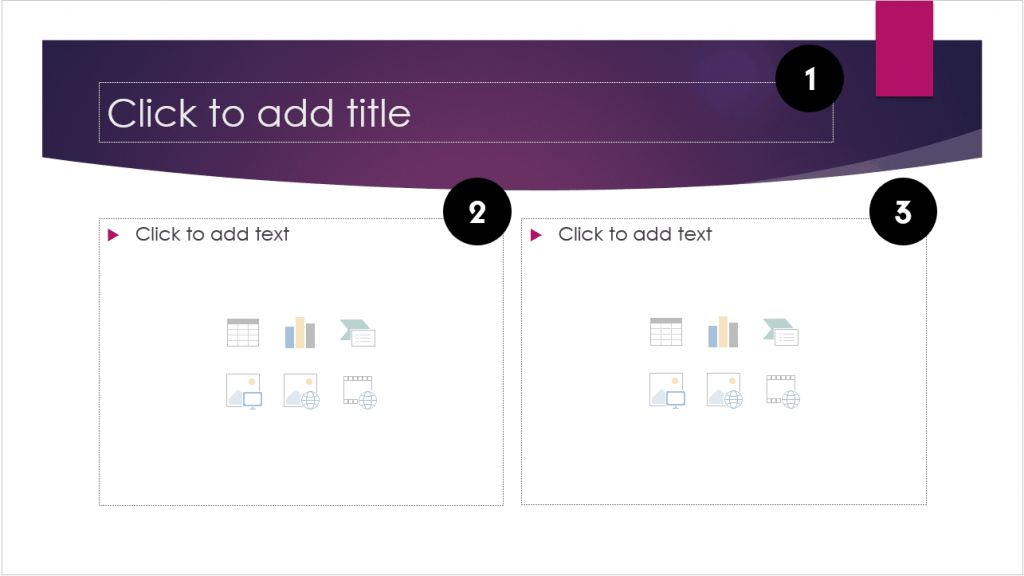
Hitting CTRL+ENTER:
- The first-time cycles to the 1 st placeholder (the title in this case).
- The second-time cycles to 2 nd placeholder
- The third-time cycles to the 3 rd placeholder.
- The fourth time creates a brand new, blank slide.
So, the way the CTRL+ENTER shortcut is different than the CTRL+M shortcut, is that before it creates a new blank slide, it first cycles through all the content placeholders on your slide.
Instead of ending up with a new blank slide, you instead create a duplicate of the slide you were working on (making it easy to save your work).
You can learn more about how to use the duplicate slide shortcut like this here .
What type of new slide is added?
When using the New Slide shortcuts in PowerPoint, the slide layout that is inserted is based on the slide layout you were just on when you used the shortcut.
For example: If you are on the Section Header layout, using the New Slide shortcuts inserts a new blank Section Header layout. If you are on a Comparison layout, using either of the New Slide shortcuts inserts a blank Comparison layout.
The only time this rule doesn’t hold true, is if you use these shortcuts while on the Title slide layout. If you are on the Title Slide layout (for your template), instead of inserting a new Title Slide, the next layout in your slide master will be inserted (most likely a Title and Placeholder layout).
This makes sense too, right?
In a normal presentation you will only have one title slide. So the New Slide shortcuts are smart enough not to insert a second title slide layout, and instead take you to your first content slide layout.
To learn more about our PowerPoint training courses and other free resources, visit us here .
What’s Next?
Related articles.
- What is a broken link chart in PowerPoint (and how to fix it)?
- Bar chart trick: Right aligning categories (PPT, Word, and Excel)
- PowerPoint settings: program level vs. presentation level
- What is a linked Excel chart in PowerPoint?
- Set Up Slide Show: Customize how your PPT presentations run
About The Author
Popular Tutorials
- How to Strikethrough Text (l̶i̶k̶e̶ ̶t̶h̶i̶s̶) in Word, Excel & PowerPoint
- How to Make Animated Fireworks in PowerPoint (Step-by-Step)
- Strikethrough Shortcut (l̶i̶k̶e̶ ̶t̶h̶i̶s̶) for Word, Excel & PowerPoint
- How to Create a Flash Card Memory Game in PowerPoint (Like Jeopardy)
- Keyboard Shortcuts Not Working: Solved
PowerPoint Tutorial Categories
- Strategies & Opinions
- Presentation Design
- Pictures, Icons, Videos, Etc.
- New Features
- Miscellaneous
- Charts & Data Viz
We help busy professionals save hours and gain peace of mind, with corporate workshops, self-paced courses and tutorials for PowerPoint and Word.
Work With Us
- Corporate Training
- Presentation & Template Design
- Courses & Downloads
- PowerPoint Articles
- Word Articles
- Productivity Resources
Find a Tutorial
- Free Training
- For Businesses
We help busy office workers save hours and gain peace of mind, with tips, training and tutorials for Microsoft PowerPoint and Word.
Master Critical PowerPoint Shortcuts – Secure Your FREE Training Module and Save Valuable Time!
⌛ Master time-saving expert techniques.
🔥 Create powerful presentations.
🚀 Propel your career to new heights.
We value your privacy – we keep your info safe.
Discover PowerPoint Hacks Loved by Industry Giants - KKR, AmEx, HSBC!
Over 114,880 professionals in finance, marketing and sales have revolutionized their PPT skills with our proven methods.
Gain FREE access to a full module of our premium PowerPoint training program – Get started today!
We hate spam too and promise to keep your information safe.
You are currently viewing a placeholder content from Facebook . To access the actual content, click the button below. Please note that doing so will share data with third-party providers.
Microsoft Office/Creating and Editing a Presentation
- 1 The PowerPoint Window
- 2.1 Using a Design Template
- 2.2 Using a Blank Presentation
- 3.1 How to Add Slides to a Presentation
- 3.2 How to Change the Layout for any Slide
- 3.3 How to Add Slides in the Outline Tab
- 4.1 Enter Text on a Slide Using Placeholders
- 4.2 Enter Text Using the Outline Tab
- 5.1 How to Insert a Clip Art Image
- 5.2 How to Resize a Clip Art Image
- 6.1 Navigate in a Presentation
- 6.2 Selecting Text
- 6.3 How to Edit Text in a Slide Pane
- 6.4 Move Bulleted Items in the Outline Tab
The PowerPoint Window [ edit | edit source ]

- Title Bar - Displays the name of the application followed by the title of the presentation
- Formatting Toolbar - Provides quick access to commands you need for formatting
- Outline and Slides Tab - The slides tab gives you a thumbnail view of all the slides in the presentation and allows to rearrange their order; the outline tab adds textual content to the slides in an outline format
- Slide Pane - Area where you build the slides for your presentation
- View Buttons - Change the way you view the presentation; the Normal view (left button) is the default, the Slide Sorter view (center button) shows you only the thumbnails and is used to sort and rearrange the presentation, and the Run view (right button) runs the presentation from the current slide
- Drawing Toolbar - Provides all the tools you need to draw and format objects
- Notes Pane - Adds notes for yourself for each slide in your presentation
- Task Pane (Windows version) - Varies based on what you are currently working on; when you first start PowerPoint, you see the New Presentation task pane; other possible tasks include Slide Layout, Slide Design, and Effects
- Menu Bar - Includes all of the PowerPoint menu choices
- Placeholders - Designate the space that will be filled with titles, text, or other objects such as graphics or charts
- Application Close Button (Windows Version) - Exits PowerPoint
- Presentation Close Button (Windows version) - Closes the current presentation

Create a New Presentation [ edit | edit source ]
Using a design template [ edit | edit source ].
- If necessary, choose File > New to display the New Presentation pane
- On the New Presentation pane, click on the From Design Template link
- The Slide Design pane will display on the right side of the screen with a variety of different templates to choose from
- Select the design of your choice from the Slide Design pane
- Click OK to begin working with the first slide in the Normal View
Using a Blank Presentation [ edit | edit source ]
- On the New Presentation pane, click on the Blank Presentation link
This will open a new presentation with no template. You will provide the content, background, color scheme, text format, etc. This method gives you the most freedom, but also requires the most amount of time to complete.
Adding a new slide [ edit | edit source ]
Once you have opened a new presentation, the next step is to add and format the content. PowerPoint provides a selection of pre-defined slide layouts based on different types of content that you can use to quickly add content to the slides. For each of the 27 Slide Layouts provided, PowerPoint combines the four types of placeholders in different combinations; each placeholder will be replaced with the following type of content:
Using a Slide Layout ensures that the text and other elements you enter into the placeholders will have consistent spacing and be optimally arranged.
How to Add Slides to a Presentation [ edit | edit source ]
- Click the New Slide button on the Formatting toolbar.
- From the list of Slide Layouts, select the layout you want to apply to the new slide.
- You may now begin adding content using the placeholders in the layout.
How to Change the Layout for any Slide [ edit | edit source ]
PowerPoint will try to guess what layout you want to use for new slides that are added to the presentation. If you want a different layout for the slide you can quickly change the layout for any slide.
- Display the slide that you want to change in the Slide Pane (work area in the center of the window).
- Choose Format > Slide Layout to display the Slide Layout task pane.
- Click on the layout you want to apply to the slide.
- PowerPoint will attempt to fit existing content into the new layout, but you will probably have to make additional changes.
How to Add Slides in the Outline Tab [ edit | edit source ]
You can also create new slides while working in the Outline tab. By default the Outlining toolbar should display, but if it does not, select View > Toolbars > Outlining .
- Display the Outline tab by clicking on Outline in the pane on the left.
- Place the cursor at the end of the text in the slide you wish the new slide to follow.
- Click the New Slide button to insert a new slide.
Entering Text on a Slide [ edit | edit source ]
Enter text on a slide using placeholders [ edit | edit source ].
- Click on the Title , Subtitle , or Text placeholder.
- Type the text you want.
- If necessary, press [Return] or [Enter] to move to a new line.
- Click anywhere on the slide outside of the placeholder to deselect it.
Enter Text Using the Outline Tab [ edit | edit source ]
Working in the Outline Tab allows you to type and edit text for the presentation in a more word processing-like environment than the Slide pane. The Outline tab displays in the pane on the left side of the screen when you are working in the Normal view.
Information in the Outline tab is arranged by levels. The Title of each slide appears as the first, left-most level next to a numbered icon of the slide. Bulleted text is indented one to four levels to the right of the title. The Outline tab has an Outlining toolbar that displays to the left of the pane.
Tip: If the Outline and Slides panes are not displaying in the Normal view, select View > Normal (restore panes) and it will display on the left side of the screen.
- After adding a new slide, Type the slide title and press [Return] or [Enter] .
- To change the slide text to a first level bullet, press [Tab] or click the Demote button on the Outlining toolbar.
- Type the text for the first bullet and press [Return] or [Enter] to move to the second bullet.
- To create a sub-bullet, press [Tab] and type the text.
- Continue to enter text for bullets and sub-bullets until the slide is complete.
- Use [Return] or [Enter] to create a new instance of the same level you are on. For example, if you are typing a level one bullet, pressing [Return] or [Enter] will create another level one bullet.
- To demote a line of text, use [Tab] or the Demote button. This will make a level one bullet into a level two sub-bullet.
- To promote a line of text, press [Shift] and [Tab] together or click on the Promote button. This will turn a level one bullet into the Title of a new slide.
Adding Clip Art to a Slide [ edit | edit source ]
Effective visuals emphasize the key content points in a presentation. PowerPoint provides a selection of professionally designed pictures, or clip art, that you can use in your presentations. These clip art images include many different themes such as animals, people, buildings, food, holidays, business, and more.
How to Insert a Clip Art Image [ edit | edit source ]
- Move to the slide on which you want to place clip art.
- Apply a Slide Layout that includes a content or clip art placeholder.
- Open the Select a Picture dialog box by:
- Clicking on the Clip Art button on the content placeholder OR
- Double-clicking on the clip art placeholder
- In the Search box, type a word or phrase that describes the clip you want.
- Click Search . PowerPoint displays the search results in the Select Picture List.
- Click on the clip art image you want and click OK .
How to Resize a Clip Art Image [ edit | edit source ]
Once you have added a clip art object to your slide, you can resize it to make it fit better into your presentation.
- Click on the Clip Art object to select it.
- Put the arrow on one of the resize handles at the corner of the picture until the cursor changes to a double-headed arrow.
- Depress the mouse button and drag the handle toward or away from the center to make the image larger or smaller. The corner handles resize the image proportionally and the handles on the sides of the image increase or decrease the height or width of the image. When you release the mouse button, the object appears in its new size.
Editing Slide Text [ edit | edit source ]
You know how to enter text into your presentation, but what happens if you decide you want to change the text? PowerPoint allows you to navigate to a specific slide and change the text.
Navigate in a Presentation [ edit | edit source ]
Selecting text [ edit | edit source ].
Knowing how to select text is a critical skill in all Microsoft Office applications. Selecting text is a necessary step for many procedures such as deleting blocks of text or formatting.
How to Edit Text in a Slide Pane [ edit | edit source ]
You can edit text or move bulleted text in the Slide pane or the Outline tab. To edit text in the Slide pane:
- Select the bulleted text you want to change.
- If necessary, edit the text by:
- Pressing the [Delete] key to delete the text; or
- Typing new text to replace the selected text.
- If necessary, move the bulleted item by:
- Selecting the entire bulleted item; and
- Dragging the item up or down to move it to its new location.
Move Bulleted Items in the Outline Tab [ edit | edit source ]
You can change the order of bulleted items and slides in the Outline tab:
- Select the slide or bulleted item you want to move.
- Click the Move Up or Move Down button on the Outlining toolbar until the slide or bulleted item appears where you want it.
- Book:Microsoft Office
Navigation menu
- PRO Courses Guides New Tech Help Pro Expert Videos About wikiHow Pro Upgrade Sign In
- EDIT Edit this Article
- EXPLORE Tech Help Pro About Us Random Article Quizzes Request a New Article Community Dashboard This Or That Game Popular Categories Arts and Entertainment Artwork Books Movies Computers and Electronics Computers Phone Skills Technology Hacks Health Men's Health Mental Health Women's Health Relationships Dating Love Relationship Issues Hobbies and Crafts Crafts Drawing Games Education & Communication Communication Skills Personal Development Studying Personal Care and Style Fashion Hair Care Personal Hygiene Youth Personal Care School Stuff Dating All Categories Arts and Entertainment Finance and Business Home and Garden Relationship Quizzes Cars & Other Vehicles Food and Entertaining Personal Care and Style Sports and Fitness Computers and Electronics Health Pets and Animals Travel Education & Communication Hobbies and Crafts Philosophy and Religion Work World Family Life Holidays and Traditions Relationships Youth
- Browse Articles
- Learn Something New
- Quizzes Hot
- This Or That Game
- Train Your Brain
- Explore More
- Support wikiHow
- About wikiHow
- Log in / Sign up
- Computers and Electronics
- Presentation Software
- PowerPoint Presentations
How to Add a New Slide in PowerPoint
Last Updated: February 10, 2022
This article was co-authored by wikiHow staff writer, Jack Lloyd . Jack Lloyd is a Technology Writer and Editor for wikiHow. He has over two years of experience writing and editing technology-related articles. He is technology enthusiast and an English teacher. This article has been viewed 52,418 times. Learn more...
This wikiHow will teach you how to add a new slide to your PowerPoint presentation. Adding a new slide in PowerPoint is super simple, but the exact process depends on whether you're using a Mac or PC. Either way, we've got you covered! The steps below will walk you through exactly what you need to do.

- If you decide to reposition your slide, you can click and drag it up or down in the sidebar to do so.

- You can click and drag your slide in the sidebar to reposition it in the presentation's order.
Expert Q&A
- If you want to copy a slide from an existing presentation into your current presentation, simply right-click (or two-finger click) the slide's icon in the sidebar and click Copy . You can then right-click a space in your current presentation's sidebar and click Paste . Thanks Helpful 0 Not Helpful 0
- You can also insert a new slide at any time by clicking the sidebar and then pressing either ⌘ Command + M (Mac) or Ctrl + M (Windows). Thanks Helpful 1 Not Helpful 0

You Might Also Like

About This Article
Mac - Click the Insert tab, then click New Slide . Windows - Right-click the slide sidebar, then click New Slide . Did this summary help you? Yes No
- Send fan mail to authors
Is this article up to date?

Featured Articles

Trending Articles

Watch Articles

- Terms of Use
- Privacy Policy
- Do Not Sell or Share My Info
- Not Selling Info
wikiHow Tech Help Pro:
Level up your tech skills and stay ahead of the curve
- All-Access Subscriptions
- Business Licensing
- Lightroom Classic
- Photoshop Elements
- Crystal Reports
- Interview Skills
- Resume Skills
- Excel for Lawyers
- Outlook for Lawyers
- QuickBooks for Lawyers
- Word for Lawyers
- Microsoft Office Suite
- Outlook on the Web
- Microsoft Project
- Microsoft Teams
- QuickBooks Online
- QuickBooks Pro
- Video Course Options
- SUBSCRIPTIONS
- Photoshop Elements 2024
- Photoshop Elements 2023
- Photoshop Elements 2022
- Photoshop Elements 2021
- Photoshop Elements 2020
- Photoshop Elements 2019
- Photoshop Elements 2018
- Photoshop Elements 15
- Google Classroom for Teachers
- Google Docs
- Google Drive
- Google Forms
- Google Sheets
- Google Slides
- Mac OS Keyboard Shortcuts
- Excel Formulas and Functions
- Excel Keyboard Shortcuts
- Excel Tables PivotTables and Charts
- Access for Microsoft 365
- Excel for Microsoft 365
- Microsoft Office 365
- Outlook for Microsoft 365
- PowerPoint for Microsoft 365
- Publisher for Microsoft 365
- Word for Microsoft 365
- Access 2021
- Microsoft Office 2021
- Outlook 2021
- PowerPoint 2021
- Publisher 2021
- Access 2019
- Microsoft Office 2019
- Outlook 2019
- PowerPoint 2019
- Publisher 2019
- Access 2016
- Microsoft Office 2016
- OneNote 2016
- Outlook 2016
- PowerPoint 2016
- Publisher 2016
- Microsoft Office 2013
- OneNote 2013
- Outlook 2013
- PowerPoint 2013
- Microsoft Office for iPad
- QuickBooks Pro 2024
- QuickBooks Pro 2023
- QuickBooks Pro 2022
- QuickBooks Pro 2021
- QuickBooks Pro 2020
- QuickBooks Pro 2019
- QuickBooks Pro 2018
- QuickBooks Pro 2017
- QuickBooks Pro 2016
- QuickBooks Pro 2015
- QuickBooks Pro 2014
- Sage 50 Accounting
- Windows 11 and 10 Keyboard Shortcuts
- Chrome OS for Chromebooks
- Word and Excel (Mac) 2022
- Word and Excel (PC/Windows) 2021-2016 and 365
- QuickBooks Desktop (PC/Windows) 2024
- QuickBooks Desktop (PC/Windows) 2023
- QuickBooks Desktop (PC/Windows) 2022-2015
- Windows 11 and 10
- Our History
- Customer Service
- Testimonials
- Lost Password
- Register a Product
- Manage My Account
- Member Login
Try the PowerPoint Course for Free!
Insert a new slide in powerpoint- instructions, how to insert a new slide in powerpoint: video.
This video lesson, titled “ Inserting New Slides ,” shows how to insert a new slide in PowerPoint. This video lesson on how to add a new slide in PowerPoint is from our complete PowerPoint tutorial , titled “ Mastering PowerPoint Made Easy v.2019 and 365 .”
Overview of How to Insert a New Slide in PowerPoint:
This tutorial shows you how to insert a new slide in PowerPoint. When you create a new blank presentation in PowerPoint, one default slide that contains a “Title Slide” layout appears. You can click into the placeholders shown in the title slide and type the text you want to have appear as the title and subtitle of your presentation.
To add another slide to your presentation, you must then insert a new slide and determine which placeholders appear in the slide. The slide layout you select for the inserted slide determines which placeholders appear within it. You can, however, also change the layout applied to a slide after you insert it to change its placeholders.
To insert a new slide in PowerPoint with a “Title and Content” slide layout, click the “Home” tab in the Ribbon. Then click the “New Slide” button in the “Slides” button group. Alternatively, to insert a new slide with a different slide layout, click the “Home” tab in the Ribbon. Then click the drop-down part of the “New Slide” button in the “Slides” button group. The drop-down menu that then appears shows the other available slide layouts. Click the name of the desired slide layout in the drop-down menu to insert a new slide with the selected layout.
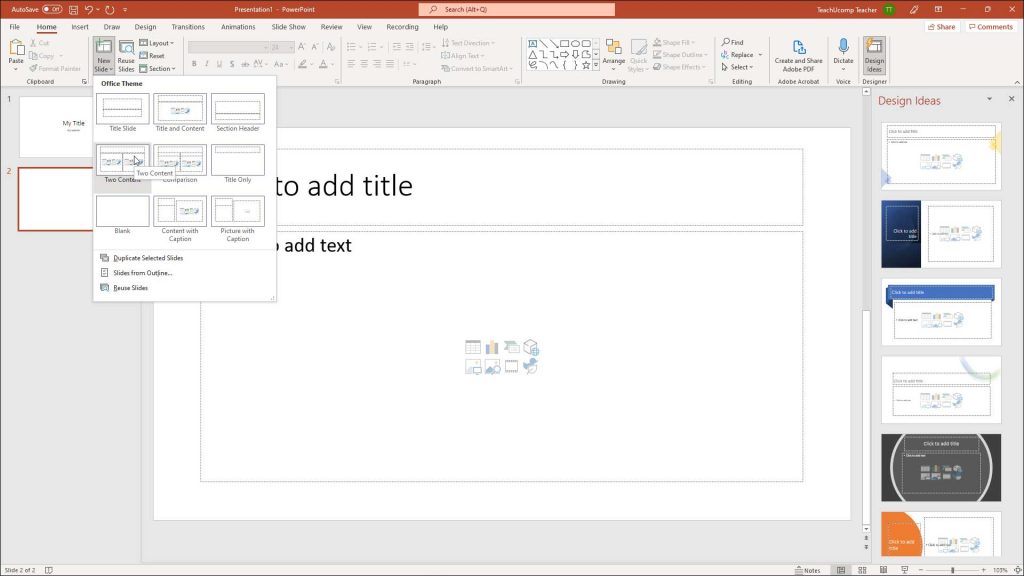
A picture that shows how to insert a new slide in PowerPoint by selecting a slide layout to insert into the presentation.
Instructions on how to add a new slide in powerpoint:.
- To add a new slide with a “Title and Content” slide layout in PowerPoint , click the “Home” tab in the Ribbon.
- Then click the “New Slide” button in the “Slides” button group.
- Alternatively, to add a new slide with a different slide layout , click the “Home” tab in the Ribbon.
- Then click the drop-down part of the “New Slide” button in the “Slides” button group to show a drop-down menu that shows the other available slide layouts.
- Then click the name of the desired slide layout in the drop-down menu to insert a new slide with the selected layout.
About Joseph Brownell


How to Use Copilot in PowerPoint
Create beautiful presentations with a simple prompt with Copilot!

If you've stared down the blank screen of Microsoft PowerPoint and desperately wished that there was someone who could assist you with the daunting task of creating the perfect presentation, Microsoft has decided to take on the role of a genie and grant your wish.
With the latest Copilot Pro subscription , you get the power of an AI companion by your side in Microsoft apps like Word , PowerPoint, Excel, etc. Here's everything you need to know about Copilot in PowerPoint.
Get Copilot in PowerPoint
Once both subscriptions are active for your account, Copilot should automatically appear in PowerPoint. However, if it doesn't, it's easy to get it.
- If you can't see the Copilot button, then quit Microsoft PowerPoint – all instances of it. On Windows, it includes simply clicking the 'Close' button. On Mac, you'll want to right-click the app icon from the dock and click 'Quit' from the context menu to completely close the app.
- Re-open PowerPoint, and you should see the Copilot button on the Home tab ribbon.
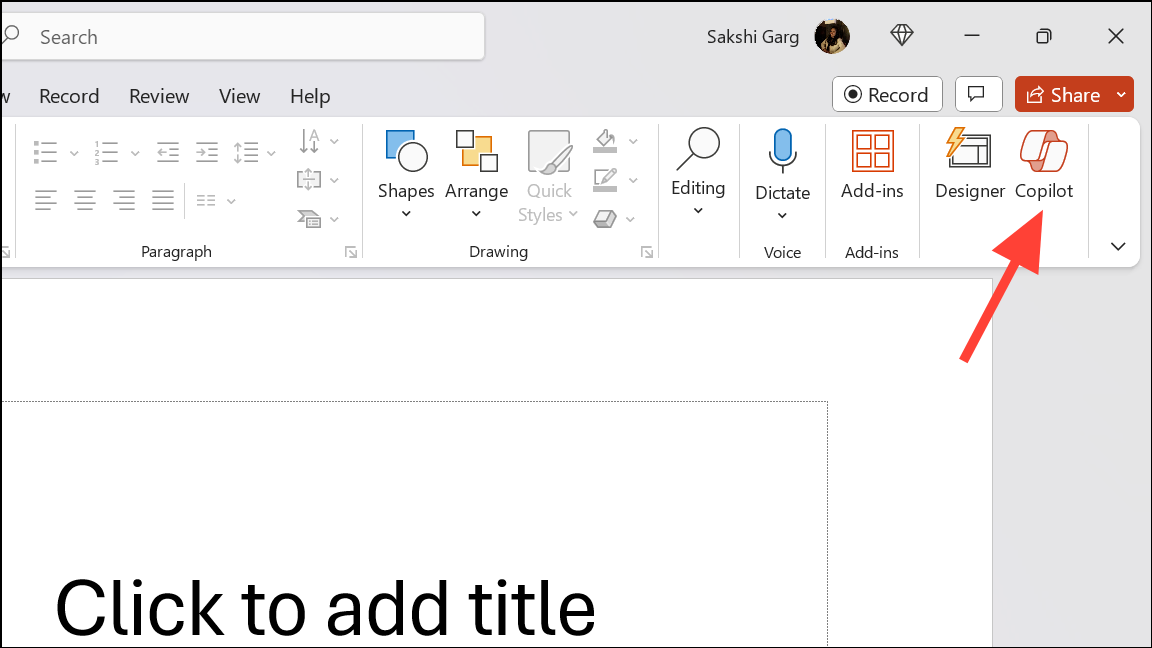
- If that doesn't work, go to the 'File' option from the menu bar.

- Navigate to 'Account'.
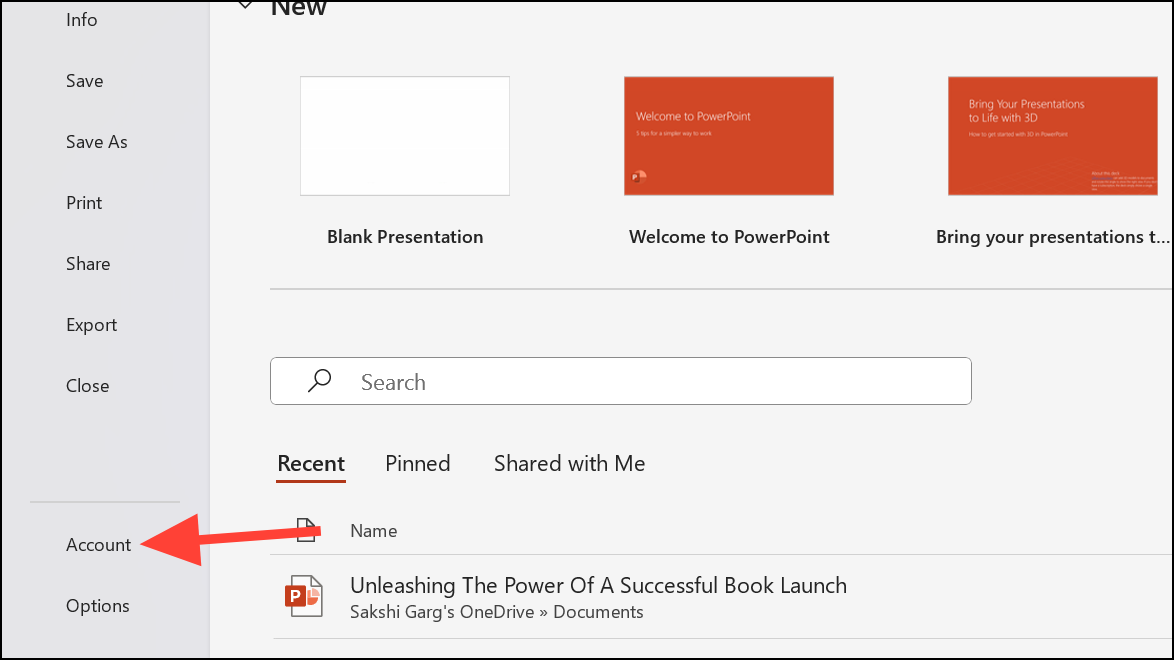
- Click the 'Update License' button.
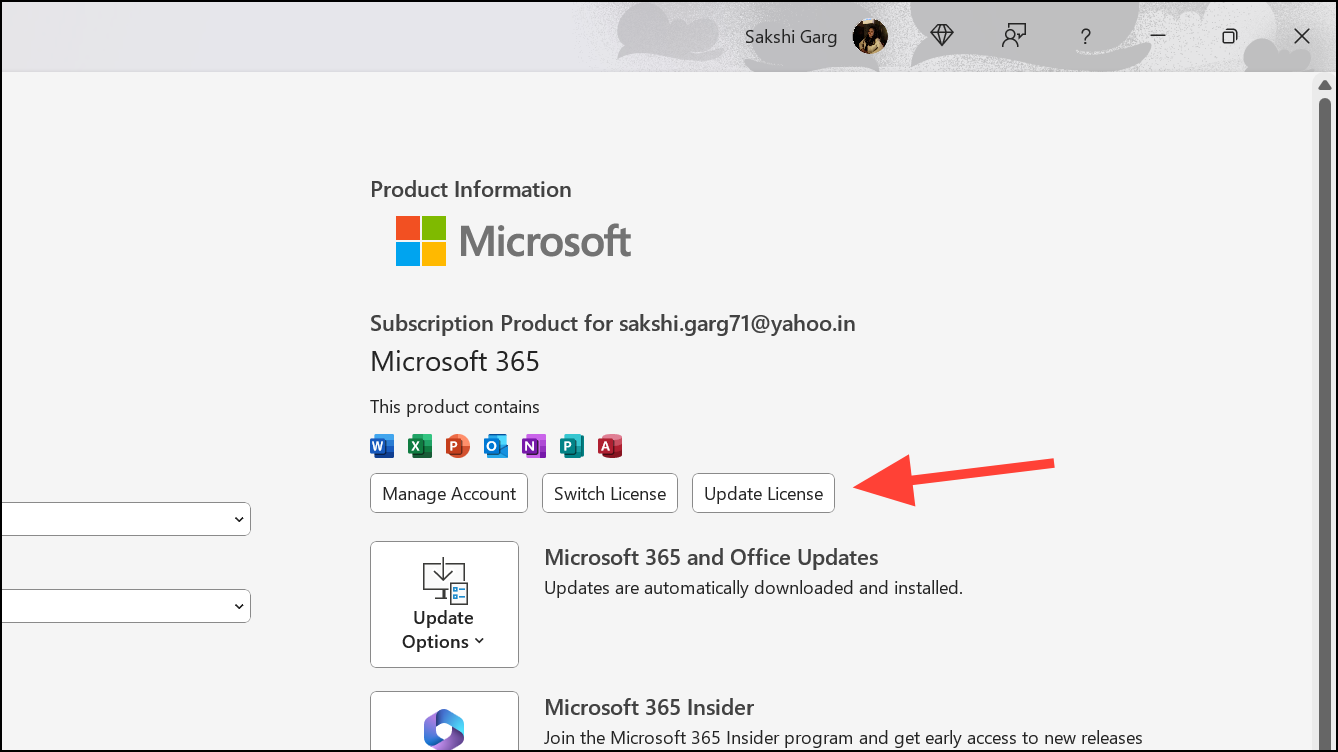
- You'll need to sign in to verify your subscription. Click on the 'Sign in' button and log into your Microsoft account.
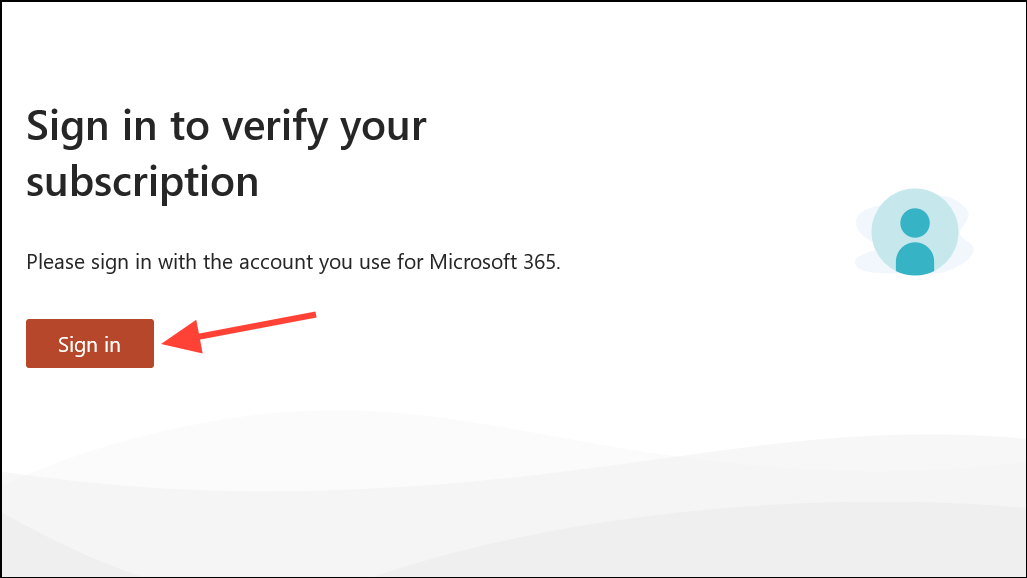
- Once you're logged in, close and re-open the app, and you should get the Copilot button.
Using Copilot in PowerPoint
With Copilot in PowerPoint, you can create new presentations, edit and organize existing ones, summarize them, or even ask questions related to them. Copilot can create amazing presentations from scratch using Microsoft templates.
The AI companion is currently available on the web, Windows, Mac, and iPad apps for PowerPoint if you have Copilot Pro and Microsoft 365 Personal or Family subscriptions. The company soon plans to bring support for the feature to iOS and Android apps. Here's everything you can do with Copilot in PowerPoint.
Creating a New Presentation with Copilot
Copilot can help you churn out a new presentation on any topic quickly.
- Open a blank presentation in PowerPoint and click the 'Copilot' button from the Home ribbon.
- The Copilot panel will open on the right.
- Click on 'Create a presentation' to load it into the prompt area and enter your topic in the prompt. You can also add any context, notes, or outlines in the prompt that you want the AI to keep in reference. However, the input window for a prompt is only 2000 characters, so that severely limits the context you can provide with Copilot Pro when compared to the Copilot for Microsoft 365 subscription for Enterprise/ Business customers. You also cannot provide your files to create a presentation from with Copilot Pro unlike Copilot for Businesses.
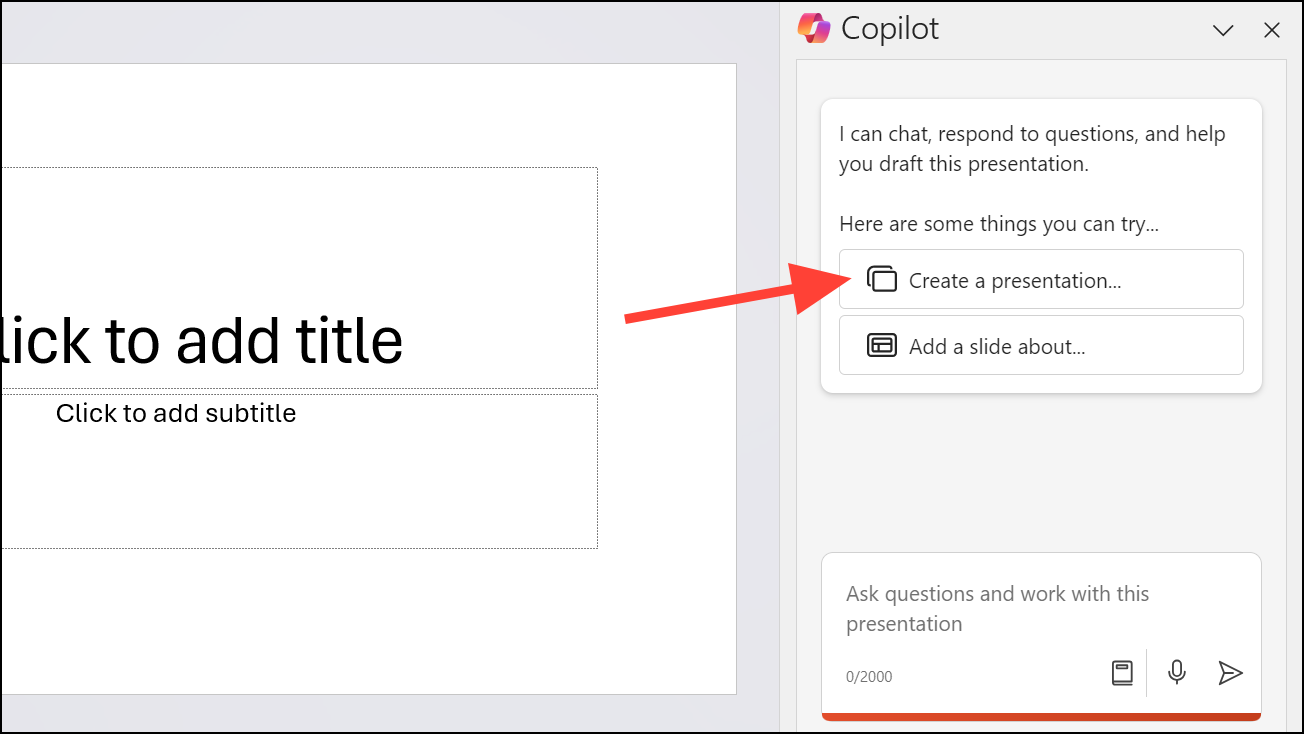
- You can also use voice typing to dictate the prompt by clicking the 'Microphone' icon.
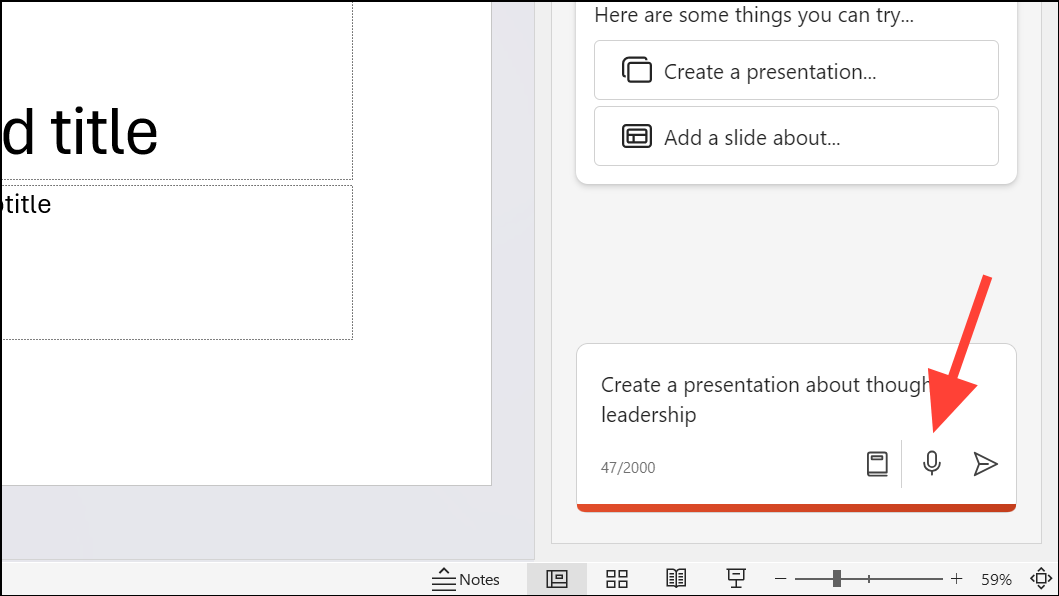
- Click on the 'Send' button to send your request.
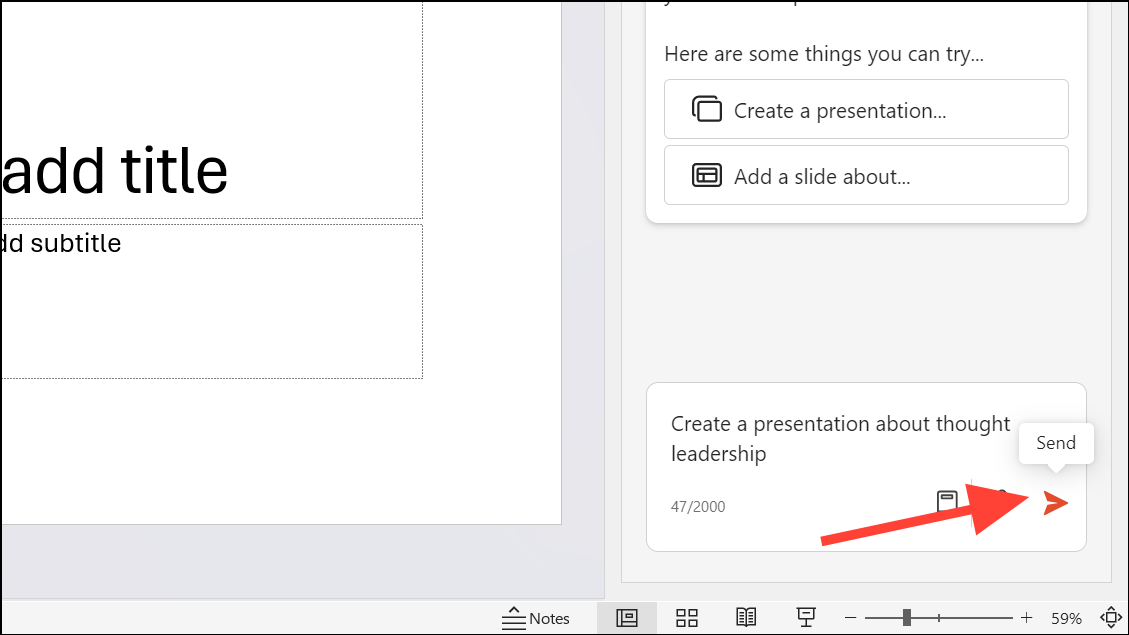
- Copilot will start working on generating the presentation. You can click on 'Stop Generating' if you want to interrupt it in the middle.
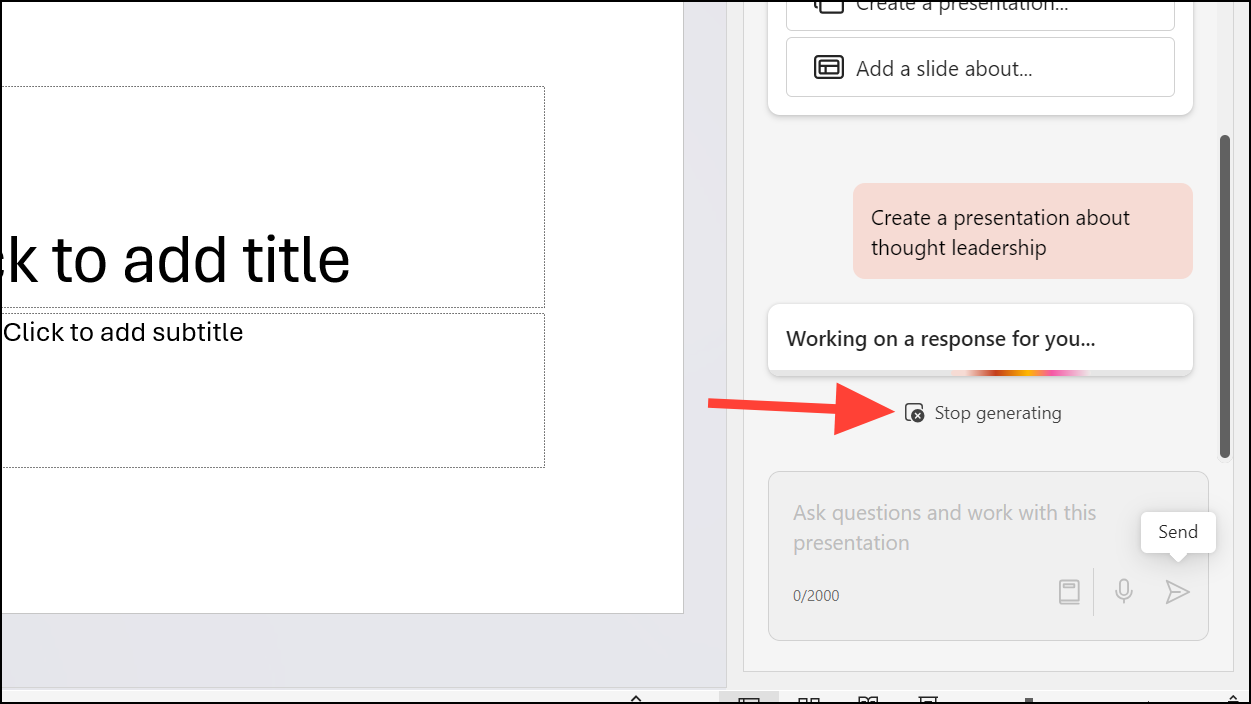
- Once Copilot is done, you'll have a basic presentation with a few slides with images and text that use a consistent template.
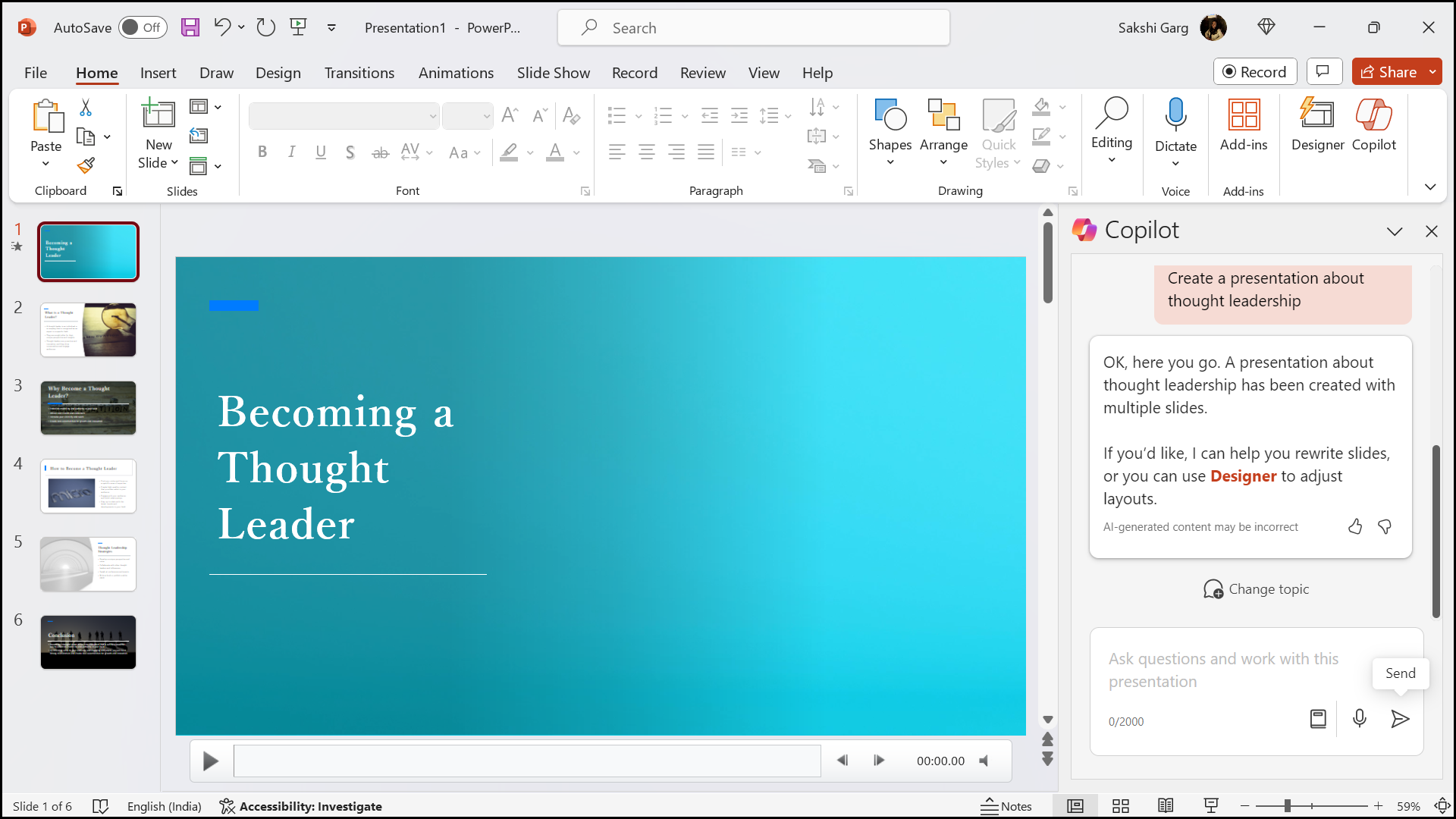
Adding Slides and Images with Copilot
Copilot can also help you add additional slides to your presentation.
- Open the Copilot chat interface.
- Then, click the 'Add a slide about' option from the interface and fill in the rest of the prompt describing the topic of slide you want Copilot to add. For example, enter the prompt 'Add a slide about Growth Mindset'.
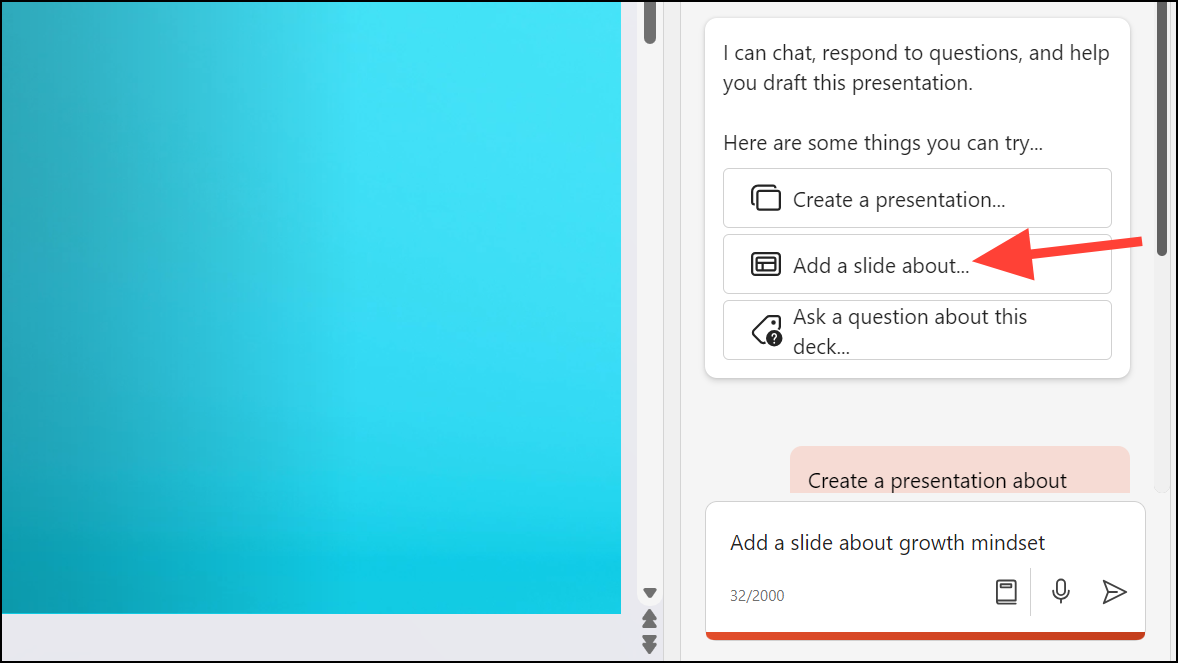
- Copilot will add a new slide after the current slide. So, make sure that you select the slide after which you want to insert the new slide before you send your request to Copilot. Of course, you can always drag and drop the slides to rearrange them even if you forget to do that.
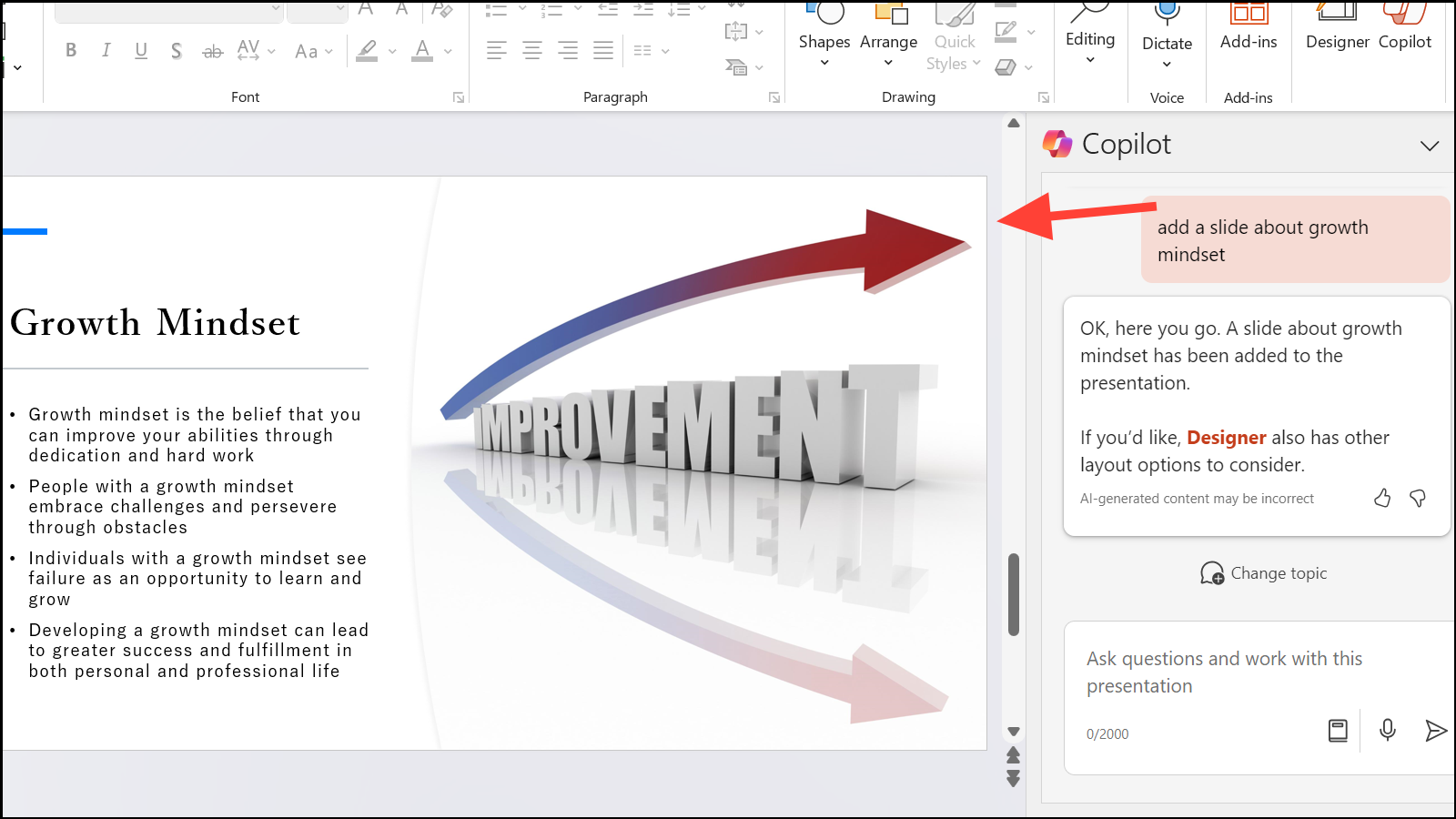
Copilot can also add more images to the presentation to make it more appealing.
- Go to the prompt area in the Copilot chat panel.
- Then, prompt it with 'Add a image about [topic] in [slide number]'.
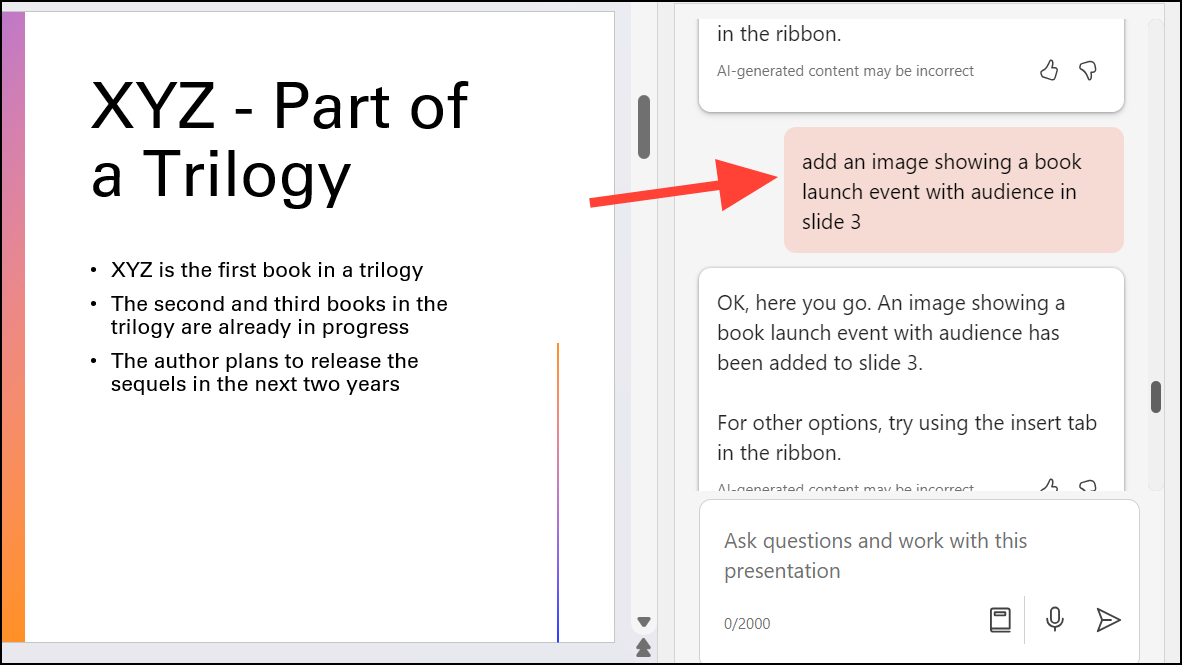
- And it will find and add an image to the slide from the stock images. If you don't mention the slide number, it will add the image to the selected slide. It will also redesign the slide to accomodate the image in the best way possible but you can always find more ideas for the layout using the 'Designer' feature in PowerPoint.
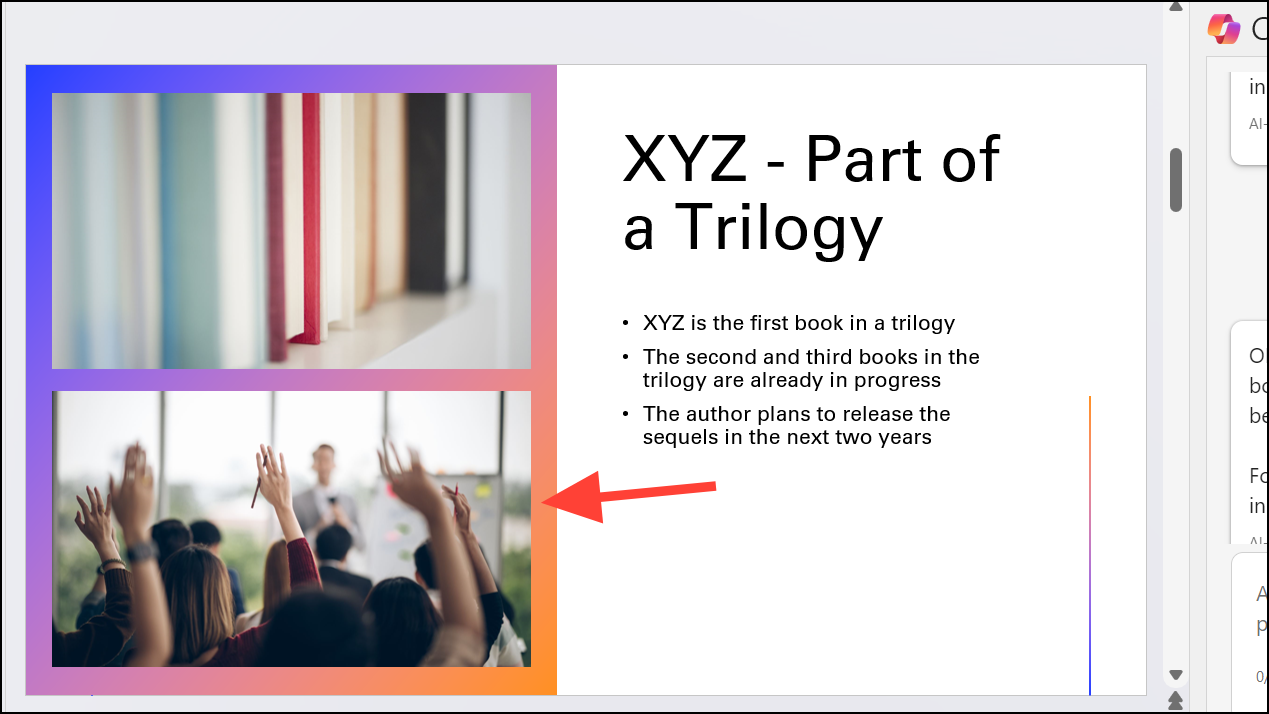
Organize Slides with Copilot
Another thing Copilot can do for you in PowerPoint is organize the presentation for you.
- Go to the prompt area and send the prompt 'Organize this presentation' to Copilot.

- Once Copilot is done processing the request, it'll organize the presentation by grouping the slides into different sections and adding new slides whereever required.

- You can see the actions taken by the AI companion outlines in its response as well.

For large presentations with a huge number of slides, this can be of great help.
Interact with a Presentation
Other than creating a presentation, Copilot in PowerPoint can help you interact with and understand a presentation. It's especially great for large presentations that have been shared with you. It can provide summaries, answer questions and more. Here's how:
- To get a summary of the presentation, simple ask Copilot to 'Summarize this presentation'.

- Copilot will generate a summary of the presentation along with citations from the presentation so you can refer to where the information came from.
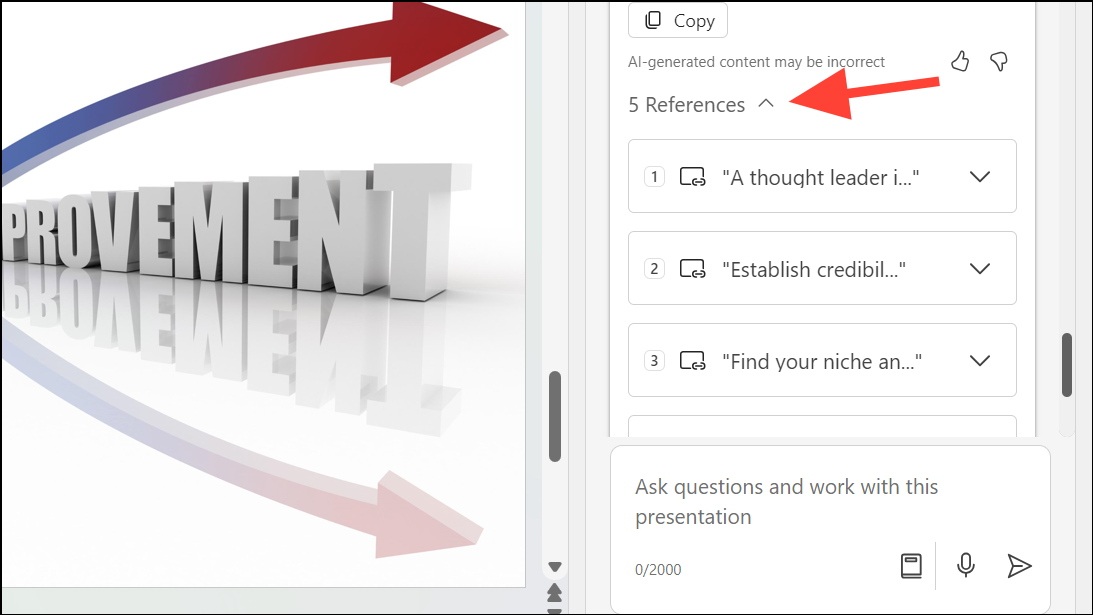
- Another prompt you can try is 'Show Key Slides from this deck'.
- Copilot will then show you slides from the presentation that it considers important.

- Similarly, Copilot can also find action items with the prompt 'Show action items in this presentation'.
- You can also ask any questions you might have and it'll answer them based on the information in the deck. For example, you can ask if there are any dates or deadlines in the presentation. Or, you can ask about a particular concept and it'll provide answers.
- It can also answer your questions from outside the presentation using information from the Internet so you can also use it for research without having to switch apps.
View More Prompts
- To get further help from Copilot, click the 'View Prompt' button.

- You'll see some examples of different types of requests you can put to Copilot. Click on 'View more prompts'.
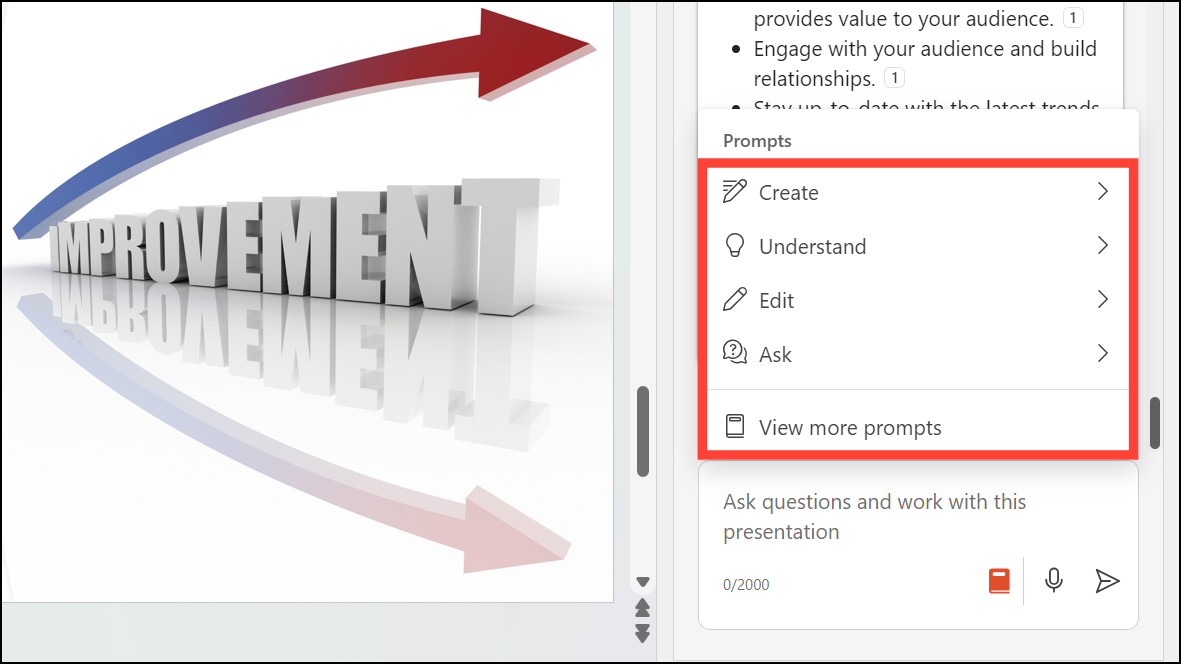
- This will open the Copilot lab where you can get examples of various prompts you can send to the AI.

That's all. Creating and editing presentations is now more efficient, with Copilot Pro creating new presentations from scratch and simplifying the addition of slides, images, and content organization.

11 Ways GPT-4o is a Game Changer

How to Use Gemini Code Assist in VS Code

How to Code Using AI
Get all the latest posts delivered straight to your inbox., member discussion.

What are Copilot Agents from Microsoft?

How to Use Copilot in Teams Meetings

Microsoft Copilot Pro Review: There is a lot of Unrealized Potential
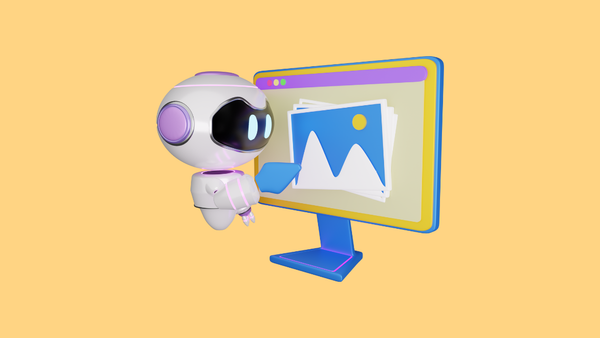
How To Edit Images Generated By Copilot AI

How to Create a Custom Copilot GPT

Introducing Copilot+ PCs
May 20, 2024 | Yusuf Mehdi - Executive Vice President, Consumer Chief Marketing Officer
- Share on Facebook (opens new window)
- Share on Twitter (opens new window)
- Share on LinkedIn (opens new window)

An on-demand recording of our May 20 event is available .
Today, at a special event on our new Microsoft campus, we introduced the world to a new category of Windows PCs designed for AI, Copilot+ PCs.
Copilot+ PCs are the fastest, most intelligent Windows PCs ever built. With powerful new silicon capable of an incredible 40+ TOPS (trillion operations per second), all – day battery life and access to the most advanced AI models, Copilot+ PCs will enable you to do things you can’t on any other PC. Easily find and remember what you have seen in your PC with Recall, generate and refine AI images in near real-time directly on the device using Cocreator, and bridge language barriers with Live Captions, translating audio from 40+ languages into English .
These experiences come to life on a set of thin, light and beautiful devices from Microsoft Surface and our OEM partners Acer, ASUS, Dell, HP, Lenovo and Samsung, with pre-orders beginning today and availability starting on June 18. Starting at $999, Copilot+ PCs offer incredible value.
This first wave of Copilot+ PCs is just the beginning. Over the past year, we have seen an incredible pace of innovation of AI in the cloud with Copilot allowing us to do things that we never dreamed possible. Now, we begin a new chapter with AI innovation on the device. We have completely reimagined the entirety of the PC – from silicon to the operating system, the application layer to the cloud – with AI at the center, marking the most significant change to the Windows platform in decades.
YouTube Video
The fastest, most secure Windows PCs ever built
We introduced an all-new system architecture to bring the power of the CPU, GPU, and now a new high performance Neural Processing Unit (NPU) together. Connected to and enhanced by the large language models (LLMs) running in our Azure Cloud in concert with small language models (SLMs), Copilot+ PCs can now achieve a level of performance never seen before. They are up to 20x more powerful [1] and up to 100x as efficient [2] for running AI workloads and deliver industry-leading AI acceleration. They outperform Apple’s MacBook Air 15” by up to 58% in sustained multithreaded performance [3] , all while delivering all-day battery life. With incredible efficiency, Copilot+ PCs can deliver up to 22 hours of local video playback or 15 hours of web browsing on a single charge. [4] That is up to 20% more battery in local video playback than the MacBook Air 15”. [5]
Windows now has the best implementation of apps on the fastest chip, starting with Qualcomm. We now offer more native Arm64 experiences than ever before, including our fastest implementation of Microsoft 365 apps like Teams, PowerPoint, Outlook, Word, Excel, OneDrive and OneNote. Chrome, Spotify, Zoom, WhatsApp, Adobe Photoshop, Adobe Lightroom, Blender, Affinity Suite, DaVinci Resolve and many more now run natively on Arm to give you great performance with additional apps, like Slack, releasing later this year. In fact, 87% of the total app minutes people spend in apps today have native Arm versions. [6] With a powerful new emulator, Prism, your apps run great, whether native or emulated.
Every Copilot+ PC comes secured out of the box. The Microsoft Pluton Security processor will be enabled by default on all Copilot+ PCs and we have introduced a number of new features, updates and defaults to Windows 11 that make it easy for users to stay secure. And, we’ve built in personalized privacy controls to help you protect what’s important to you. You can read more about how we are making Windows more secure here .
Entirely new, powerful AI experiences
Copilot+ PCs leverage powerful processors and multiple state-of-the-art AI models, including several of Microsoft’s world-class SLMs, to unlock a new set of experiences you can run locally, directly on the device. This removes previous limitations on things like latency, cost and even privacy to help you be more productive, creative and communicate more effectively.
Recall instantly
We set out to solve one of the most frustrating problems we encounter daily – finding something we know we have seen before on our PC. Today, we must remember what file folder it was stored in, what website it was on, or scroll through hundreds of emails trying to find it.
Now with Recall, you can access virtually what you have seen or done on your PC in a way that feels like having photographic memory. Copilot+ PCs organize information like we do – based on relationships and associations unique to each of our individual experiences. This helps you remember things you may have forgotten so you can find what you’re looking for quickly and intuitively by simply using the cues you remember. [7]
You can scroll across time to find the content you need in your timeline across any application, website, document, or more. Interact intuitively using snapshots with screenray to help you take the next step using suggested actions based on object recognition. And get back to where you were, whether to a specific email in Outlook or the right chat in Teams.
Recall leverages your personal semantic index, built and stored entirely on your device. Your snapshots are yours; they stay locally on your PC. You can delete individual snapshots, adjust and delete ranges of time in Settings, or pause at any point right from the icon in the System Tray on your Taskbar. You can also filter apps and websites from ever being saved. You are always in control with privacy you can trust.
Cocreate with AI-powered image creation and editing, built into Windows
Since the launch of Image Creator, almost 10 billion images have been generated, helping more people bring their ideas to life easily by using natural language to describe what they want to create. Yet, today’s cloud offerings may limit the number of images you can create, keep you waiting while the artwork processes or even present privacy concerns. By using the Neural Processing Units (NPUs) and powerful local small language models, we are bringing innovative new experiences to your favorite creative applications like Paint and Photos.
Combine your ink strokes with text prompts to generate new images in nearly real time with Cocreator. As you iterate, so does the artwork, helping you more easily refine, edit and evolve your ideas. Powerful diffusion-based algorithms optimize for the highest quality output over minimum steps to make it feel like you are creating alongside AI. Use the creativity slider to choose from a range of artwork from more literal to more expressive. Once you select your artwork, you can continue iterating on top of it, helping you express your ideas, regardless of your creative skills.
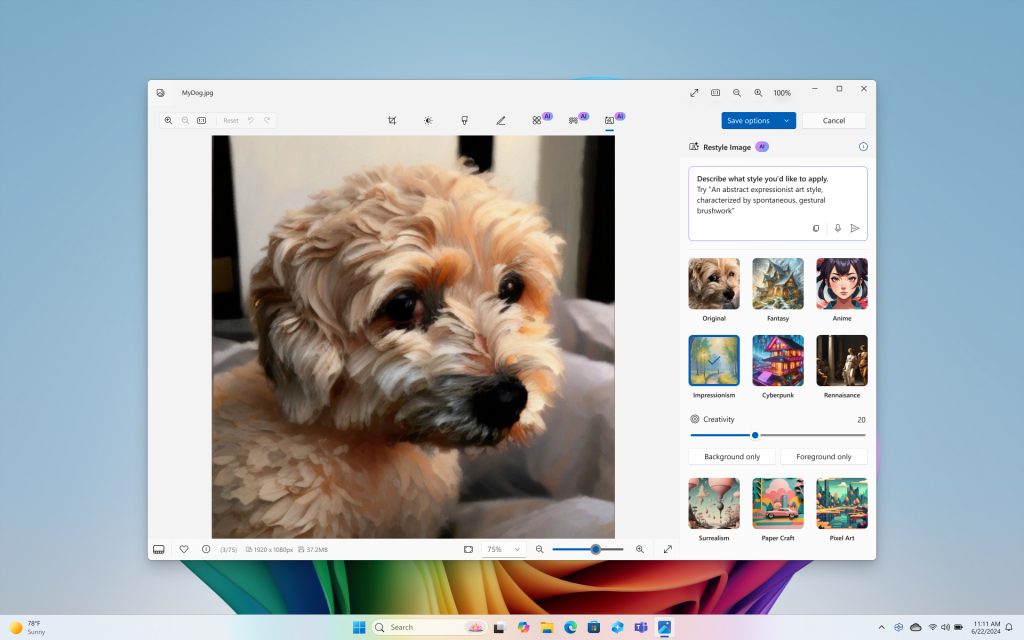
Take photo editing and image creation to the next level. With Restyle Image, you can reimagine your personal photos with a new style combining image generation and photo editing in Photos. Use a pre-set style like Cyberpunk or Claymation to change the background, foreground or full picture to create an entirely new image. Or jumpstart your next creative project and get visual inspiration with Image Creator in Photos. On Copilot+ PCs you can generate endless images for free, fast, with the ability to fine tune images to your liking and to save your favorites to collections.
Innovative AI experiences from the creative apps you love
We are also partnering with some of the biggest and most-loved applications on the planet to leverage the power of the NPU to deliver new innovative AI experiences.
Together with Adobe, we are thrilled to announce Adobe’s flagship apps are coming to Copilot+ PCs, including Photoshop, Lightroom and Express – available today. Illustrator, Premiere Pro and more are coming this summer. And we’re continuing to partner to optimize AI in these apps for the NPU. For Adobe Creative Cloud customers, they will benefit from the full performance advantages of Copilot+ PCs to express their creativity faster than ever before.
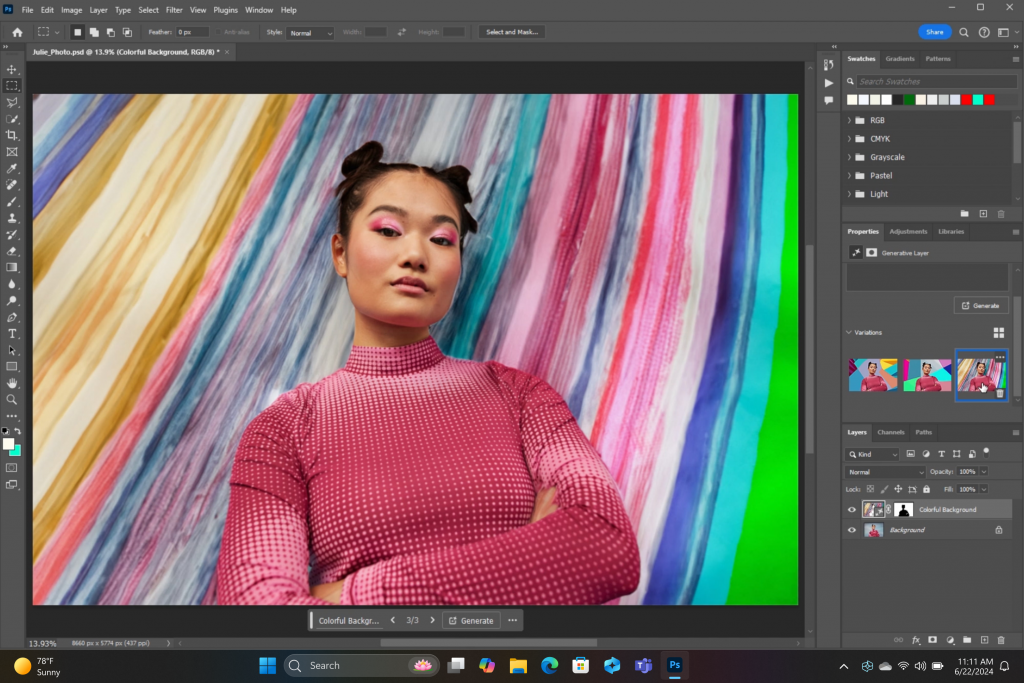
DaVinci Resolve Studio
Effortlessly apply visual effects to objects and people using NPU-accelerated Magic Mask in DaVinci Resolve Studio.
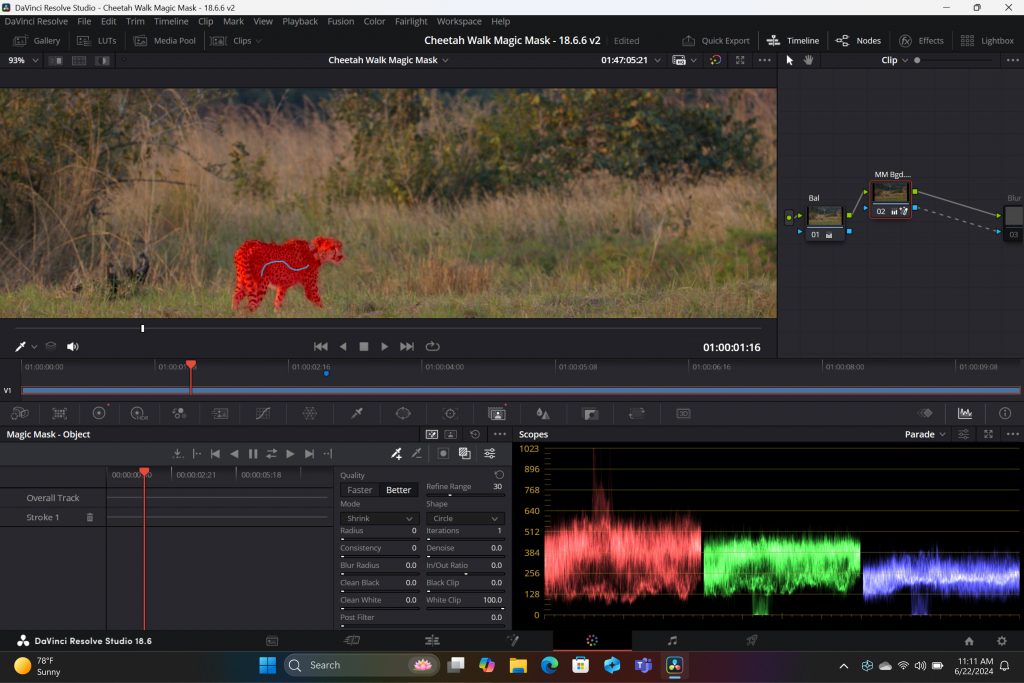
Remove the background from any video clip in a snap using Auto Cutout running on the NPU in CapCut.

Stay in your flow with faster, more responsive adaptive input controls, like head movement or facial expressions via the new NPU-powered camera pipeline in Cephable.
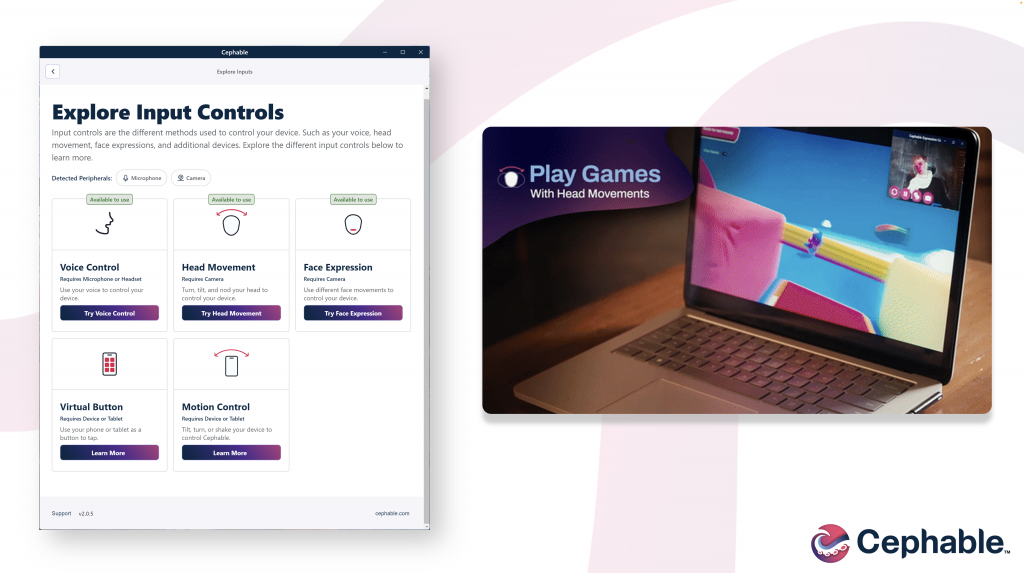
LiquidText
Make quicker and smarter annotations to documents, using AI features that run entirely on-device via NPU, so data stays private in LiquidText.
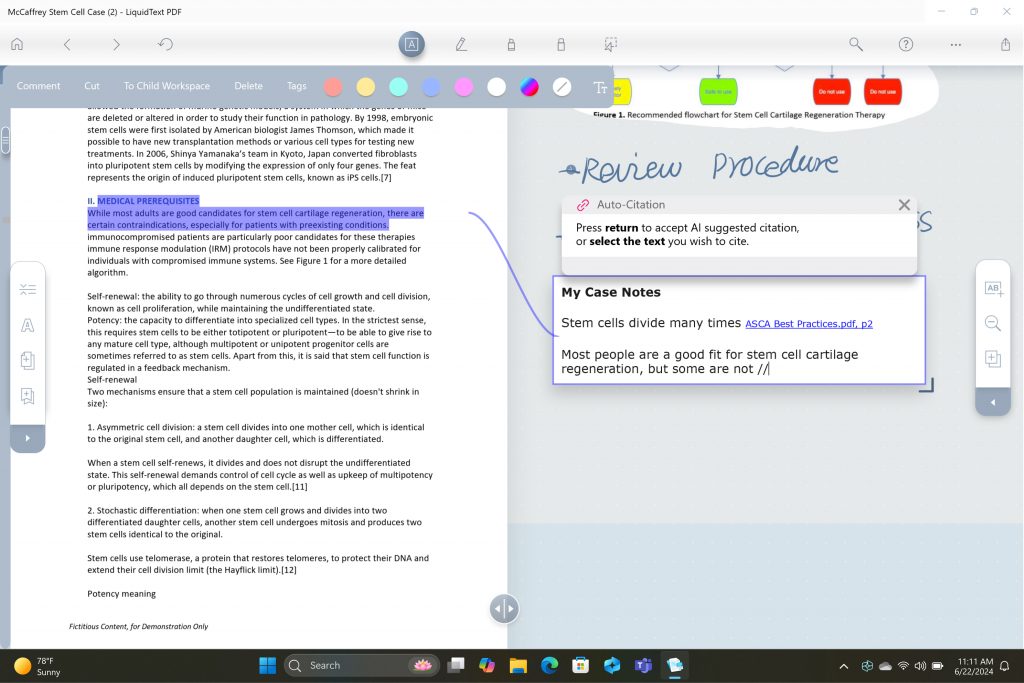
Have fun breaking down and remixing any music track, with a new, higher-quality version of NeuralMix™ that’s exclusive to NPU in Algoriddim’s djay Pro.
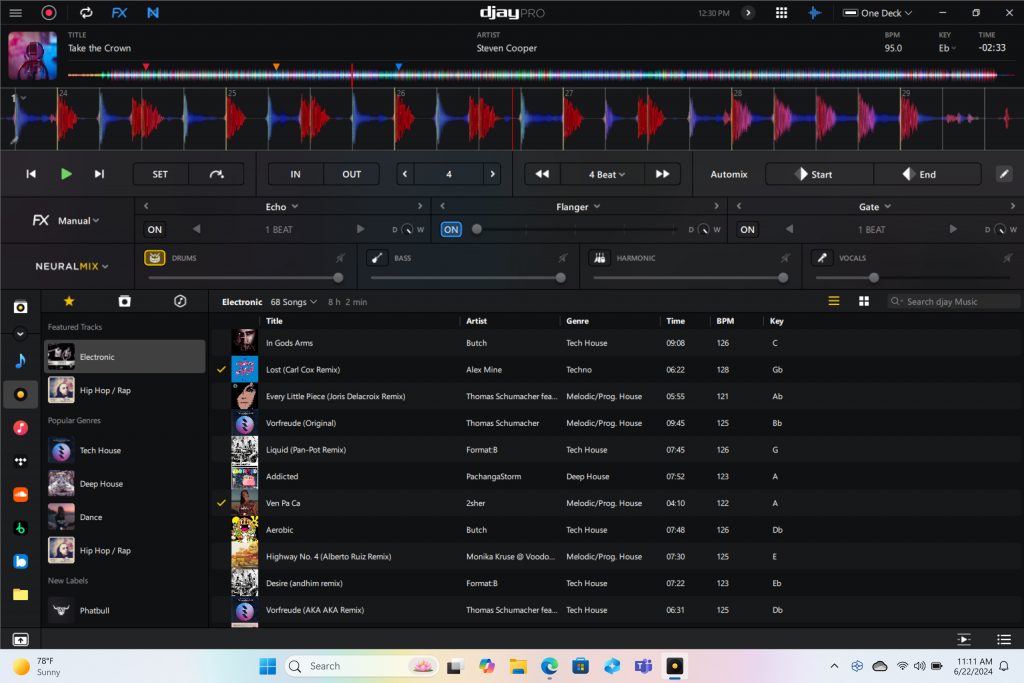
Connect and communicate effortlessly with live captions
In an increasingly connected and global world, Windows wants to bring people closer together. Whether catching up on your favorite podcast from a different country, or watching your favorite international sports team, or even collaborating with friends and colleagues across the world, we want to make more content accessible to more people.
Live Captions now has live translations and will turn any audio that passes through your PC into a single, English-language caption experience, in real time on your screen across all your apps consistently. You can translate any live or pre-recorded audio in any app or video platform from over 40 languages into English subtitles instantly, automatically and even while you’re offline. Powered by the NPU and available across all Copilot+ PCs, now you can have confidence your words are understood as intended.
New and enhanced Windows Studio Effects
Look and sound your best automatically with easily accessible controls at your fingertips in Quick Settings. Portrait light automatically adjusts the image to improve your perceived illumination in a dark environment or brighten the foreground pixels when in a low-light environment. Three new creative filters (illustrated, animated or watercolor) add an artistic flare. Eye contact teleprompter helps you maintain eye contact while reading your screen. New improvements to voice focus and portrait blur help ensure you’re always in focus.
Copilot, your everyday AI companion

Every Copilot+ PC comes with your personal powerful AI agent that is just a single tap away on keyboards with the new Copilot key. [8] Copilot will now have the full application experience customers have been asking for in a streamlined, simple yet powerful and personal design. Copilot puts the most advanced AI models at your fingertips. In the coming weeks, get access to the latest models including GPT-4o from our partners at OpenAI, so you can have voice conversations that feel more natural.
Advancing AI responsibly
At Microsoft, we have a company-wide commitment to develop ethical, safe and secure AI. Our responsible AI principles guided the development of these new experiences, and all AI features are aligned with our standards. Learn more here .
New Copilot+ PCs from Microsoft Surface and our partners
We have worked with each of the top OEMs — Acer, ASUS, Dell, HP, Lenovo, Samsung — and of course Surface, to bring exciting new Copilot+ PCs that will begin to launch on June 18. Starting at $999, these devices are up to $200 less than similar spec’d devices [9] .
Surface plays a key role in the Windows ecosystem, as we design software and hardware together to deliver innovative designs and meaningful experiences to our customers and fans. We are introducing the first-ever Copilot+ PCs from Surface: The all-new Surface Pro and Surface Laptop.
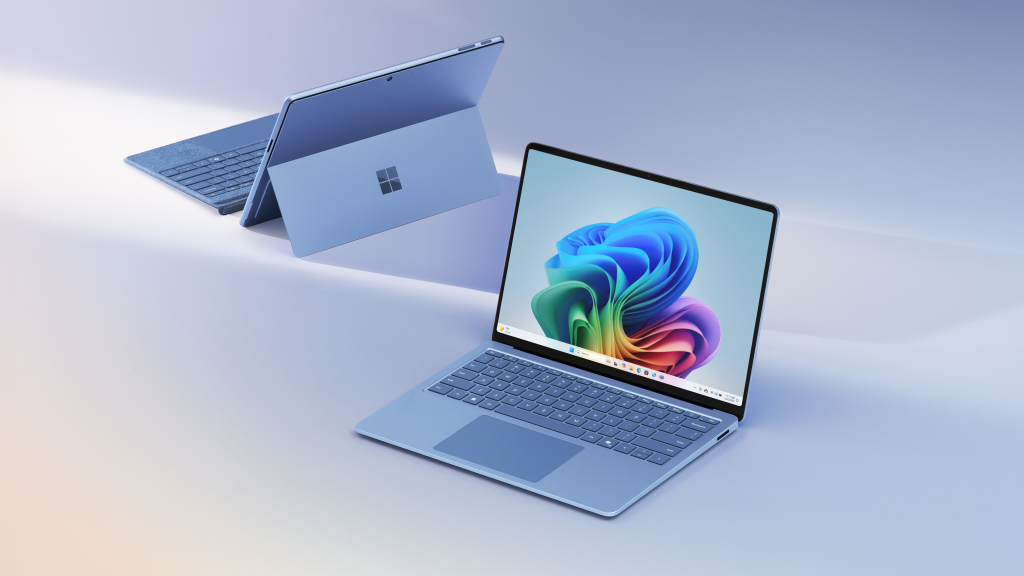
The new Surface Laptop is a powerhouse in an updated, modern laptop design with razor-thin bezels, a brilliant touchscreen display, AI-enhanced camera, premium audio, and now with a haptic touchpad.
Choose between a 13.8” and 15” display and four stunning colors. Enjoy up to 22 hours of local video playback on Surface Laptop 15” or up to 20 hours on Surface Laptop13.8” on top of incredible performance and all-new AI experiences.
The new Surface Pro is the most flexible 2-in-1 laptop, now reimagined with more speed and battery life to power all-new AI experiences. It introduces a new, optional OLED with HDR display, and ultrawide field of view camera perfect for Windows Studio Effects. The new Surface Pro Flex Keyboard is the first 2-in-1 keyboard designed to be used both attached or detached. It delivers enhanced stability, with Surface Slim Pen storage and charging integrated seamlessly, as well as a quiet, haptic touchpad. Learn more here.
New Copilot+ PCs from the biggest brands available starting June 18:
- Acer : Acer’s Swift 14 AI 2.5K touchscreen enables you to draw and edit your vision with greater accuracy and with color-accurate imagery. Launch and discover AI-enhanced features, like Acer PurifiedVoice 2.0 and Purified View, with a touch of the dedicated AcerSense button.
- ASUS : The ASUS Vivobook S 15 is a powerful device that brings AI experiences to life with its Snapdragon X Elite Platform and built-in Qualcomm® AI. It boasts 40+ NPU TOPS, a dual-fan cooling system, and up to 1 TB of storage. Next-gen AI enhancements include Windows Studio effects v2 and ASUS AiSense camera, with presence-detection capabilities for Adaptive Dimming and Lock. Built for portability, it has an ultra-slim and light all-metal design, a high-capacity battery, and premium styling with a single-zone RGB backlit keyboard.
- Dell : Dell is launching five new Copilot+ PCs, including the XPS 13, Inspiron 14 Plus, Inspiron 14, Latitude 7455, and Latitude 5455, offering a range of consumer and commercial options that deliver groundbreaking battery life and unique AI experiences. The XPS 13 is powered by Snapdragon X Elite processors and features a premium, futuristic design, while the Latitude 7455 boasts a stunning QHD+ display and quad speakers with AI noise reduction. The Inspiron14 and Inspiron 14 Plus feature a Snapdragon X Plus 1and are crafted with lightweight, low carbon aluminum and are energy efficient with EPEAT Gold rating.
- HP : HP’s OmniBook X AI PC and HP EliteBook Ultra G1q AI PC with Snapdragon X Elite are slim and sleek designs, delivering advanced performance and mobility for a more personalized computing experience. Features include long-lasting battery life and AI-powered productivity tools, such as real-time transcription and meeting summaries. A 5MP camera with automatic framing and eye focus is supported by Poly Studio’s crystal-clear audio for enhanced virtual interactions.
- Lenovo : Lenovo is launching two AI PCs: one built for consumers, Yoga Slim 7x, and one for commercial, ThinkPad T14s Gen 6. The Yoga Slim 7x brings efficiency for creatives, featuring a 14.5” touchscreen with 3K Dolby Vision and optimized power for 3D rendering and video editing. The T14s Gen 6 brings enterprise-level experiences and AI performance to your work tasks, with features including a webcam privacy shutter, Wi-Fi 7 connectivity and up to 64GB RAM.
- Samsung : Samsung’s new Galaxy Book4 Edge is ultra-thin and light, with a 3K resolution 2x AMOLED display and Wi-Fi 7 connectivity. It has a long-lasting battery that provides up to 22 hours of video playback, making it perfect for work or entertainment on the go.
Learn more about new Copilot+ PCs and pre-order today at Microsoft.com and from major PC manufacturers, as well as other leading global retailers.
Start testing for commercial deployment today
Copilot+ PCs offer businesses the most performant Windows 11 devices with unique AI capabilities to unlock productivity, improve collaboration and drive efficiency. As a Windows PC, businesses can deploy and manage a Copilot+ PC with the same tools and processes used today including IT controls for new features and AppAssure support. We recommend IT admins begin testing and readying for deployment to start empowering your workforce with access to powerful AI features on these high-performance devices. You can read more about our commercial experiences here .

AI innovation across the Windows ecosystem
Like we’ve always done with Windows, we have built a platform for our ecosystem partners to build on.
The first Copilot+ PCs will launch with both the Snapdragon® X Elite and Snapdragon® X Plus processors and feature leading performance per watt thanks to the custom Qualcomm Oryon™ CPU, which delivers unrivaled performance and battery efficiency. Snapdragon X Series delivers 45 NPU TOPS all-in-one system on a chip (SoC). The premium integrated Qualcomm® Adreno ™ GPU delivers stunning graphics for immersive entertainment. We look forward to expanding through deep partnerships with Intel and AMD, starting with Lunar Lake and Strix Point. We will bring new Copilot+ PC experiences at a later date. In the future we expect to see devices with this silicon paired with powerful graphics cards like NVIDIA GeForce RTX and AMD Radeon™, bringing Copilot+ PC experiences to reach even broader audiences like advanced gamers and creators.
We are at an inflection point where the PC will accelerate AI innovation. We believe the richest AI experiences will only be possible when the cloud and device work together in concert. Together with our partners, we’re setting the frame for the next decade of Windows innovation.
[1] Based on snapshot of aggregated, non-gaming app usage data as of April 2024 for iGPU-based laptops and 2-in-1 devices running Windows 10 and Windows 11 in US, UK, CA, FR, AU, DE, JP.
[2] Tested April 2024 using Phi SLM workload running 512-token prompt processing in a loop with default settings comparing pre-release Copilot+ PC builds with Snapdragon Elite X 12 Core and Snapdragon X Plus 10 core configurations (QNN build) to Windows 11 PC with NVIDIA 4080 GPU configuration (CUDA build).
[3] Tested May 2024 using Cinebench 2024 Multi-Core benchmark comparing Copilot+ PCs with Snapdragon X Elite 12 core and Snapdragon X Plus 10 core configurations to MacBook Air 15” with M3 8 core CPU / 10 Core GPU configuration. Performance will vary significantly between device configuration and usage.
[4] *Battery life varies significantly by device and with settings, usage and other factors. See aka.ms/cpclaims*
[5] *Battery life varies significantly based on device configuration, usage, network and feature configuration, signal strength, settings and other factors. Testing conducted May 2024 using the prelease Windows ADK full screen local video playback assessment under standard testing conditions, with the device connected to Wi-Fi and screen brightness set to 150 nits, comparing Copilot+ PCs with Snapdragon X Elite 12 core and Snapdragon X Plus 10 core configurations running Windows Version 26097.5003 (24H2) to MacBook Air 15” M3 8-Core CPU/ 10 Core GPU running macOS 14.4 with similar device configurations and testing scenario.
[6] Based on snapshot of aggregated, non-gaming app usage data as of April 2024 for iGPU-based laptops and 2-in-1 devices running Windows 10 and Windows 11 in US, UK, CA, FR, AU, DE, JP.
[7] Recall is optimized for select languages (English, Chinese (simplified), French, German, Japanese, and Spanish.) Content-based and storage limitations apply. Learn more here .
[8] Copilot key functionality may vary. See aka.ms/keysupport
[9] Based on MSRPs; actual savings may vary
Tags: AI , Copilot+ PC
- Check us out on RSS

FERC Takes on Long-Term Planning with Historic Transmission Rule
FERC acted today to ensure the transmission grid can meet the nation’s growing demand for reliable electricity with a new rule that outlines how to plan and pay for facilities that regions of the country will need to keep the lights on and power the American economy through the 21st Century.
Today’s rule, Order No. 1920, marks the first time in more than a decade that FERC has addressed regional transmission policy – and the first time the Commission has ever squarely addressed the need for long-term transmission planning.
“Our country is facing an unprecedented surge in demand for affordable electricity while confronting extreme weather threats to the reliability of our grid and trying to stay one step ahead of the massive technological changes we are seeing in our society,” FERC Chairman Willie Phillips said. “Our nation needs a new foundation to get badly needed new transmission planned, paid for and built. With this new rule, that starts today.”
The grid rule adopts specific requirements for transmission providers to conduct long-term planning for regional transmission facilities and determine how to pay for them. It reflects tens of thousands of pages of comments, filed over the course of the past three years, from hundreds of stakeholders representing all sectors of the electric power industry, advocacy groups and state and other government entities.
The rule requires transmission operators to conduct and periodically update long-term transmission planning over a 20-year time horizon to anticipate future needs. It also provides for cost-effective expansion of transmission that is being replaced, when needed, known as “right-sizing” transmission facilities. And it expressly provides for the states’ pivotal role throughout the process of planning, selecting, and determining how to pay for transmission lines.
“We need to seize this moment,” Chairman Phillips said. “Over the last dozen years, FERC has worked on five after-action reports on lessons learned from extreme weather events that caused outages that cost hundreds of lives and millions of dollars. We must get beyond these after-action reports and start planning to maintain a reliable grid that powers our entire way of life. The grid cannot wait. Our communities cannot wait. Our nation cannot wait.”
Latest News
May highlights | ferc insight | volume 5, ferc staff issues draft environmental impact statement for the ridgeline expansion project (cp23-516-000, cp23-516-001), ferc summer assessment presages emerging long-term analysis underpinning order no. 1920.

Choose the right view for the task in PowerPoint

You can view your PowerPoint file in a variety of ways, depending on the task at hand. Some views are helpful when you're creating your presentation, and some are most helpful for delivering your presentation.
You can find the different PowerPoint view options on the View tab, as shown below.

You can also find the most frequently used views on the task bar at the bottom right of the slide window, as shown below.

Note: To change the default view in PowerPoint, see Change the default view .
Views for creating your presentation
Normal view

Normal view is the editing mode where you’ll work most frequently to create your slides. Below, Normal view displays slide thumbnails on the left, a large window showing the current slide, and a section below the current slide where you can type your speaker notes for that slide.
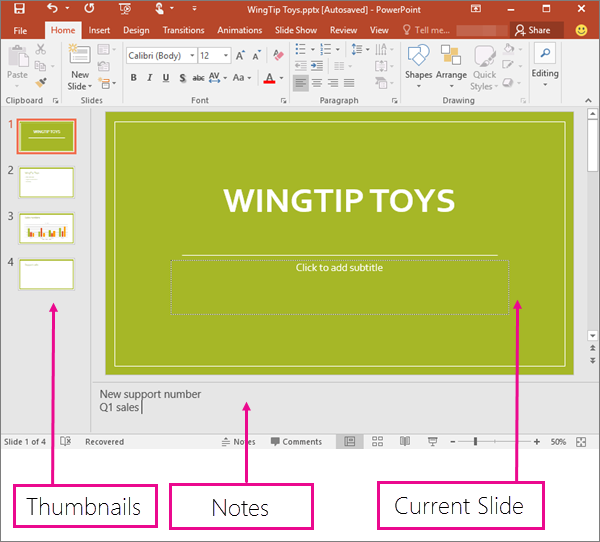
Slide Sorter view

Slide Sorter view (below) displays all the slides in your presentation in horizontally sequenced, thumbnails. Slide show view is helpful if you need to reorganize your slides—you can just click and drag your slides to a new location or add sections to organize your slides into meaningful groups.
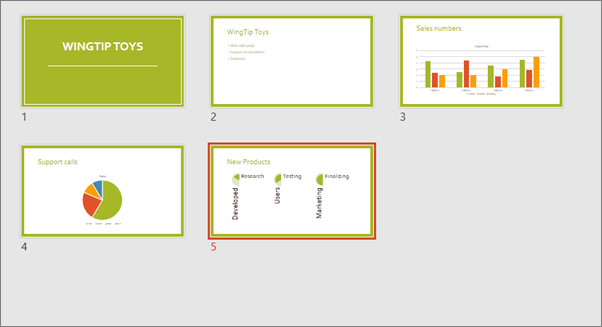
For more information about sections, see Organize your PowerPoint slides into sections .
Notes Page view

The Notes pane is located beneath the slide window. You can print your notes or include the notes in a presentation that you send to the audience, or just use them as cues for yourself while you're presenting.

For more information about notes, see Add speaker notes to your slides .
Outline view
You can get to Outline view from the View tab on the ribbon. (In PowerPoint 2013 and later, you can no longer get to Outline view from Normal view. You have to get to it from the View tab.)
Use Outline view to create an outline or story board for your presentation. It displays only the text on your slides, not pictures or other graphical items.
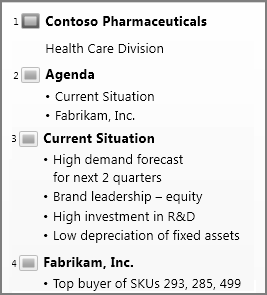
Master views
To get to a master view, on the View tab, in the Master Views group, choose the master view that you want.
Master views include Slide , Handout , and Notes . The key benefit to working in a master view is that you can make universal style changes to every slide, notes page, or handout associated with your presentation.
For more information about working with masters, see:
What is a slide master?
Use multiple slide masters in one presentation
Change, delete, or hide headers and footers on slides, notes, and handouts
Views for delivering and viewing a presentation
Slide show view.

Use Slide Show view to deliver your presentation to your audience. Slide Show view occupies the full computer screen, exactly the way your presentation will look on a big screen when your audience sees it.
Presenter view

Use Presenter view to view your notes while delivering your presentation. In Presenter view, your audience cannot see your notes.
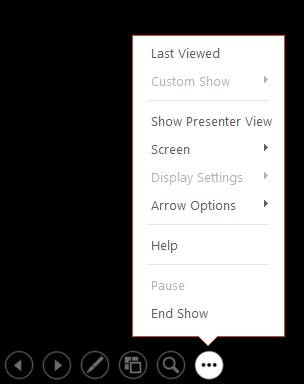
For more information about using Presenter view, see View your speaker notes as you deliver your slide show .
Reading view

Most people reviewing a PowerPoint presentation without a presenter will want to use Reading view. It displays the presentation in a full screen like Slide Show view, and it includes a few simple controls to make it easy to flip through the slides.
The views in PowerPoint that you can use to edit, print, and deliver your presentation are as follows:
Master views: Slide, Handout, and Notes
You can switch between PowerPoint views in two places:
Use the View menu to switch between any of the views

Access the three main views (Normal, Slide Sorter, or Slide Show) on the bottom bar of the PowerPoint window
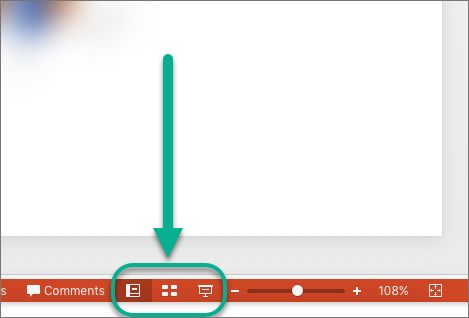
Views for creating or editing your presentation
Several views in PowerPoint can help you create a professional presentation.
Normal view Normal view is the main editing view, where you write and design your presentations. Normal view has three working areas:
Thumbnail pane
Slides pane
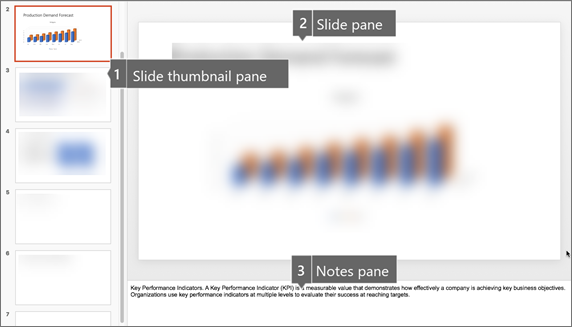
Slide Sorter view Slide Sorter view gives you a view of your slides in thumbnail form. This view makes it easy for you to sort and organize the sequence of your slides as you create your presentation, and then also as you prepare your presentation for printing. You can add sections in Slide Sorter view as well, and sort slides into different categories or sections.
Notes Page view The Notes pane is located under the Slide pane. You can type notes that apply to the current slide. Later, you can print your notes and refer to them when you give your presentation. You can also print notes to give to your audience or include the notes in a presentation that you send to the audience or post on a Web page.
Outline view (Introduced in PowerPoint 2016 for Mac) Outline view displays your presentation as an outline made up of the titles and main text from each slide. Each title appears on the left side of the pane that contains the Outline view, along with a slide icon and slide number. Working in Outline view is particularly handy if you want to make global edits, get an overview of your presentation, change the sequence of bullets or slides, or apply formatting changes.
Master views The master views include Slide, Handout, and Notes view. They are the main slides that store information about the presentation, including background, theme colors, theme fonts, theme effects, placeholder sizes, and positions. The key benefit to working in a master view is that on the slide master, notes master, or handout master, you can make universal style changes to every slide, notes page, or handout associated with your presentation. For more information about working with masters, see Modify a slide master .
Views for delivering your presentation
Slide Show view Use Slide Show view to deliver your presentation to your audience. In this view, your slides occupy the full computer screen.
Presenter view Presenter view helps you manage your slides while you present by tracking how much time has elapsed, which slide is next, and displaying notes that only you can see (while also allowing you to take meeting notes as you present).
Views for preparing and printing your presentation
To help you save paper and ink, you'll want to prepare your print job before you print. PowerPoint provides views and settings to help you specify what you want to print (slides, handouts, or notes pages) and how you want those jobs to print (in color, grayscale, black and white, with frames, and more).
Slide Sorter view Slide Sorter view gives you a view of your slides in thumbnail form. This view makes it easy for you to sort and organize the sequence of your slides as you prepare to print your slides.
Print Preview Print Preview lets you specify settings for what you want to print—handouts, notes pages, and outline, or slides.
Organize your slides into sections
Print your slides and handouts
Start the presentation and see your notes in Presenter view
In PowerPoint for the web, when your file is stored on OneDrive, the default view is Reading view. When your file is stored on OneDrive for work or school or SharePoint in Microsoft 365, the default view is Editing view.
View for creating your presentation
Editing view.
You can get to Editing View from the View tab or from the task bar at the bottom of the slide window.
Editing View is the editing mode where you’ll work most frequently to create your slides. Below, Editing View displays slide thumbnails on the left, a large window showing the current slide, and a Notes pane below the current slide where you can type speaker notes for that slide.
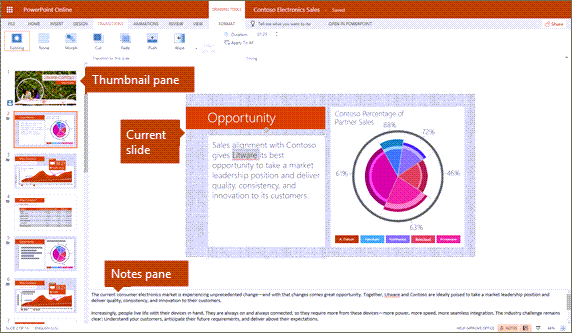
The slide sorter lets you see your slides on the screen in a grid that makes it easy to reorganize them, or organize them into sections, just by dragging and dropping them where you want them.

To add a section right click the first slide of your new section and select Add Section . See Organize your PowerPoint slides into sections for more information.

Views for delivering or viewing a presentation
Use Slide Show view to deliver your presentation to your audience. Slide Show view occupies the full computer screen, exactly the way your presentation looks on a big screen when your audience sees it.
Note: Reading View isn't available for PowerPoint for the web files stored in OneDrive for work or school/SharePoint in Microsoft 365.
Most people reviewing a PowerPoint presentation without a presenter will want to use Reading view. It displays the presentation in a full screen like Slide Show view, and it includes a few simple controls to make it easy to flip through the slides. You can also view speaker notes in Reading View.

Need more help?
Want more options.
Explore subscription benefits, browse training courses, learn how to secure your device, and more.

Microsoft 365 subscription benefits

Microsoft 365 training

Microsoft security

Accessibility center
Communities help you ask and answer questions, give feedback, and hear from experts with rich knowledge.

Ask the Microsoft Community

Microsoft Tech Community

Windows Insiders
Microsoft 365 Insiders
Was this information helpful?
Thank you for your feedback.

IMAGES
VIDEO
COMMENTS
On the Insert tab, select Shapes, and then, under Action Buttons at the bottom of the menu, click the button shape that you want to add. On the slide canvas, click drag to draw the shape for the button. Keep the Action Settings dialog box open and go to the next procedure.
Select the Copilot button in the Home tab of the ribbon. Enter your prompt or select Create presentation from file to create a first draft of your presentation using your theme or template. Copilot will replace your current presentation with a new one. If needed, save a copy first and rerun the steps above. If you already have a copy, confirm ...
Go to your Microsoft PowerPoint presentation and open the slide on which you want to create an action button. Here are three simple steps to add an action button to your slide: 1. Insert the Shape. Click on the slide where you want to insert the button. Go to the Insert tab, click Shapes, and then under Action Buttons at the bottom of the menu ...
Create a presentation. Open PowerPoint. In the left pane, select New. Select an option: To create a presentation from scratch, select Blank Presentation. To use a prepared design, select one of the templates. To see tips for using PowerPoint, select Take a Tour, and then select Create, . Add a slide.
Select the shape or image and go to the "Insert" tab. Click "Action" in the "Links" section of the ribbon. You'll see the "Action Settings" box open, allowing you to pick an action as described earlier. Again, you can choose between a "Mouse Click" or "Mouse Over" action using the tabs. You can also play a sound.
Click the OK button when you are done exploring this window. Go back to the Shapes button on the Insert menu and once again locate the Action Buttons section at the bottom of the menu. This time, select the button with the arrow pointing to the left. Just as before, place the button on your slide and PowerPoint will open the Actions Settings ...
Create a new presentation with a template from the PowerPoint template gallery. ⌘+Shift+P. Insert a new slide. ⌘+Shift+N. Go to the next slide. Page down. Go to the previous slide. Page up. Format slide background. ⌘+Shift+2. Zoom out. ⌘+Minus sign (-) Zoom in. ⌘+Plus sign (+) Zoom to fit. ⌘+Option+O. Make a copy of the selected ...
In this video, you'll learn the basics of working with action buttons in PowerPoint 2019, PowerPoint 2016, and Office 365. Visit https://edu.gcfglobal.org/en...
Step 1. Start by opening a new presentation! From the Google Slides homepage, look to the top left and click the Blank button to open a new presentation. This is your blank slate from which to create an outstanding interactive presentation! Step 2.
Go to the View tab of the PowerPoint ribbon and click on Slide Master. In the left navigation pane, scroll up and select the first slide. Switch to the Insert tab, choose an action button from the Shapes Gallery, add it to the slide, and define the settings in the dialog box. Move to the Slide Master tab again and click Close Master View.
Step 2: Edit and format a presentation. You can add, edit, or format text, images, or videos in a presentation. Insert and arrange text, shapes, and lines; Add, delete & organize slides; Add animations to a slide; Step 3: Share & work with others. You can share files and folders with people and choose whether they can view, edit, or comment on ...
Click New. Choose Blank Presentation. Using a Keyboard Shortcut. Press CTRL+N. From the Quick Access Toolbar (QAT) Click the New button on the Quick Access Toolbar. Design Ideas. When we create a new presentation, the Design Ideas pane will show on the right-hand side. The Design Ideas feature examines the contents of the selected slide and ...
Click on the New Slide button located on the Home tab in the Slides group. The new slide should appear below the selected slide. If you want to add a new slide between two, select the first of the two slides and click New Slide. Notice the New Slide button contains a New Slide button arrow. Click on the arrow to view different slide layouts.
When you first create a presentation, it has just one slide, which is useful only for the shortest presentations. Fortunately, PowerPoint gives you about 50 ways to add new slides to your presentation. You see only three of them here: On the Home tab, click the New Slide button in the Slides group, as shown. Press Ctrl+M.
Create a new presentation. Open PowerPoint. Select Blank presentation, or select one of the themes. Select More themes to view the gallery and search for more. Add a slide. Select the slide you want your new slide to follow. Select Home > New Slide. Select Layout and the you type want from the drop-down.
New slide shortcut (2 of 2) Ctrl + Enter. This is a unique little shortcut. While working in the normal PowerPoint view, hitting CTRL + ENTER cycles through the content placeholders in your layout allowing you to quickly type text or add content. Once it cycles through all the available shortcuts in your layout, hitting the shortcut again adds ...
Create New Document: Link to a new presentation. E-mail Address: Link to an email ID. Choose the option you need, and your hyperlink will be ready. How to Use Action Buttons in PowerPoint . Here's how you can use action buttons in PowerPoint. Go to the Insert tab in the ribbon. Click on Shapes and scroll all the way down till you see Action ...
If necessary, choose File > New to display the New Presentation pane. On the New Presentation pane, click on the From Design Template link. The Slide Design pane will display on the right side of the screen with a variety of different templates to choose from. Select the design of your choice from the Slide Design pane.
3. Click Insert. This tab is in the top-left side of your Mac's screen. 4. Click New Slide. It's in the drop-down menu below the Insert tab. Doing so will insert a new slide into the PowerPoint presentation. If you decide to reposition your slide, you can click and drag it up or down in the sidebar to do so. Method 2.
To insert a new slide in PowerPoint with a "Title and Content" slide layout, click the "Home" tab in the Ribbon. Then click the "New Slide" button in the "Slides" button group. Alternatively, to insert a new slide with a different slide layout, click the "Home" tab in the Ribbon. Then click the drop-down part of the "New ...
Creating a New Presentation with Copilot. Copilot can help you churn out a new presentation on any topic quickly. Open a blank presentation in PowerPoint and click the 'Copilot' button from the Home ribbon. The Copilot panel will open on the right. Click on 'Create a presentation' to load it into the prompt area and enter your topic in the prompt.
In Microsoft Accessory Center, select Microsoft Presenter+ > Presentation controls. On the next screen, select what you want the Back or Next button to do for that specific action. (Optional) If you select Keystroke, on the Keystroke screen, press the keyboard shortcut you want to use when you press and hold the Back or Next button.
New Copilot+ PCs from the biggest brands available starting June 18: Acer: Acer's Swift 14 AI 2.5K touchscreen enables you to draw and edit your vision with greater accuracy and with color-accurate imagery. Launch and discover AI-enhanced features, like Acer PurifiedVoice 2.0 and Purified View, with a touch of the dedicated AcerSense button.
"Our nation needs a new foundation to get badly needed new transmission planned, paid for and built. With this new rule, that starts today." The grid rule adopts specific requirements for transmission providers to conduct long-term planning for regional transmission facilities and determine how to pay for them. It reflects tens of thousands ...
Views for creating your presentation Normal view. You can get to Normal view from the task bar at the bottom of the slide window, or from the View tab on the ribbon.. Normal view is the editing mode where you'll work most frequently to create your slides. Below, Normal view displays slide thumbnails on the left, a large window showing the current slide, and a section below the current slide ...